

19 Essential Scotland Travel Tips to Read Before Your First Visit
If you are a frequent traveler and an English speaker, visiting Scotland is pretty easy (although driving in Scotland can still be a little hair-raising.) However, if you are a bit nervous about your trip and want to make sure you have all your ducks in a row, be sure to read these Scotland travel tips before you go!
I have visited Scotland twice, once on a solo trip to Edinburgh and another as a Scotland road trip with friends (thank you Keryn for being an awesome driver!) and I’ve learned and experienced so much that I want to share with anyone planning their first trip to Scotland.
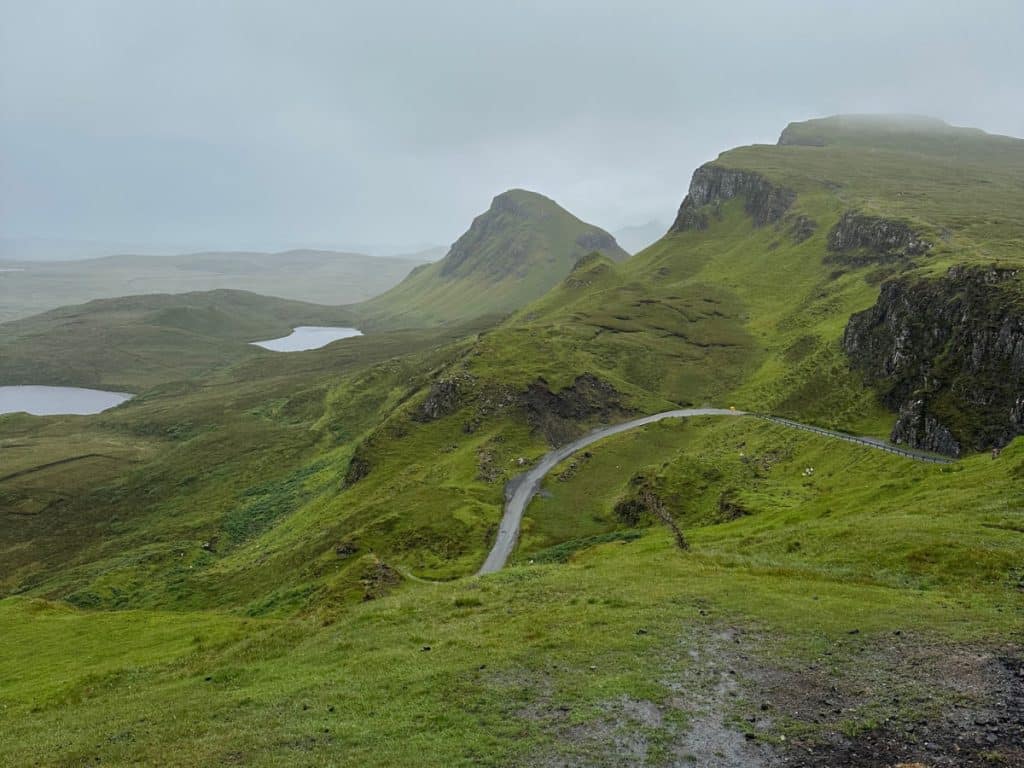
My Top Scotland Travel Tips
Note: This post contains affiliate links. If you click a link and make a purchase, I may receive a small commission at no cost to you.
Language
English is the official language in the United Kingdom and the dominant language in Scotland. There are still those that speak Scots in the Lowlands or Scottish Gaelic in the Highlands, but getting around Scotland is no problem for English speakers — although you may need to listen closely to understand those with a heavy Scottish accent.
As part of the United Kingdom, Scotland uses the British Pound (£). Scotland actually has its own pound notes but you can use English bills as well.
Almost all restaurants, shops, and parking machines take chip-enabled credit cards and/or digital payments such as Apple Pay. However, you will need coins for some parking machines and coins or small bills for tips or small purchases. I’d recommend either requesting small bills from your local bank before you leave or visiting an ATM when you arrive.
If you are wondering how much money you need, be sure to read my post on how much a Scotland trip costs .
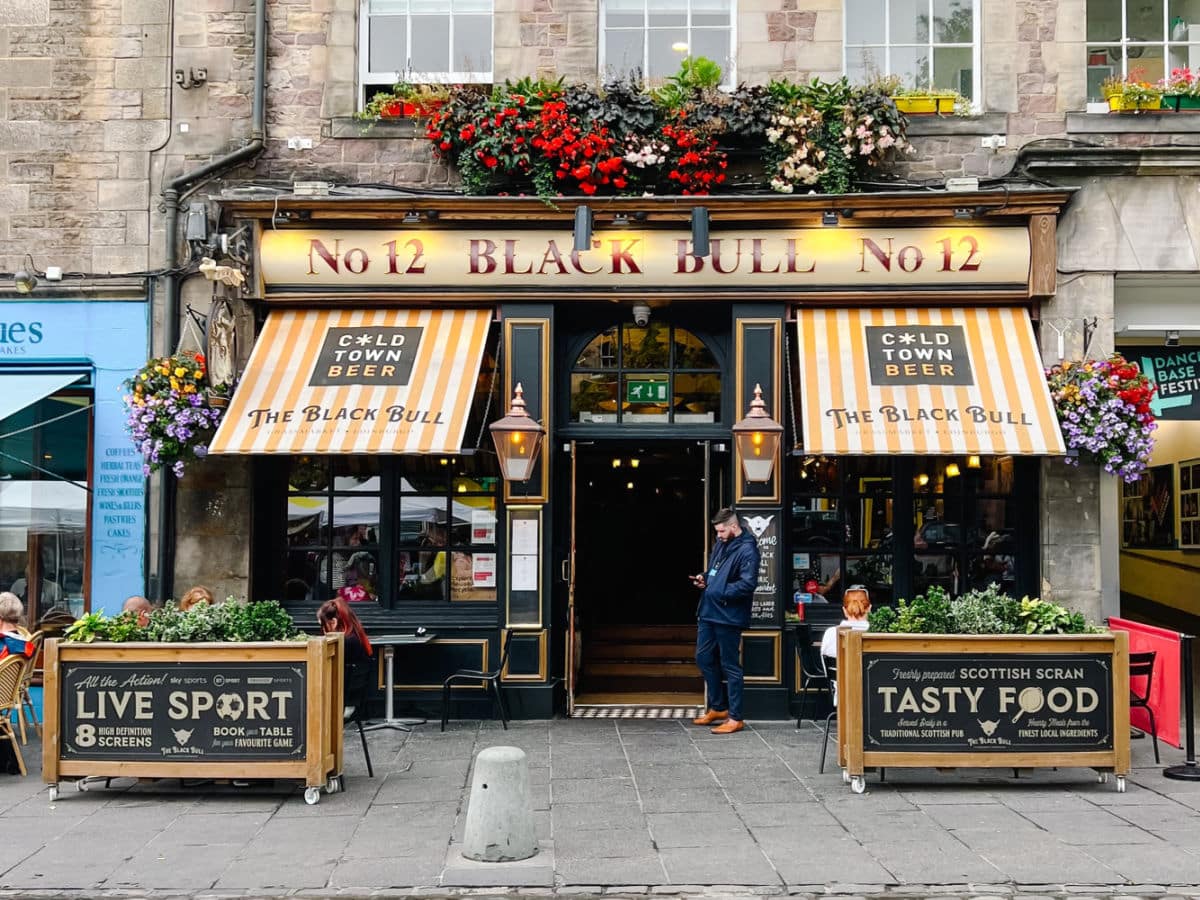
Tipping is not the same as in the U.S.. In many instances, service is included at restaurants. If you are paying by card and want to leave a tip, you need to let the server know to add it before you tap your card. For sit-down restaurants, a 10-15 percent gratuity is appropriate but not necessary. At casual cafes, you can leave a few coins or round up your bill.
Scotland uses 230 voltage and you will need a three-pronged adapter with a G-type plug, which is different from most of Europe. If your appliance or device has a dual voltage power supply (which you can usually check by looking on the label or manual), you only need a plug adapter. Dual voltage devices can automatically switch between 120V and 230V.
However, if your device does not have a dual voltage power supply, you will need a voltage converter. It’s important to choose a voltage converter that is powerful enough for your device. The wattage of your device will be listed on the label.
Car Rentals
If you plan on renting a car, be sure to book months or weeks in advance for better pricing and availability, especially if you want a car with an automatic transmission. Try to book the smallest car that will fit your luggage and one that has a back up camera. I’d also suggest getting full insurance. I typically use Auto Europe to compare rates from different vendors. International driving permits are NOT required in Scotland. You can drive on your domestic license for up to one year.
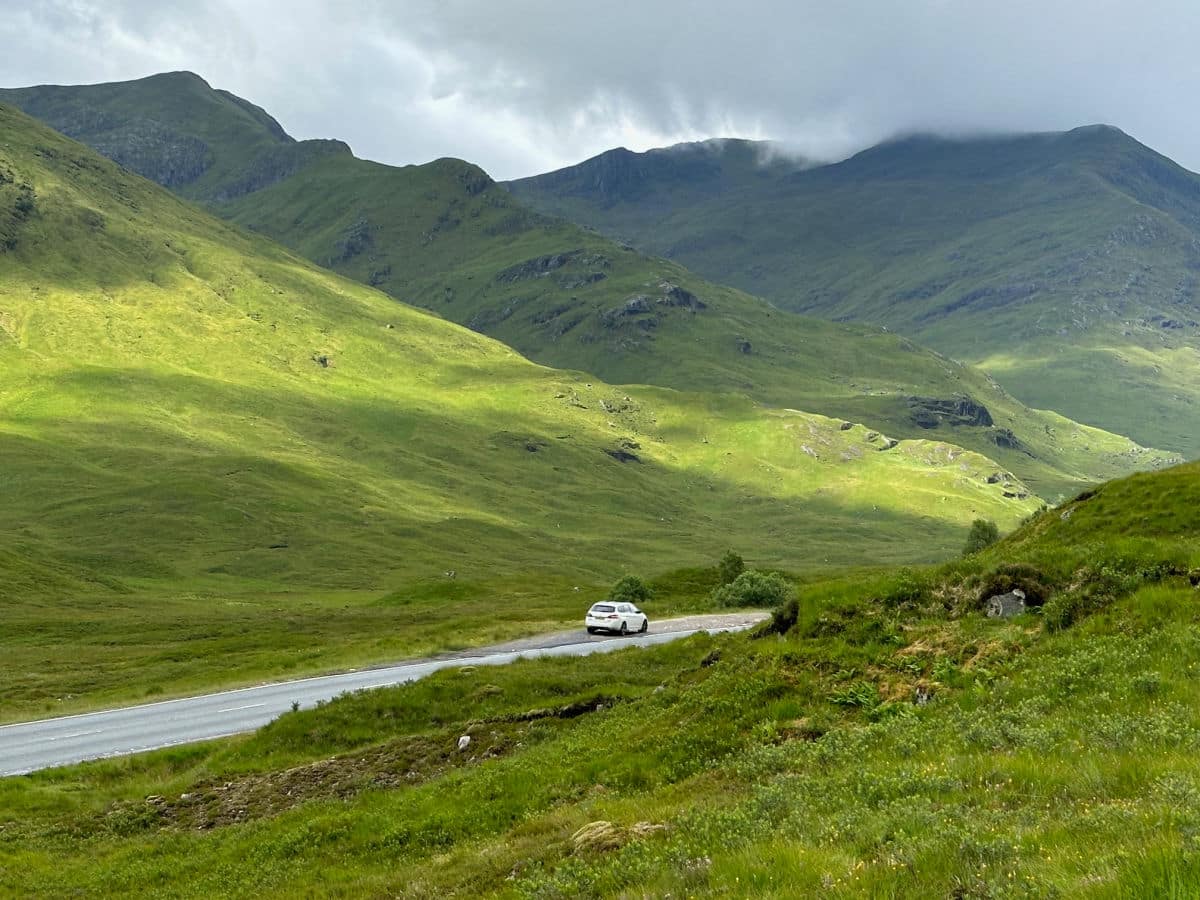
Driving in Scotland
In the United Kingdom, including Scotland, cars drive on the left-hand side of the road. If you are not familiar with driving on the left, it takes close concentration and focus, especially when navigating the country’s many rotaries. Remember to “stay left, look right.” Traffic already on the roundabout has priority, so give way to vehicles approaching from your right. Enter when there’s a safe gap, and indicate your intended exit as you approach it.
Outside of the highways, many interior roads in the Highlands or islands are single lane roads. When you encounter a car coming the other way, one of you needs to pull into the closest pull out designed for passing. This may require backing up to the closest pull out.
Remember to keep an eye out for wildlife, especially sheep, that tend to wander into the roads in the backcountry.
Be sure to follow all the local laws, including speed limits to avoid fines. Scotland has strict drink-driving laws with a lower alcohol limit than many other countries so don’t risk it.
You will need to pay for parking at most car parks for attractions and towns, including trailheads for popular hikes or natural attractions. I’d recommend taking a photo of your license plate as often you will need to enter this into the parking meter machine when paying for parking. In other instances, you will need to “pay and display”, which means pay for your parking in advance based on how much time you think you will need and then place the receipt in your windshield window.
Most parking meters take credit cards but there are some that will only accept coins so it makes sense to carry coins with you or keep some in the car. Just don’t try to use one receipt from one parking area at another, even if you are still within the original time window. Each receipt is marked with a lot number and they will check (trust me, I learned the hard way and parking tickets are expensive!)
When you are in the Highlands or the Islands, petrol stations are few and far between so be sure to fuel up when you can and don’t push it too low.
Public Toilets
You can typically find public toilets at popular tourist attractions (even natural attractions such as the Fairy Pools.) However, some of these are pay toilets. This is another reason to carry some coins, although many of these are also tap and go using digital payments. But just because these are paid, doesn’t mean they are well-supplied or exceptionally clean. So carry some extra tissue and sanitizer just in case.
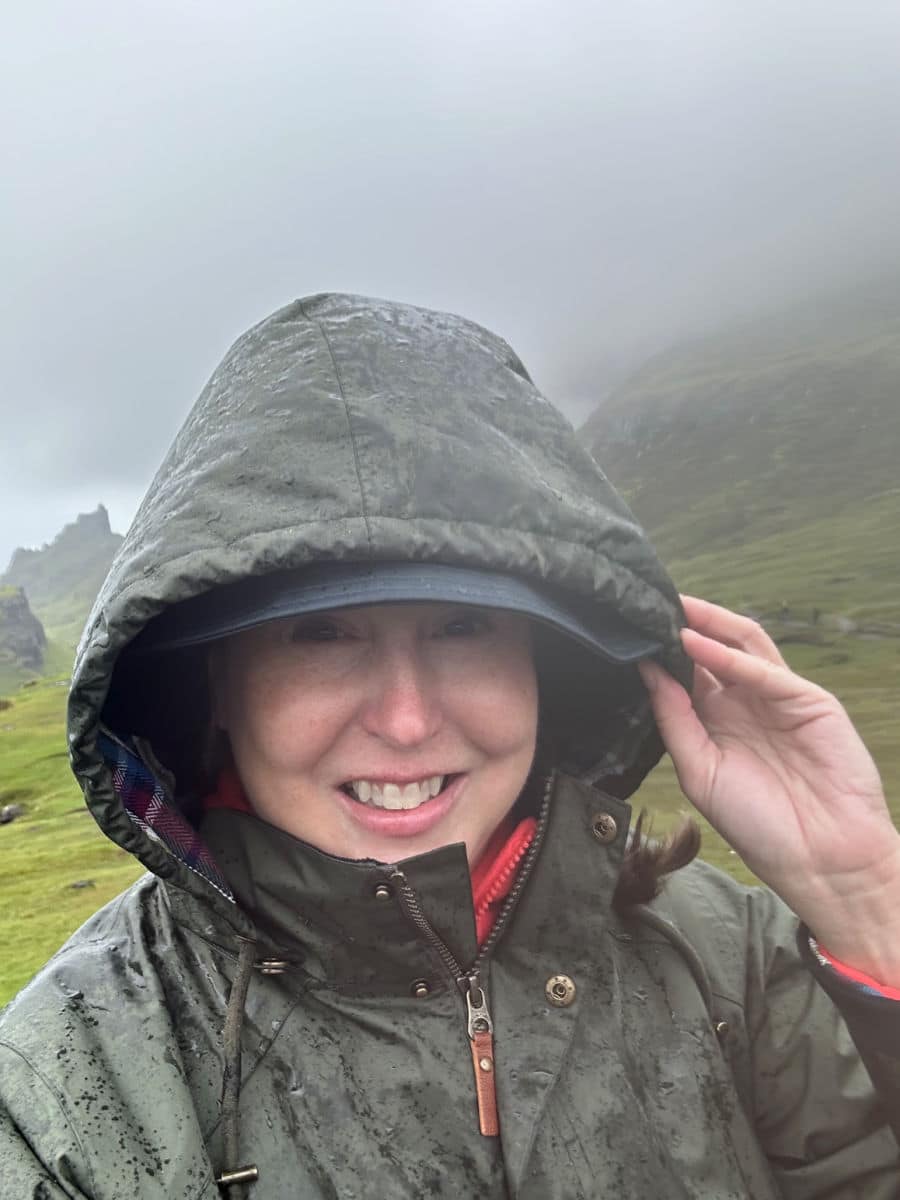
When in Scotland, you need to be prepared for all sorts of weather no matter when you visit. During the summer months, the average temperatures are a high of 59-63°F (15-17°C) and lows are between 47-52°F (8-11°C).
In the winter, temperatures drop to 41-45°F (5-7°C) with lows of 32-37°F (0-3°C). Keep in mind that Scotland has a wet and cool climate, with a fair amount of wind. The rainiest months are in the winter with an average rainfall around 4 inches per month.
While regional variations exist, coastal areas are generally warmer and less rainy than inland regions and The Highlands experience slightly lower temperatures and higher rainfall than the Lowlands.
As I wrote about in my Scotland packing list , you need to be prepared when traveling to Ireland. Wind and water proof clothing including a rain coat, rain pants, and waterproof shoes. It is very important to dress in layers. Don’t forget the basics including a hat, gloves, sunglasses, and an umbrella.

Hotel Reservations
Outside of the cities, the accommodations in towns and smaller cities such as Inverness, accommodations can be limited. It is important to book hotel rooms or vacation rentals at least a few months in advance. This is especially true in popular spots like the Isle of Skye. (See my Scotland road trip itinerary to get recommendations on where to stay.)
Restaurant Reservations
In popular destinations such as Inverness, Isle of Skye, or Glencoe, it is also important to make dinner reservations and keep an eye on the hours and days places are open as many restaurants close by 8:00 p.m. in smaller towns.
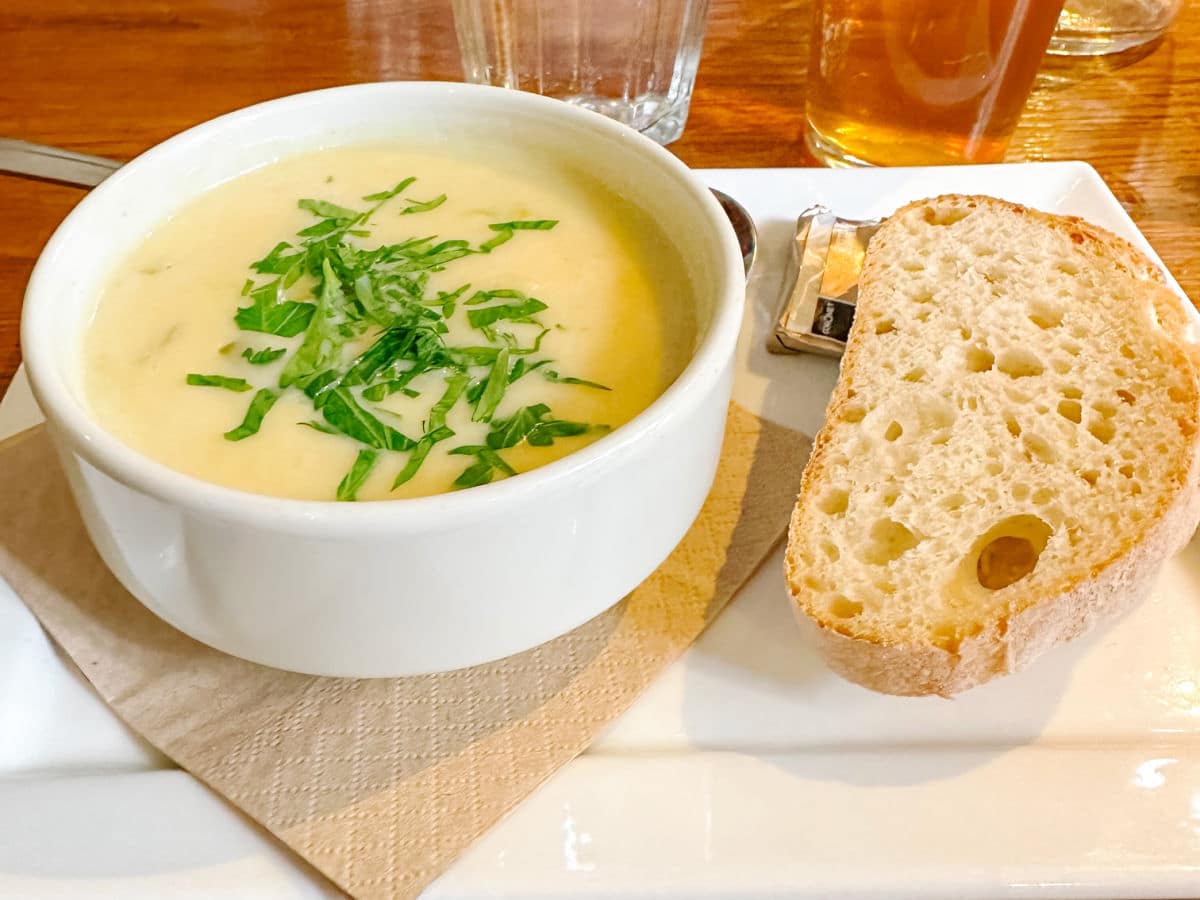
While in Scotland, be sure to try some Scottish specialties such as:
Haggis, Neeps and Tatties: The iconic national dish of Scotland, haggis is a savory sausage traditionally made from sheep’s heart, liver, lungs, and oatmeal, encased in the sheep’s stomach lining. Served with mashed turnips (“neeps”) and potatoes (“tatties”), it’s a hearty and flavorful way to experience Scottish culinary heritage. It took me a while to try this specialty but I ended up liking it because it tastes much more of the spices used in creating it than the meat itself.
Cullen Skink: Originating from Cullen on the Moray Firth, this a warn, creamy soup made with smoked haddock, potatoes, onions, and milk, and typically served with crusty bread for dipping. This is a must-try in coastal areas, especially around Moray and Aberdeenshire, but I had a delicious version in Glasgow.
Scotch Pies: Savory pastries filled with minced meat and onions, Scotch pies are a popular handheld snack or lunch option. The filling can vary from classic minced beef to adventurous varieties like venison or chicken balmoral.
Shortbread: A crumbly, melt-in-your-mouth biscuit made with butter, sugar, and flour, shortbread is a Scottish sweet treat synonymous with tea time. Enjoy plain shortbread for its pure deliciousness, or find versions infused with flavors like chocolate, ginger, or even whisky. I’m a big fan of the millionaires shortbread, which is layered with caramel and chocolate.
Sticky Toffee Pudding: Sticky toffee pudding is a gooey dessert consisting of a light and moist sponge cake, often infused with dates or ginger, nestled in a rich, sticky toffee sauce. It’s typically served warm with a dollop of vanilla ice cream or whipped cream. While the origins of sticky toffee pudding are disputed, Scotland has a strong claim to fame, thanks to the Udny Arms Hotel in Aberdeenshire. They boast of creating the iconic dessert back in the 1960s.
Fish and Chips: While the dish may not have originated in Scotland, their contribution to its evolution and continued popularity is undeniable. Fish and chips are a staple of Scottish cuisine and culture, just as much as they are in the rest of the UK.
Deep-Fried Mars Bars: I was really shocked when I asked locals about famous foods and they told me about deep-fried Mars bars that are battered and deep-fried until golden and enjoyed after the pub.
Scotch Whisky: The undisputed king of Scottish drinks, whisky (not called Scotch in Scotland) is steeped in history and tradition. With its distinct smoky flavor and wide variety of regional styles, it’s a must-try for any visitor. Explore peaty Islay drams, floral Highland expressions, or Speyside’s fruity whiskies. Just remember that whiskey spelled with an -ey refers to Irish whiskey.
Irn-Bru: This bright orange carbonated beverage is often called Scotland’s “other national drink.” Its unique flavor is hard to describe but I found it something of a cross between orange soda and bubble gum. Bottom line, it is excessively sweet.
Scottish Gin: Scotland’s gin scene is booming, with distilleries across the country creating unique and flavorful expressions. Expect botanical notes inspired by the Scottish landscape, like juniper, heather, and berries. My friend Keryn came back with at least a dozen little bottles to sample the various flavors!
Ferries
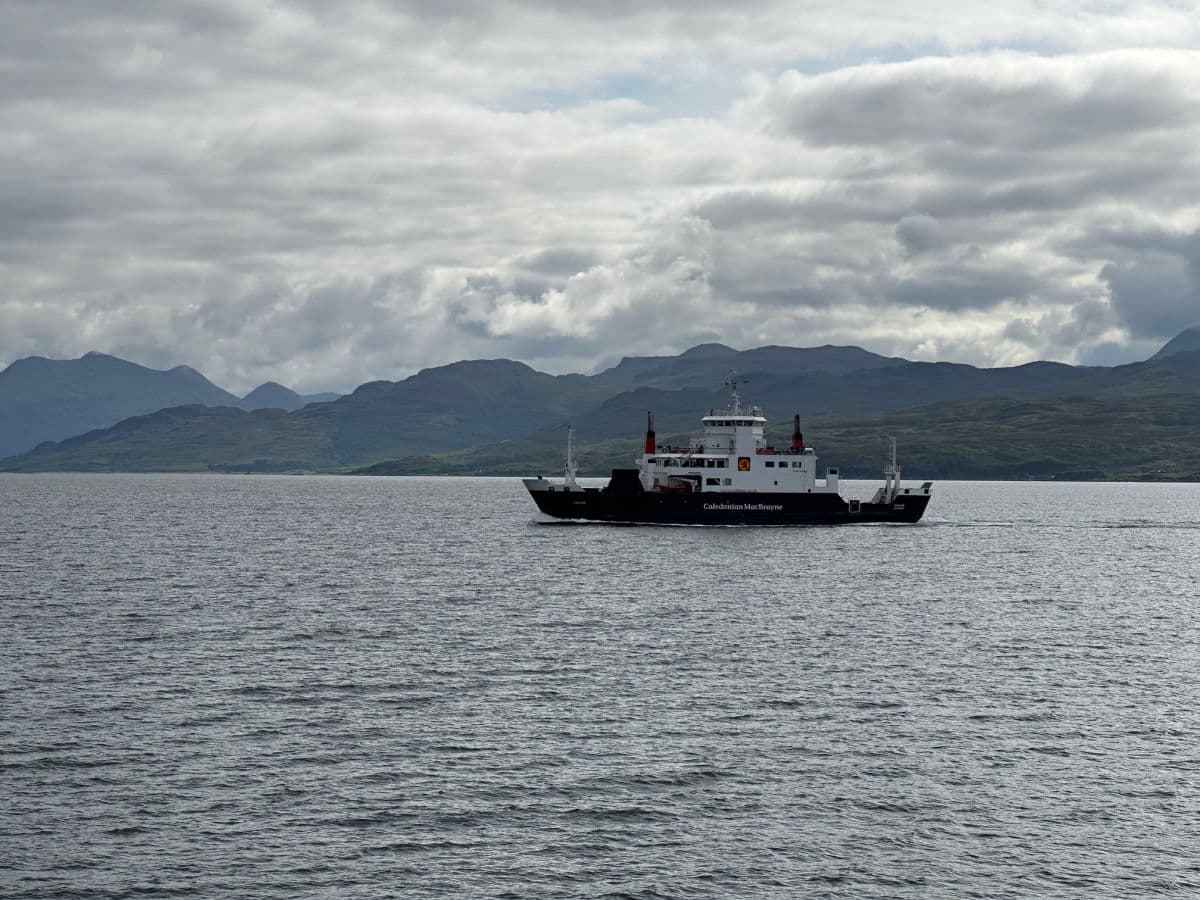
If you plan on visiting any of the islands by car and want to take a ferry, you will need to book a timed ticket in advance.
Attractions
Some attractions such as the Royal Tattoo, Edinburgh Castle tickets, or popular tours can sell out in the busy season so you should book your tickets in advance. As I mentioned in my Edinburgh itinerary, I would also suggest going to popular attractions such as the Edinburgh Castle early in the morning when it first opens.
Best Time to Visit
The most popular time to visit Scotland is during July and August, especially during festivals such as the Fringe Festival, events like the Royal Edinburgh Military Tattoo, the Highland Games, and Ceilidh at the Castle with live traditional music and dancing in Edinburgh Castle.
In terms of weather, June brings pleasant temperatures and long daylight hours (when I was there in late June/early July the sun didn’t set until nearly 11:00 p.m.. September is still warm enough (it was actually quite warm the year I was there in early September), and you will also find beautiful autumn foliage and fewer crowds than peak summer.
May offers springtime charm with blooming flowers, pleasant weather, and no midges (tiny biting insects!). Not as sunny as summer, but less crowded.
Know Some History
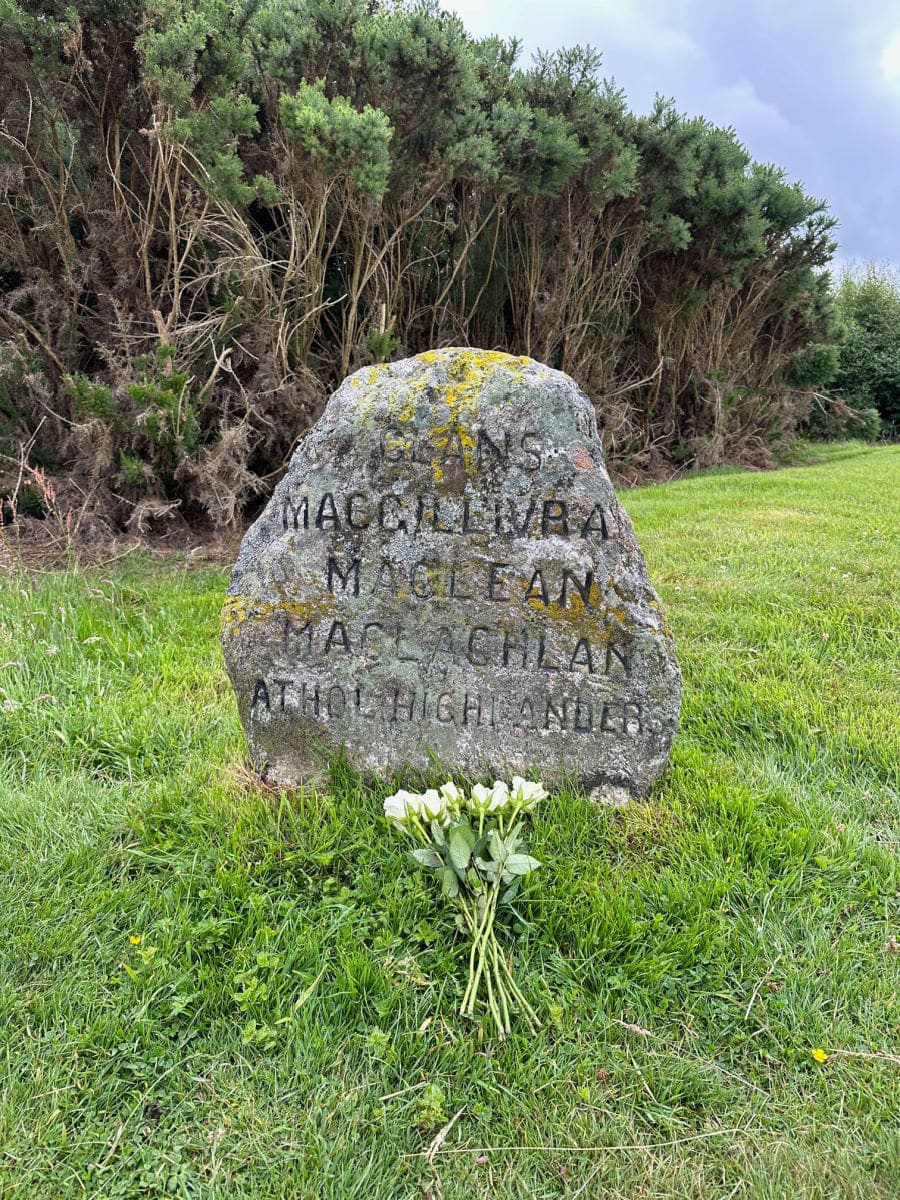
When you are visiting castles and historic sites such as the Culloden Battlefield , it helps to know some basic Scottish history. I was really surprised to see how front of mind what seems like distant history can still be, such as a friendship with the French that goes back to old alliances with France against the English.
To brush up on your Scottish history before you visit, here are some books, movies, and shows you may want to enjoy.
Things to Watch:
- Braveheart (1995): While not historically accurate, it’s a classic epic film depicting the life of William Wallace, a Scottish rebel leader, and gives insight into the Scottish Wars of Independence in the 13th century.
- Outlaw King (2018): A more grounded portrayal of Robert the Bruce, another key figure in Scotland’s fight for independence from English rule.
- Mary Queen of Scots (2018): Explores the tumultuous reign and rivalry between Mary, Queen of Scots, and Queen Elizabeth I of England, shedding light on complex political and religious tensions of the 16th century.
- Rob Roy (1995): A fictionalized but entertaining account of the life of Rob Roy MacGregor, a Scottish clan chief and folk hero in the 18th century.
- Outlander (2014-present): This popular TV series follows a 20th-century nurse who travels back in time to 1743 Scotland, immersing viewers in the Jacobite rebellion and Highland life.
- Monarch of the Glen (2000-2005): A charming drama about a family running a deer farm in the Scottish Highlands, showcasing the beauty of the landscape and rural traditions.
- Secrets of the Clans (2008-2010): Explores the history and traditions of various Scottish clans.
- Wild Scotland (2014): Stunning natural history documentary capturing the breathtaking landscapes and wildlife of Scotland.
Things to Read:
- Outlander by Diana Gabaldon: A sprawling series blending romance, time travel, and historical intrigue in 18th-century Scotland during the Jacobite rebellion.
- Wolf of the North by William McIlvanney: A gritty portrayal of Viking-era Scotland through the eyes of a warrior battling for survival against invaders and internal power struggles.
- The Flame Bearer by Kathleen Winsor: A sweeping historical saga following the Bruce family and their fight for Scottish independence from England.
- Redcoats by Neil Oliver: A thrilling account of the Battle of Culloden from the perspective of both Highland fighters and British soldiers.
- Sunset Song by Lewis Grassic Gibbon: A poignant and tragic novel depicting the harsh realities of rural life in 19th-century Scotland, focusing on a woman’s struggles and resilience.
- The Last Summer by Karen Swan : In 1930, the residents of small St. Kilda are relocated to mainland Scotland.
Save this to Pinterest
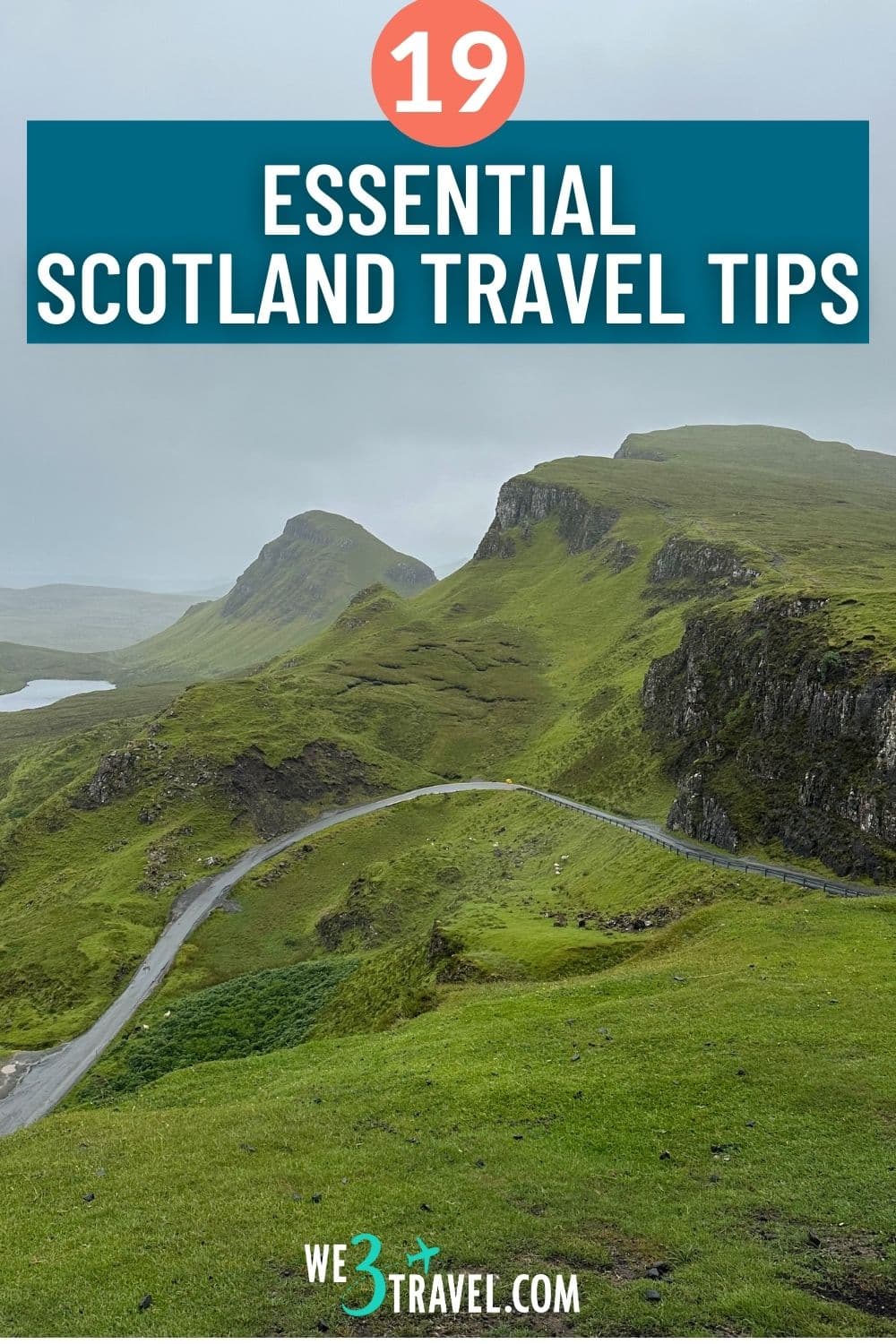
Tamara Gruber is the Founder and Publisher of We3Travel. A former marketing executive and travel advisor, Tamara is an award-winning travel writer and recognized expert in family travel. Tamara is a member of SATW and the Adventure Travel Trade Association, and serves on the Board of the Family Travel Association. She is also the publisher of YourTimetoFly.com and the co-host of the Vacation Mavens travel podcast.
Find this useful? Share it!
Publish Date: January 18, 2024

SIGN UP FOR OUR NEWSLETTER & RECEIVE A FAMILY VACATION PLANNING KIT!
We3Travel.com will use the information you provide on this form to send you newsletters. You can unsubscribe at any time by clicking the link in the footer of any email you receive from us, or by contacting [email protected] . By clicking below, you agree that we may process your information in accordance with these terms.

Start typing and press enter to search

37 Scotland Travel Tips for First Timers & Must Knows Before You Go
Last Updated: October 19, 2023
*FYI - this post may contain affiliate links, which means we earn a commission at no extra cost to you if you purchase from them. Also, as an Amazon Associate I earn from qualifying purchases. Check out our Privacy Policy and Disclosure. for more info.
Scotland is one of those countries that has the world in a permanent chokehold. With idyllic lochs and glens, soaring Munros, vibrant cities, and absurdly charming accents… it’s hard to believe sometimes that this country is real.
But real it is my friends, and somehow, it’s even better when you get to see it all in person.
Unlike other places in the world where reality pales in comparison to the filtered photos, Scotland is somehow more magical, more captivating, and more charming than photos can convey… so long as you prepare properly.
I recently spent a month in Scotland, mainly for festival season in Edinburgh and there were a lot of silly things I had to learn the hard way. Turns out Scotland, while amazing, can have a few traps and easy mistakes that first timers fall into.
So, in this post, I’ll be sharing the Scotland travel tips I wish I had before my first visit. I hope you find them helpful!

Save this list of Scotland Travel Tips for later!
You’ll be very glad you did.
1. Know the difference between Scotland, England, the UK & Great Britain
Alright, let’s kickstart this list of Scotland travel tips with a simple but very important distinction: the difference between Scotland, England, the UK & Great Britain.
While I’d like to think not too many people use them interchangeably, here’s what you need to know: Scotland is located in the northern portion of the island of Great Britain .
It is part of the United Kingdom but it’s culturally very distinct from other parts of the UK, like England, Wales & Northern Ireland.
So, keep in mind that when you go to Scotland, you’re experiencing Scottish culture and hearing Scottish accents – don’t call them English or refer to their accents as “British”.
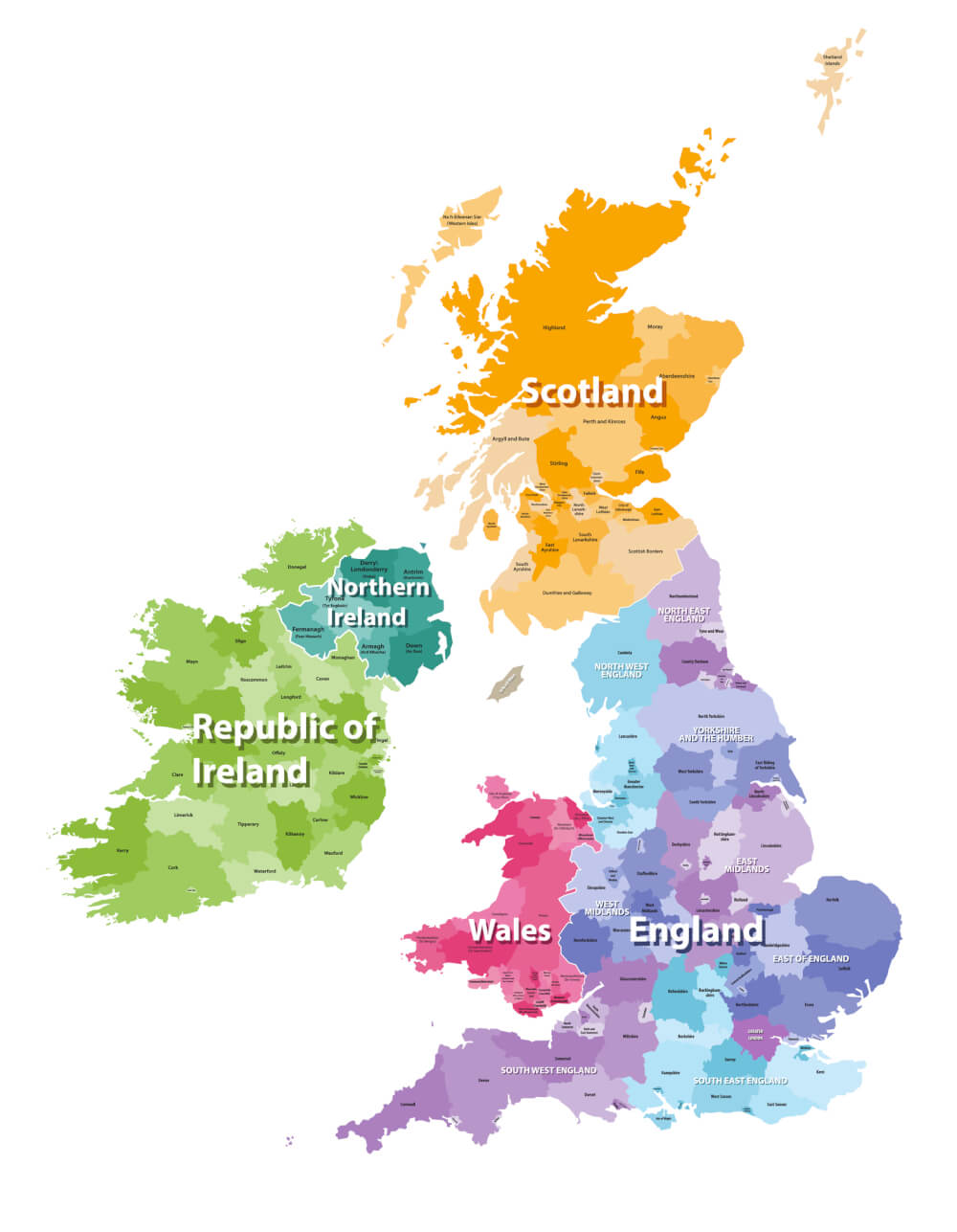
2. Familiarize yourself with Scotland’s airports
When planning your grand arrival into bonny Scotland, you should know that there are five international airports in Scotland:
- Aberdeen International Airport
- Edinburgh Airport
- Glasgow International Airport
- Glasgow Prestwick Airport (AKA just Prestwick Airport)
- Inverness Airport
For most visitors from overseas, Edinburgh Airport is the most common point of entry and is well connected to the city by public transport like buses and trams.
NOTE: While its flights are limited, Glasgow Prestwick is the only airport in Scotland that’s directly connected to the country’s rail network, but all the other airports are well served by other forms of public transport like buses and trams.

3. Create a mixed itinerary to make the most of all Scotland has to offer
Now in terms of where to go, believe me when I say that there is SO much to see in Scotland that one trip, even fifty trips, wouldn’t be enough.
So, to make the most of your time, I’d suggest mixing things up and combining both city and nature travel, as well as famous and offbeat sights to get a varied taste of what makes Scotland so special.
While most first time visitors will usually visit some combination of Edinburgh, Glasgow & the Highlands, that’s just a tiny portion of the country, which the official tourism authority divides into over a dozen different regions.
So, be sure to look beyond the most famous areas to create a well-rounded trip you’ll never forget. Ever.

… So how can you find places more off the beaten path? Well, here are some ideas…
4. Prioritize exploring one area thoroughly vs. trying to cover too much ground
If your goal is to combine both iconic sights with more offbeat finds, then I would recommend picking a smaller area of Scotland to cover for your trip, rather than trying to cover too much ground.
The truth is there are loads of ultra famous places in Scotland like the Isle of Skye or Loch Ness, but if you do your research, you’ll likely be able to find many alternatives for famous islands, lochs or castles closer to your chosen base. Loch Ness for instance is literally only one of over 30,000 lochs.
So sticking to a small area will not only save money but also help you find hidden gems of your own.
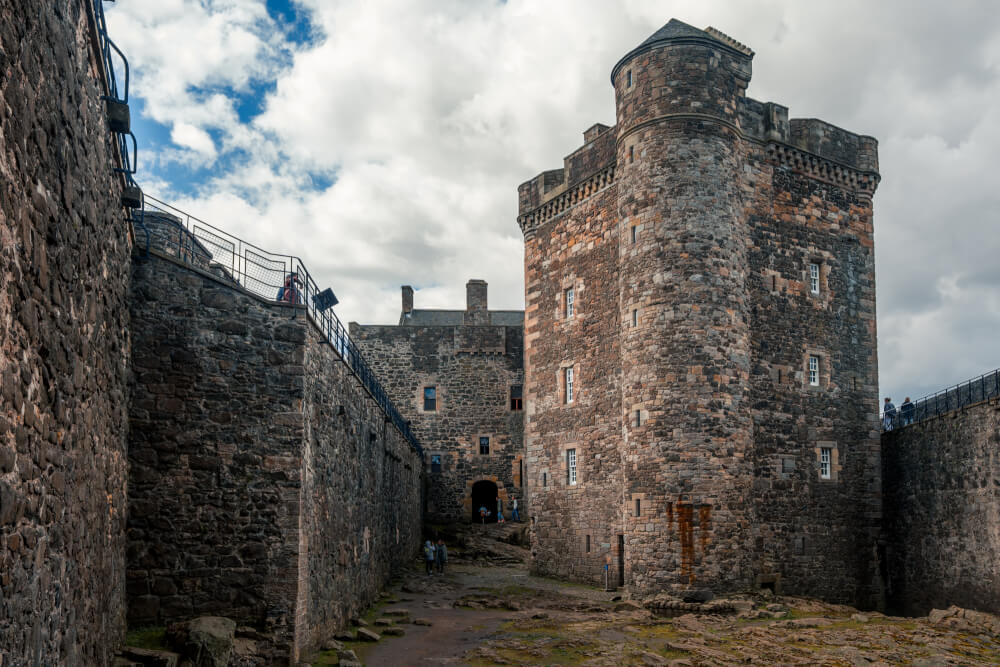
5. Get inspiration from local Scottish content creators
I would also recommend consuming content from creators based in Scotland because they’re way more likely to have covered offbeat places compared to bloggers who come for a week or two, or even a month like me.
(I mean give me time to catch up… I’m working on it!)
In the meantime, until I can empty my savings and drool reservoir in the foolish pursuit of ‘completing Scotland’, here are some Scotland-based creators I can recommend:
- Watch Me See
- Wayfaring Kiwi
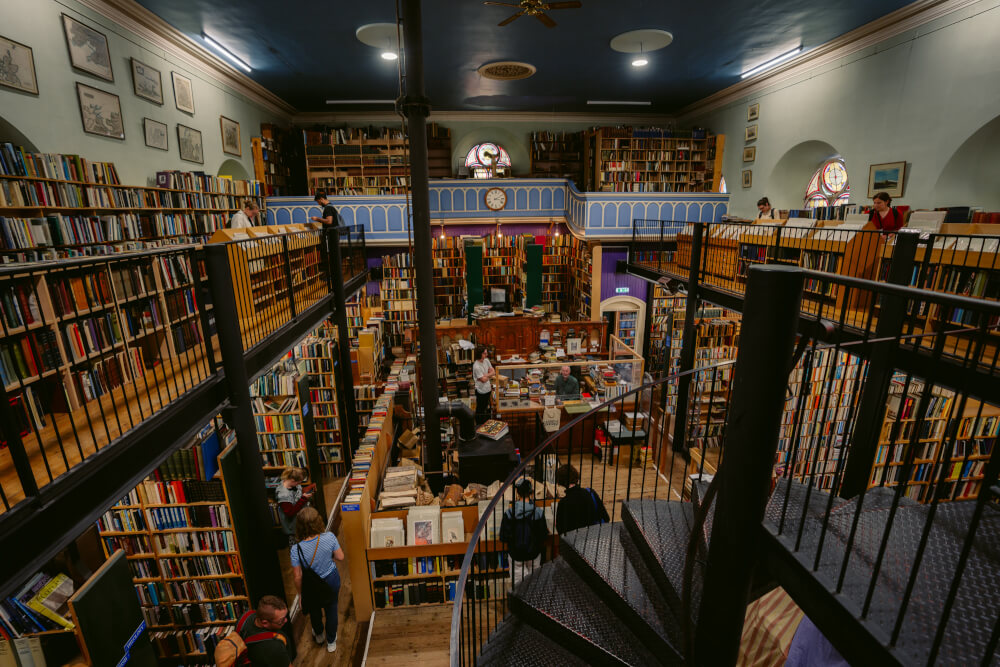
6. Rent a car if you want to explore in-depth
While public transport with trains and buses is pretty good between and within cities in Scotland, you will definitely need a car if you want to explore Scotland’s nature & countryside in-depth.
There are some seriously gorgeous road trips in Scotland like the…
- North Coast 500
- The North East 250
- And many many more
Plus having a car will just allow you to see a lot more on your own schedule, so if independence is important to you, then car rental is a must.
And I say this from experience! My boyfriend and I didn’t have a car during our month in Scotland because we stayed primarily in Edinburgh, and while we were still able to see a lot through booking day tours, this of course restricted us to some of the best known and most visited places in Scotland.
Granted, we still had a wonderful time, but there was no shaking the shameless tourist vibe, so if you’re someone who likes to explore more offbeat places, then you’ll definitely need a car for that.
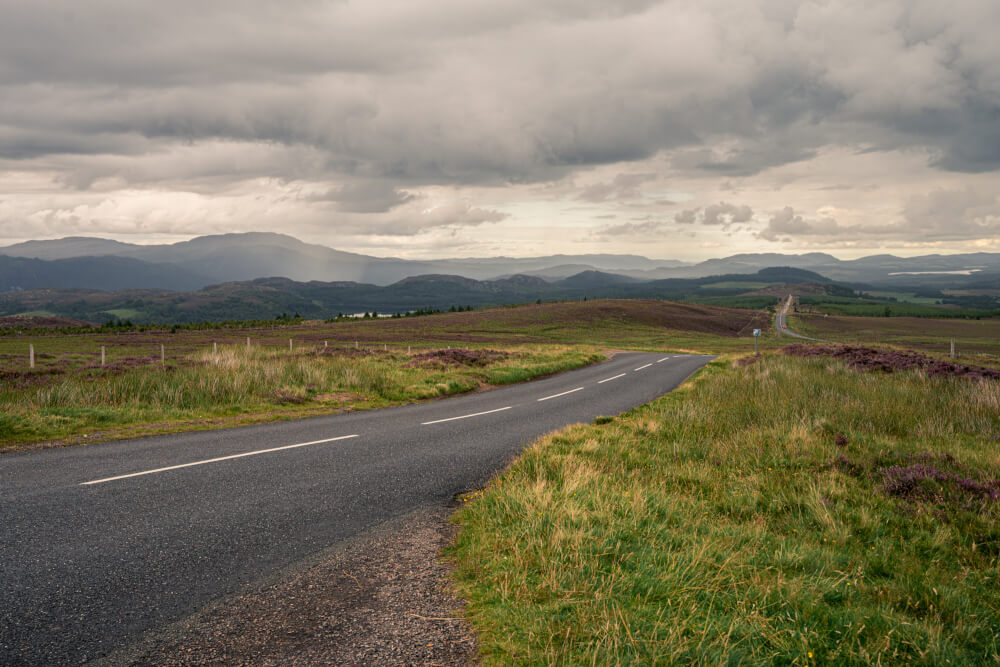
If you do rent a car though…
7. Prepare yourself for driving in Scotland
Apart from driving on the left side, roads can be quite narrow and regulations may be different to what you’re used to at home.
The legal alcohol limit for instance is stricter than elsewhere in the UK, which catches a lot of people off guard if they just want to have a beer with lunch, so be sure to read up on all the rules before you go rather than assuming.
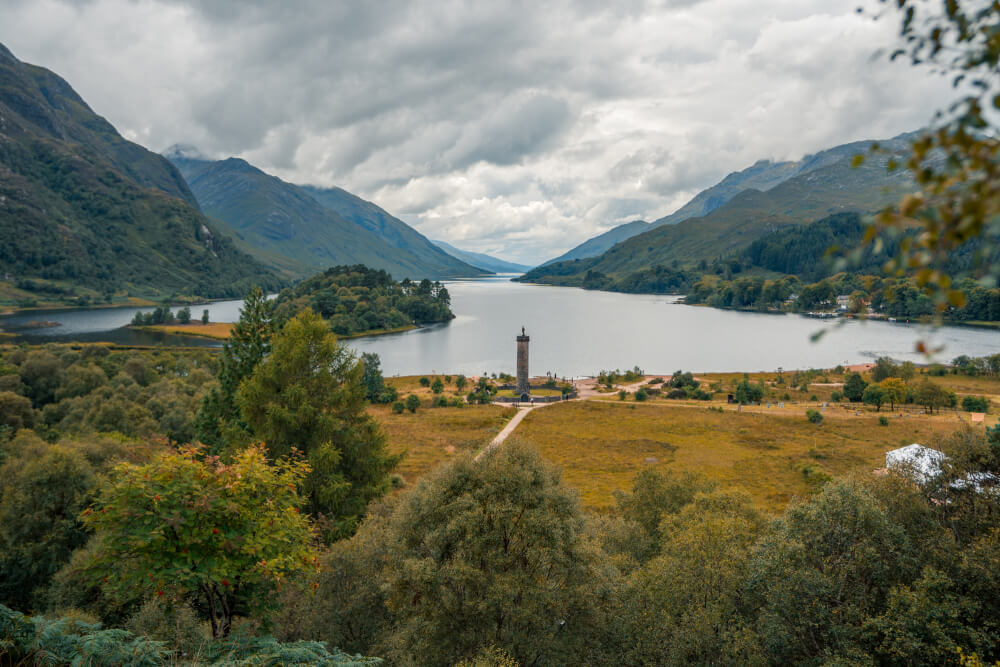
8. Plan for (or around) Scotland’s peak seasons
In terms of when to go, know that peak season is definitely summer, especially August in and around Edinburgh, when the entire city come alive with festival season. ( Read my Edinburgh travel tips too if you’re headed that way!)
There’s also other fun summer events like Highland Games across the country, as well as some very popular winter festivals as well, including Hogmanay, the country’s very famous New Year’s celebrations.
This is why you should book as far in advance as possible for peak periods like summer and Christmas if you want to experience some of these cultural events… or plan to visit in off/shoulder seasons if you want to get away from the crowds.

9. Book ahead whenever possible
In any case, booking ahead for accommodation is always a good idea in Scotland.
A lot of popular tourist places like Inverness are relatively small and don’t have that many hotels compared to larger cities, so booking in advance is your best defense against eye-gouging prices.
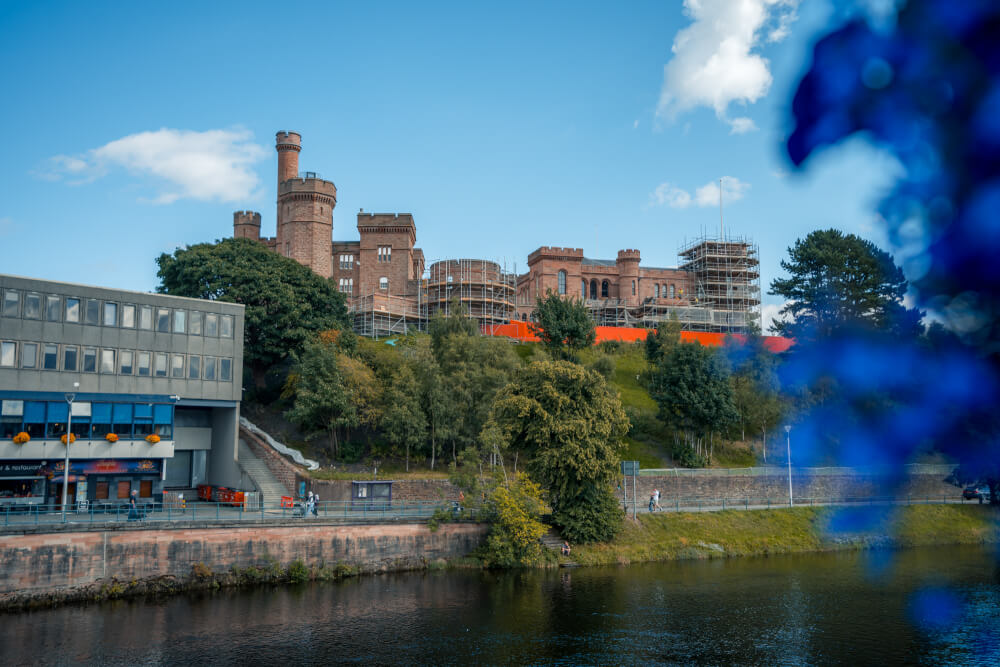
10. Take note that there’s freedom to roam
Now, this is a Scotland travel tip that you’re not likely to use as an average tourist, but just to throw this out there, if you enjoy camping or just wandering out to new places with reckless abandon, Scotland is an excellent place for it thanks to their rules around ‘freedom to roam’ (AKA right to roam).
Thanks to the Land Reform (Scotland) Act of 2003, Scotland has this principle known as freedom to roam, which gives people the right to access most land and inland water for (non-motorised) recreational activities, with main exceptions being common sense areas like private gardens and fields with crops.
So, if you want to get out there and really experience Scotland’s nature, go for it!

11. Get a travel-friendly credit card before your trip
As I mentioned in my England travel tips post, these days, contactless card payments are increasingly common across the UK, with many public transport systems relying on them, and even some establishments becoming card-only.
The same is true in Scotland, so if you don’t have a travel-friendly credit card already (meaning one that minimizes fees abroad) then I’d recommend getting one.
I used my Wise card pretty much everyday and never had any issues. They’re my go-to for simple travel-friendly cards, plus your card is sent to you for free so there’s really no downsides.
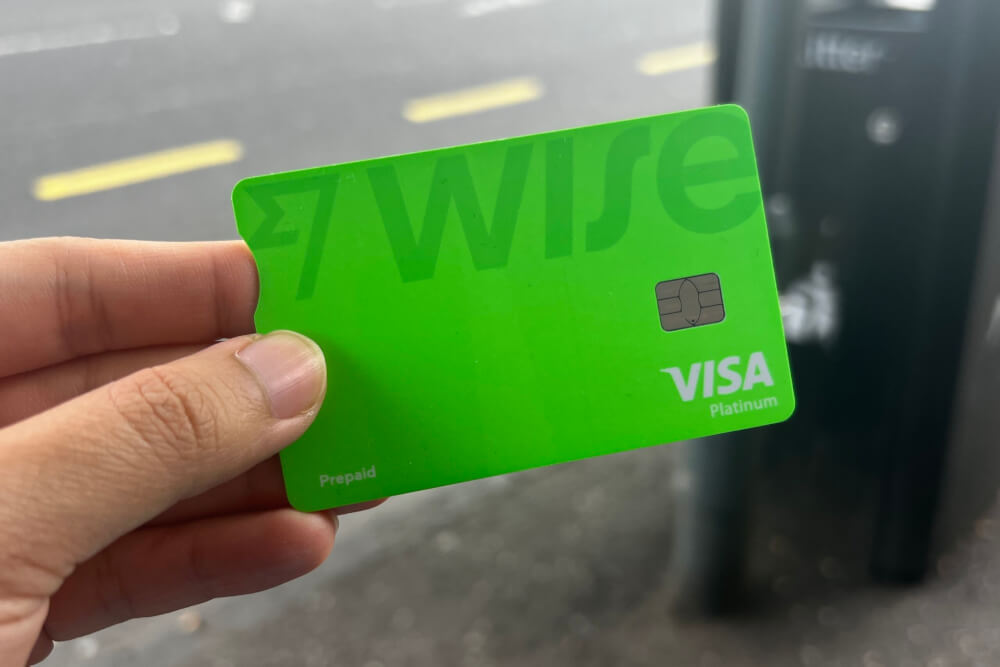
12. Be sure to try local Scottish delicacies
Alright, with that shiny new card in hand, it’s time to spend it on some tasty Scottish fare.
Here are some iconic Scottish dishes to fuel you through your sightseeing rampage through Scotland:
- Haggis: A famous dish that requires no introduction – keep an open mind and try it before you Google it. I actually think it’s pretty good! It’s usually served with neeps and tatties, which are mashed turnip and mashed potato
- Cullen skink: A creamy fish soup, usually served with some bread
- Chicken tikka masala : Marinated chicken in a spiced tomato-based sauce. Fun fact, it’s considered a national dish of the UK, which some credit to a chef in Glasgow
- Shortbread: THE buttery cookie beloved across the world!
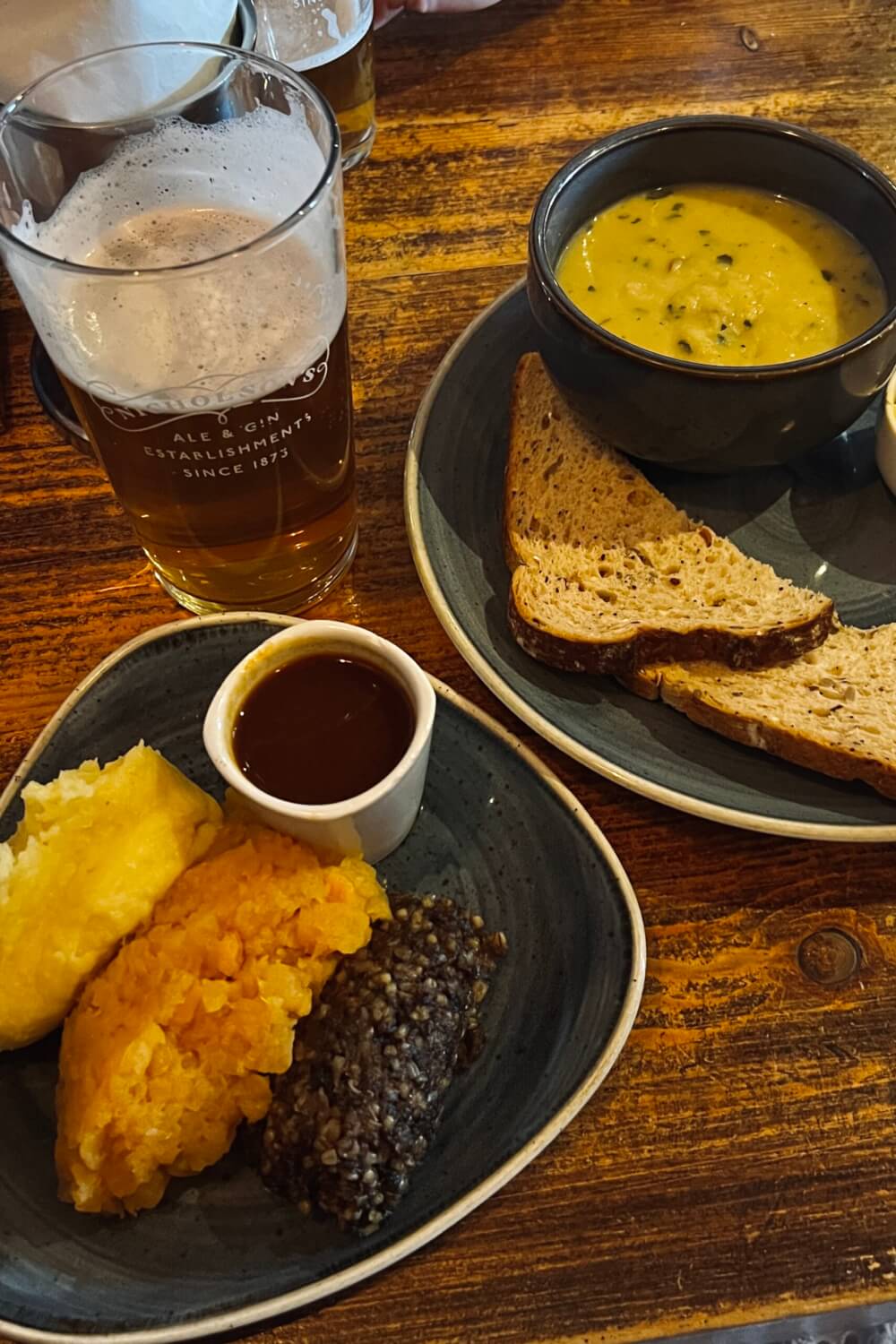
And if you want to try something more gluttonous, Scottish chippies are pretty famous for their ability to fry anything , from pizza to Mars Bars.
Many takeaway places also do munchie boxes which involve tons of (usually deep fried) fast food thrown into a box. Maybe good to try just once, for the sake of your arteries.
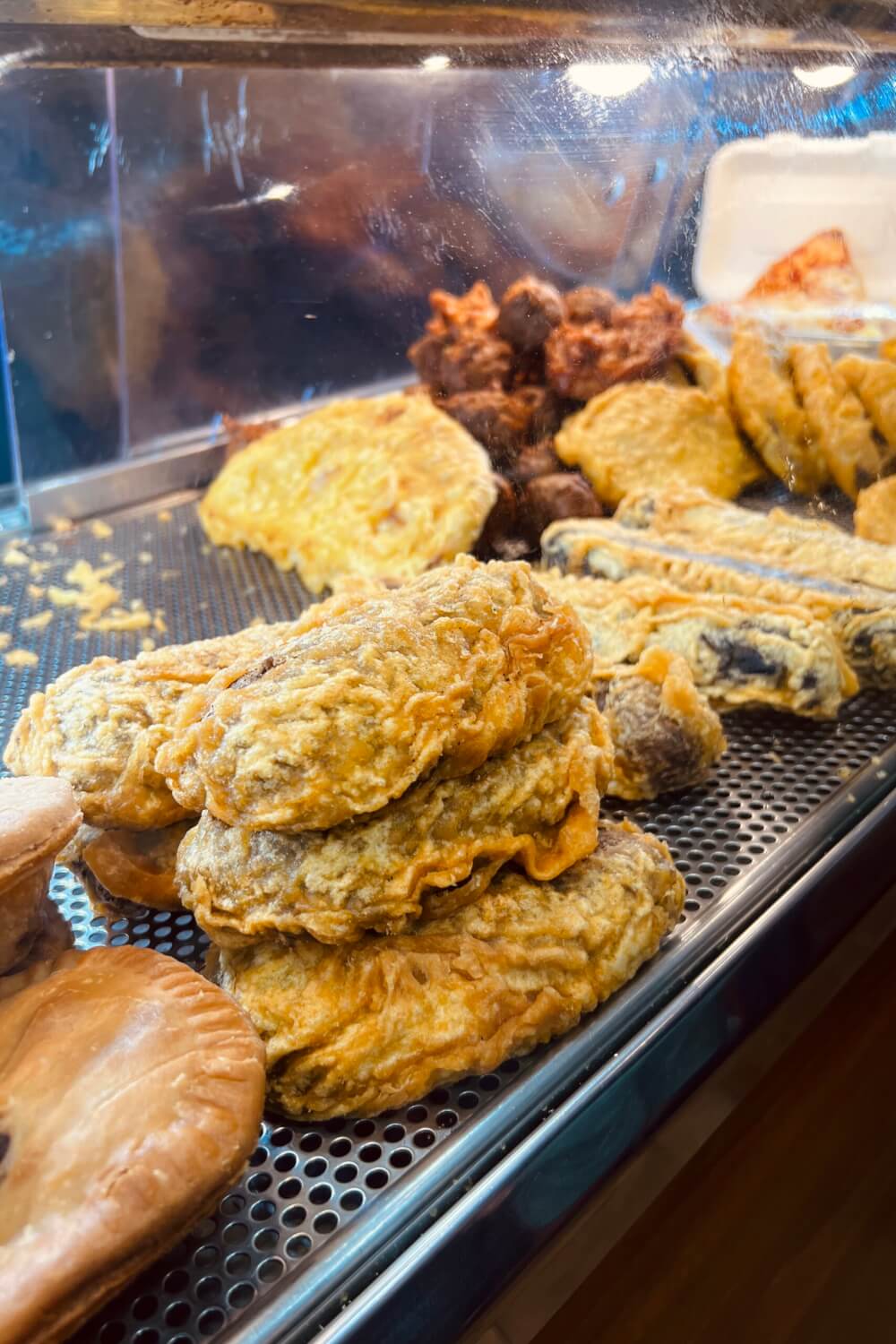
13. Make food bookings in advance
Now, in terms of restaurants, it might be smart to book in advance, especially during peak season.
This is especially true in smaller places like Inverness where there aren’t a ton of options. Luckily, these days, most food spots have fairly simple booking systems online when you search them up on Google Maps. For more old school restaurants, email or phone bookings also work well.
In any case, if you have your heart set on a particular place, make sure to book ahead whenever you’re able to.
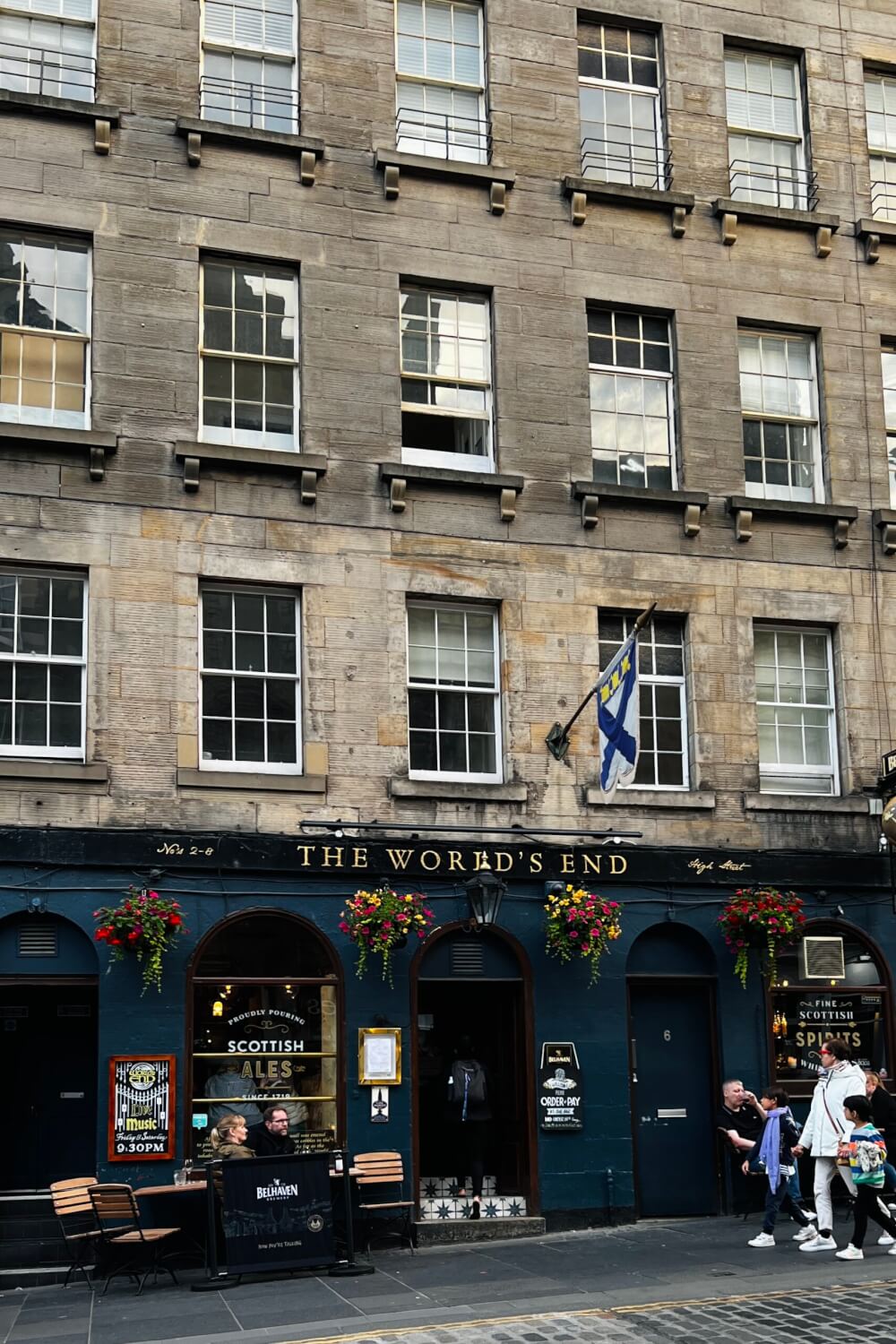
14. Try whisky, but know the ground rules
Now another important tip when in Scotland is to try whisky.
… I mean duh. Of course you will! In the name of culture.
I do have to share some ground rules I learned the hard way though, so remember the following:
- Call it a whisky not a scotch
- Be sure to order it as a dram of whiskey, not a shot
- Remember whisky should be sipped slowly and savoured, not just quickly knocked back
And if you’re overwhelmed with the selection which is inevitable, a good trick is to just ask the bartender for a recommendation… BUT do give them some general guidance on your preferences otherwise it’s as ridiculous a question as asking “can you recommend me a food?”
Generally, some taste profiles that go into whisky include smokiness, fruitiness, nuttiness, peatiness and how floral it is. So be prepared with your preferences so they can guide you to the right recommendation.
NOTE: It goes without saying, only ask for recommendations when it’s not super busy. If you’re at a pub and they’re up to their eyeballs in orders, that’s generally not the time to ask for their whisky insights.
Lastly, this is unlikely to come up as a tourist, but be mindful that whisky in Scotland is spelled without the e. This is a mistake I made a lot! Whiskey with an e is more often used to describe Irish whiskey and we don’t talk about her here.

15. Book a whisky experience if you can
Now if you’re into whisky or new to it, one fun Scotland tip is touring a distillery or doing a whisky experience at some point.
Whisky is a drink that’s easier to appreciate when you know more about it, which is why I’d recommend booking some kind of tour or experience that teaches you about whisky and how to appreciate it, rather than just a standard tasting.
There’s over 100 whisky distilleries to choose from, many of which offer tours. It’s shamelessly touristy but one of the best things to do in Edinburgh (IMO) is the new Johnnie Walker experience in Edinburgh . I thought it was SO much fun, and super informative for a newbie.
Just be warned: you will definitely walk out of there a brainwashed Johnnie Walker convert. I definitely hoarded a few bottles at Duty-Free…

That said, be sure to…
16. Try gin and other tipples in Scotland too
I was really pleasantly surprised during my month in Scotland to see that gin is a pretty big deal, with 70% of the UK’s gin produced here.
The craft beer scene is also growing rapidly, so be sure to diversify your booze portfolio beyond just whisky.
… All in the name of culture, of course.

17. Be sure to try a glug of IRN BRU
One of my favourite fun facts is that Scotland is one of the very few places in the world where Coca Cola isn’t the best selling soft drink. The unlikely national hero? IRN BRU – a bright orange soda with a flavour that’s really hard to describe…
It is considered one of THE most quintessentially Scottish things though so be sure to try it while you’re in Scotland!
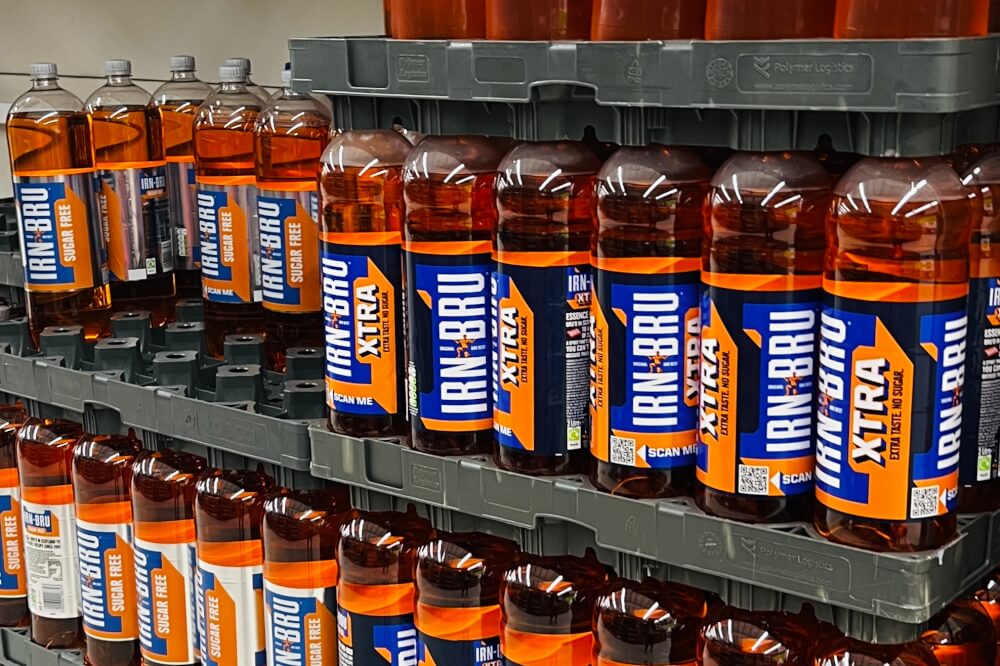
18. Take advantage of meal deals for budget-friendly feeds
Now, dining out all the time in Scotland can quickly add up to budget-destroying levels, so a good solution if you’re just on the go is heading to a supermarket to get some picnic foods, or in a pinch, trying an almighty Meal Deal.
Meal Deals are a staple of UK chains that allows you to grab a main, a snack and a drink for less than £5. Some chains now require you to sign up for a free loyalty card (eg Tesco Clubcard) to unlock the best deals though, so be mindful of that and do it in advance if you think the savings would be worth it.
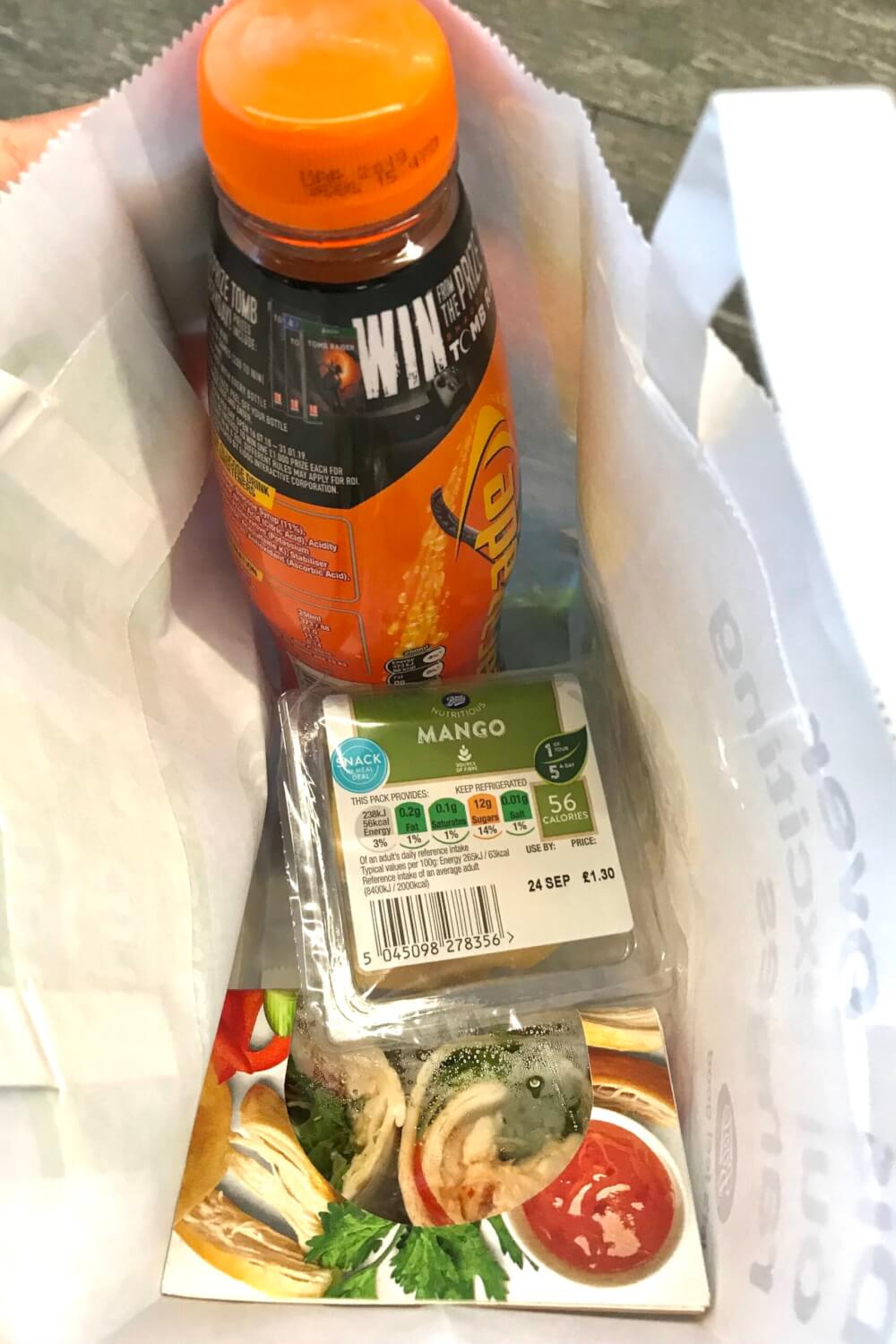
19. Beware of seagulls
Random but wildly important Scotland tip: if you find yourself dining outdoors at any point, DO be mindful that sneaky seagulls may be lurking nearby, ready to snap your food away in seconds.
… You’ve been warned.
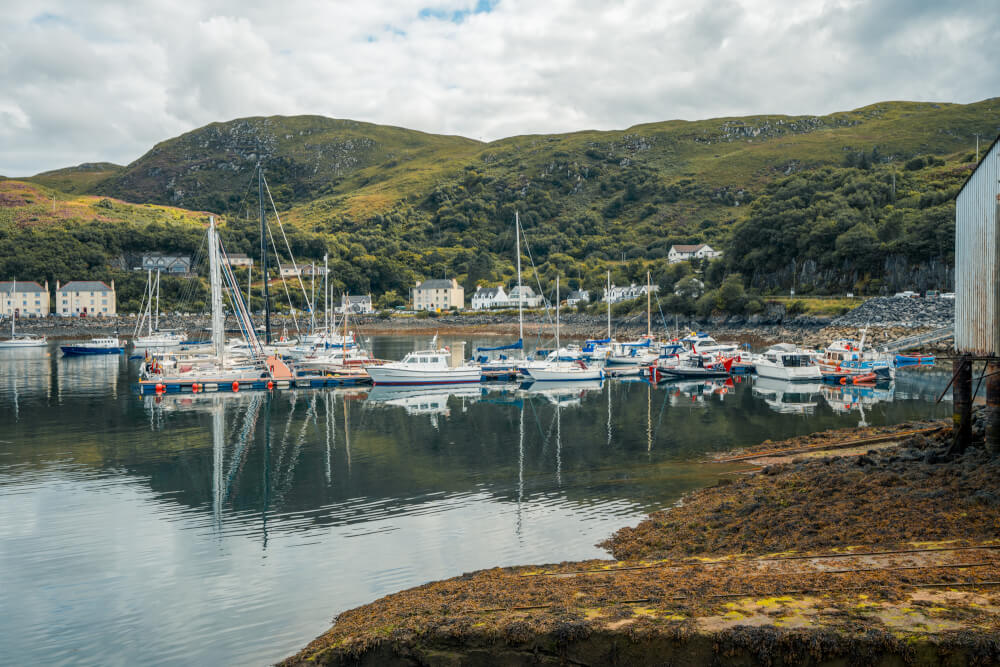
20. Don’t assume that all of Scotland is kilts and bagpipes
Now, moving over to Scotland culture & etiquette tips, I want to remind you that Scotland is more than just its stereotypes.
… Which can be hard to believe, because in touristy areas, they really do ham things up for tourists, so you’ll see a ton of tartan, endless kilts, and plenty of bagpipes, but Scotland is a modern country with plenty to offer beyond its more traditional draws, so be sure to experience that side of Scotland too in addition to the fun touristy stuff.
NOTE: Please also refrain from asking weird questions based on stereotypes. I overheard a tourist ask a man if he wears anything under his kilt. Whether a misguided tourist question or bad flirting, I’d advise against it.

21. Be prepared to hear some Scots & Gaelic
Language-wise when travelling around Scotland, you will be 100% fine with English, but do know that depending on where you are, you may encounter Scots or Gaelic (which you’ll see a lot on road signs).
Now take note that while they’re spelled the same, Scottish Gaelic (pronounced Gah-lick) is not the same as Irish Gaelic (pronounced Gay-lick). They both descended from the same source but are now two very distinct languages.
And while as a tourist, you won’t need to learn Scots or Gaelic to get by, there are some pieces of vocabulary used in place names so it’s worth knowing them.
For instance…
- Loch = lake
- Ben = peaks or mountains
- Glen = valleys
- Alba = the Gaelic name for Scotland, seen quite a lot, like in the localized channels for BBC, which is known in Scotland as BBC Alba
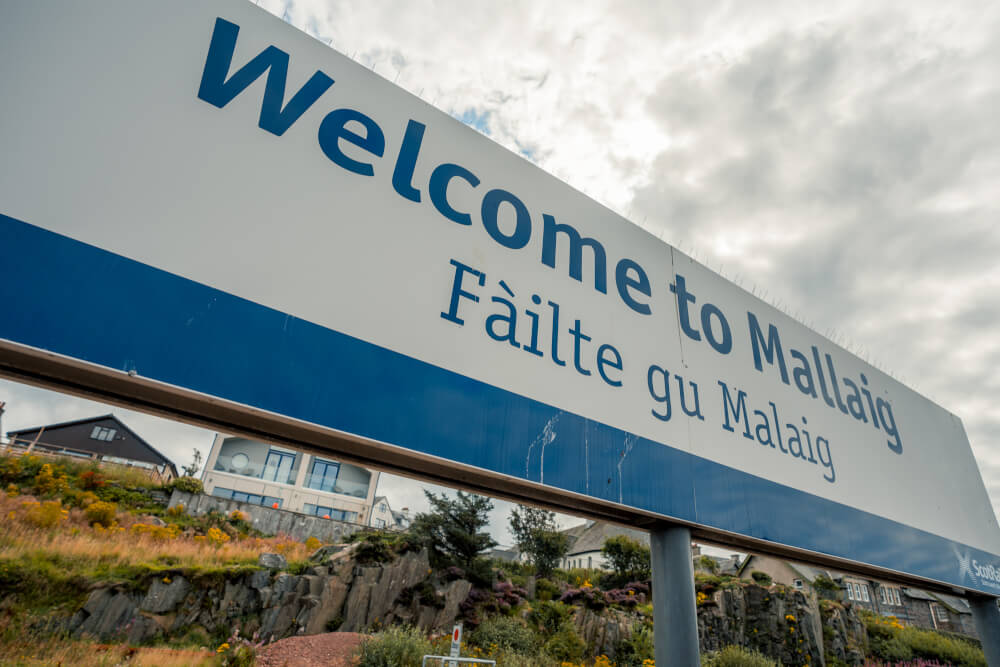
22. Know what it means to “bag a Munro”
Another piece of vocabulary to know is Munro, which refers to mountains in Scotland over 3000 ft. This doesn’t come from Scots or Gaelic though, they’re named for Sir Hugh Munro, who famously published a list of Scotland’s highest mountains.
Hardcore people today make a hobby out of “bagging Munros” which means reaching the top of these mega-mountains. There’s 282 of them, and the current record is held by a badass woman known as Jamie Aarons , who bagged all 282 Munros in 31 days.
31. DAYS. That’s an average of over 9 Munros a day.
Meanwhile, here’s me:

Now if you’re not up for bagging Munros, a more feasible challenge might simply be to…
23. Learn to pronounce Scottish place names somewhat correctly
One of the most common tourist mistakes you encounter in Scotland is first time visitors pronouncing words/names wrong, which is fair because not all names are pronounced like how they’re spelled in English.
So, here are some common ones to take note of:
- Edinburgh is pronounced Ed-in-bruh, not Eden-Borrow, Edin-borrow, or Edin-berg
- Glasgow is pronounced Glaz-go, not not Glass-G’ow
- Culross is pronounced Coo-Riss, not Cull-Ross
… and many, many more.
The key is to listen out for how locals are pronouncing it whether that be your taxi driver, your guide or even the automated announcements the train station.
That said, there’s obviously slight differences depending on accents, and Scottish people tend to be really nice and forgiving so don’t stress too much.
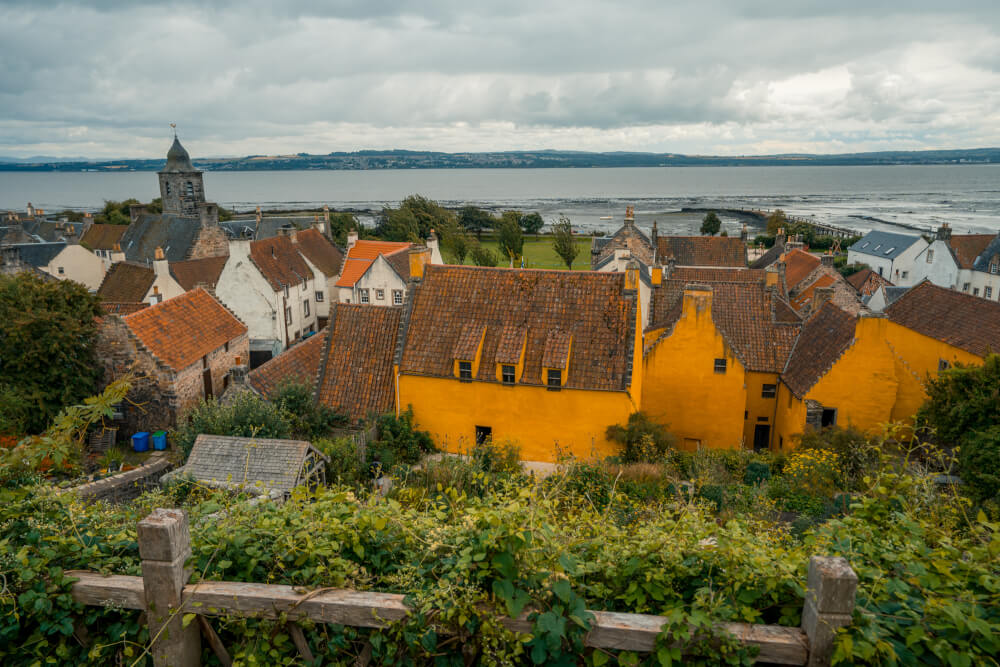
24. Beware of sightseeing passes
Unfortunately, paid attractions in Scotland can be quite pricey, and while sightseeing passes (e.g. ones where you pay a set fee for many different attractions at once) do exist, many of them aren’t worth it unless you’ll be visiting a wide range of sights across the country.
Some common ones include…
- City-specific passes like the Edinburgh City Pass
- Historic Scotland
- National Trust for Scotland
- The Explorer Pass
So, before blindly purchasing one of these passes, I would make sure to first total up the cost of the attractions you actually want to see, then comparing it to the pass cost. Often you’ll find it’s not worth it unless you’re staying for a long time and visiting many attractions during your visit.
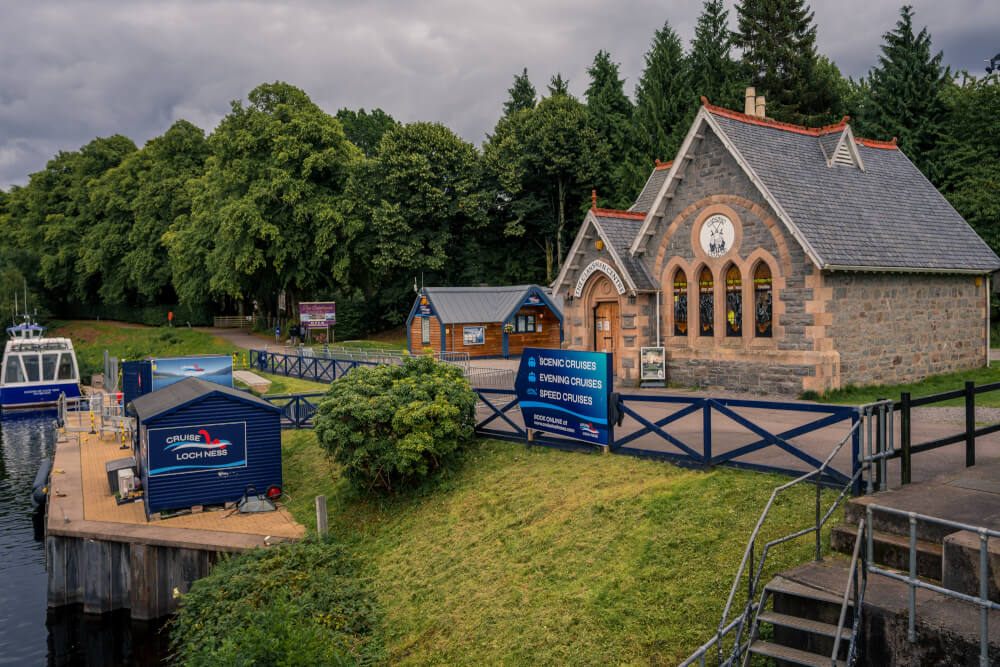
25. Take advantage of all the free attractions
One of my favourite things about Scotland is just how many free museums and attractions there are to visit.
In pretty much every destination, you’ll find free things to do, so before you spend all your money on attraction tickets, be sure to search up free things to do in your destination of choice. Odds are, you’ll find plenty!
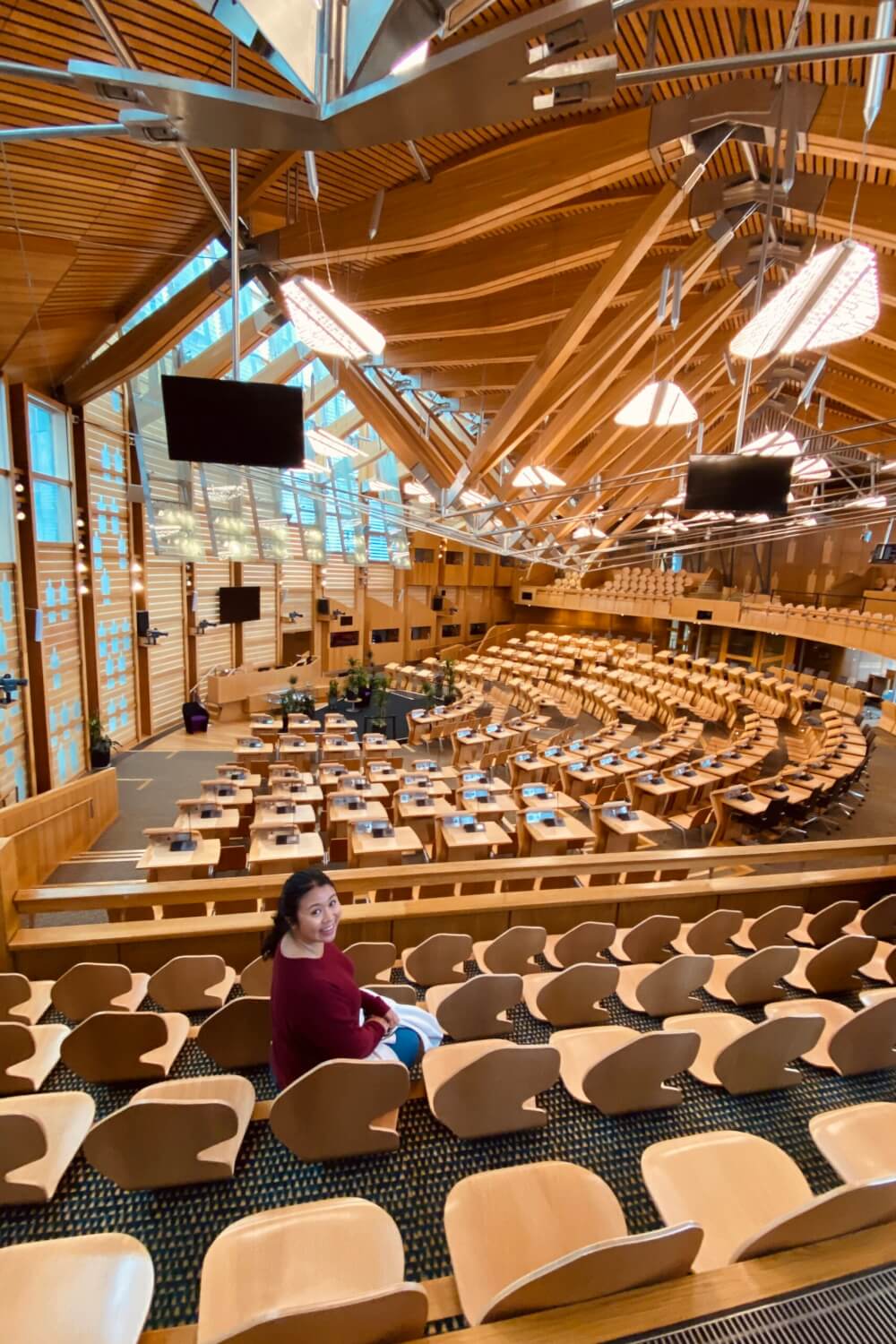
26. Get familiar with Scottish accents before your trip
Now, another tricky thing for first time visitors in Scotland is if you’re not used to it, understanding the Scottish accent may be a challenge, especially once you leave big cities and start venturing farther out.
But a fun Scotland tip for getting used to the accent is simply watching movies and TV shows set in Scotland. This will also help you adjust to some vocabulary differences, as well as just get you excited for your trip.
Some recommendations include (obviously) Outlander if you’re into that kind of show, or Mary Queen of Scots and Outlaw King for some handy historical context and beautiful backdrops.
PS: This might be a good time to mention that Braveheart is wildly inaccurate but entertaining nonetheless.
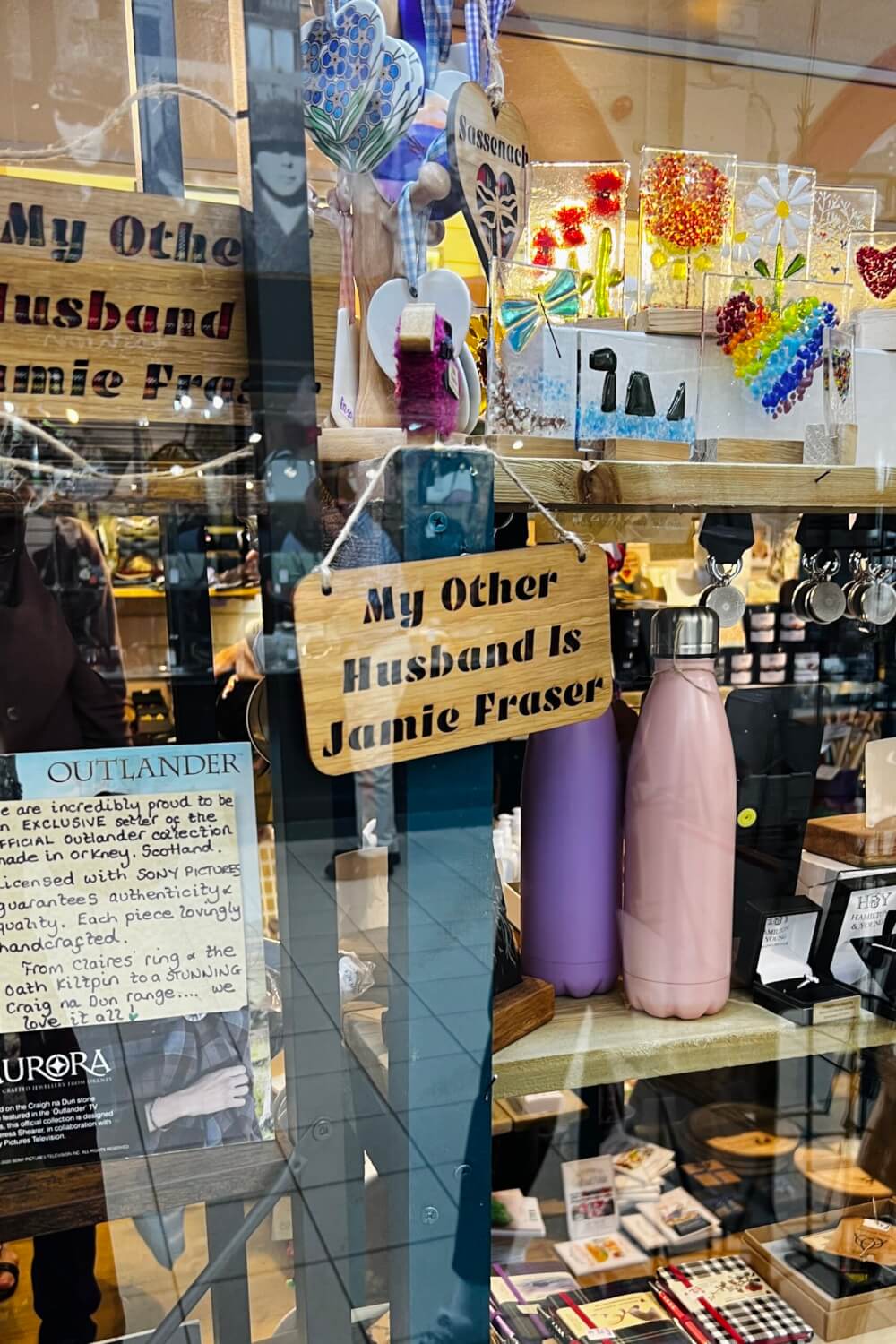
27. Carry a bit of cash, especially coins
While paid toilets aren’t a universal thing in Scotland like in other countries (e.g. Germany ), apparently 18 councils across the country do charge a small fee for using the toilet (usually 30p or less).
I noticed this when I was in Inverness and the surrounding area, with many public toilets (even in train and bus stations) charging a small amount like 10 or 20p for the facilities, so it’s not enough to just bring some cash, coins are a must.

28. Scottish money is different, but English bills are welcome too
Plus beware that while Scotland does use the pound just like the rest of the UK, there are specific Scottish bills/notes that are unique.
This shouldn’t be too big of a deal since English pounds are accepted everywhere as well, and technically speaking these Scottish bills are legal tender throughout the UK, but do withdraw your cash sparingly as sometimes places elsewhere in the UK can be a bit funny about accepting Scottish banknotes.

29. Tip around 10% for good service
Now in terms of tipping in Scotland, tips aren’t mandatory in all settings but usually when it comes to sit-down table service, 10% ish is common for good service.
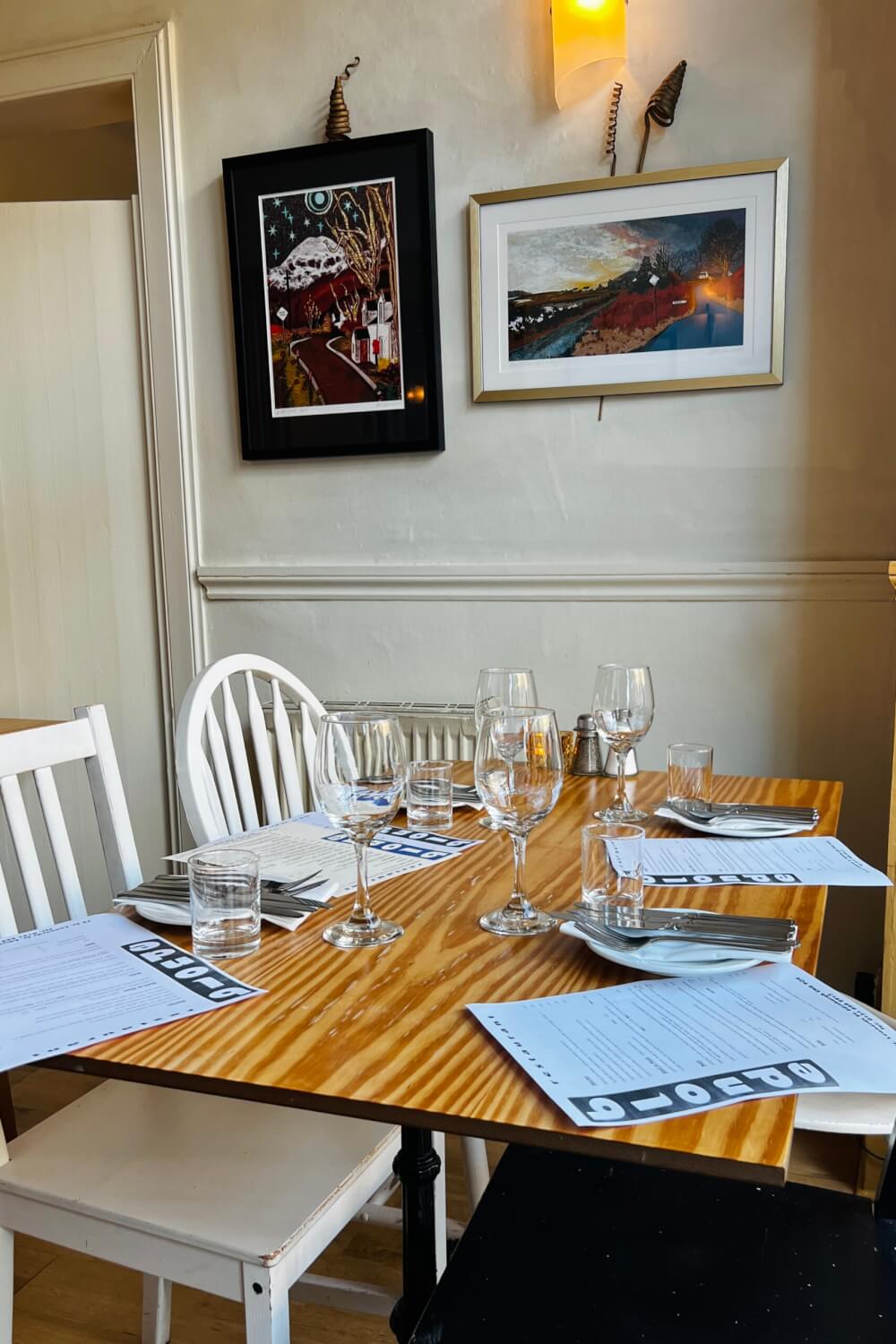
30. Don’t stop in the middle of the sidewalk (AKA pavement) for photos
Having experienced this too many times during my month in Edinburgh, I now completely understand the local rage against it.
Scotland is beautiful and you will be compelled to take photos every three seconds, but before you do so, make sure you pull over to the side and not block anyone’s way.
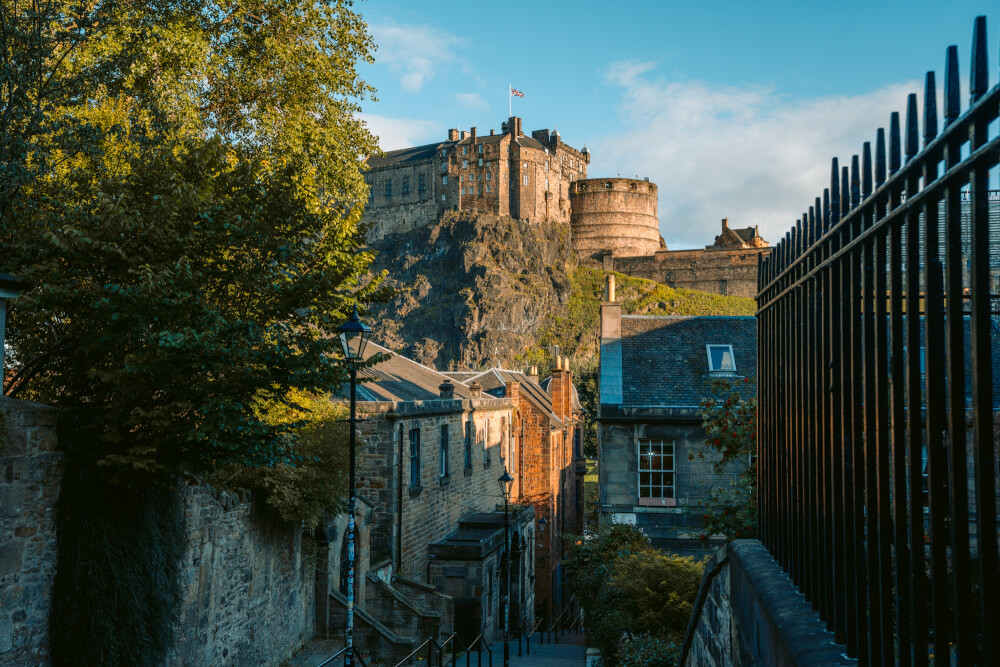
31. Be prepared for all kinds of weather
Scottish weather is notoriously gloomy and random. So even if you are coming in the summer, don’t expect summer weather all the time…
Instead, be prepared for all kinds of potential weather at all times by packing layers that are versatile for different conditions.
I would definitely prioritize a good waterproof or windproof jacket over an umbrella because with Scottish rain comes Scottish wind which makes many umbrellas quite useless.

32. Prioritize comfortable walking shoes
And, unless you have a specific event you know you’ll be going to, no need to bring heels or fancy footwear. Comfort is key!
Which is how I ended up with silly outfits like this:

33. Beware of midges and ticks
If you plan to do any hiking in Scotland, be sure to prepare against the notorious Scottish midges and ticks. Bring insect repellant and lots of it!

34. Make sure you go to a place with some live music
There’s honestly no better way to finish off a day of sightseeing in Scotland than with a cold beer and live music. Be sure to add this into your itinerary at some point! It’s so much fun.
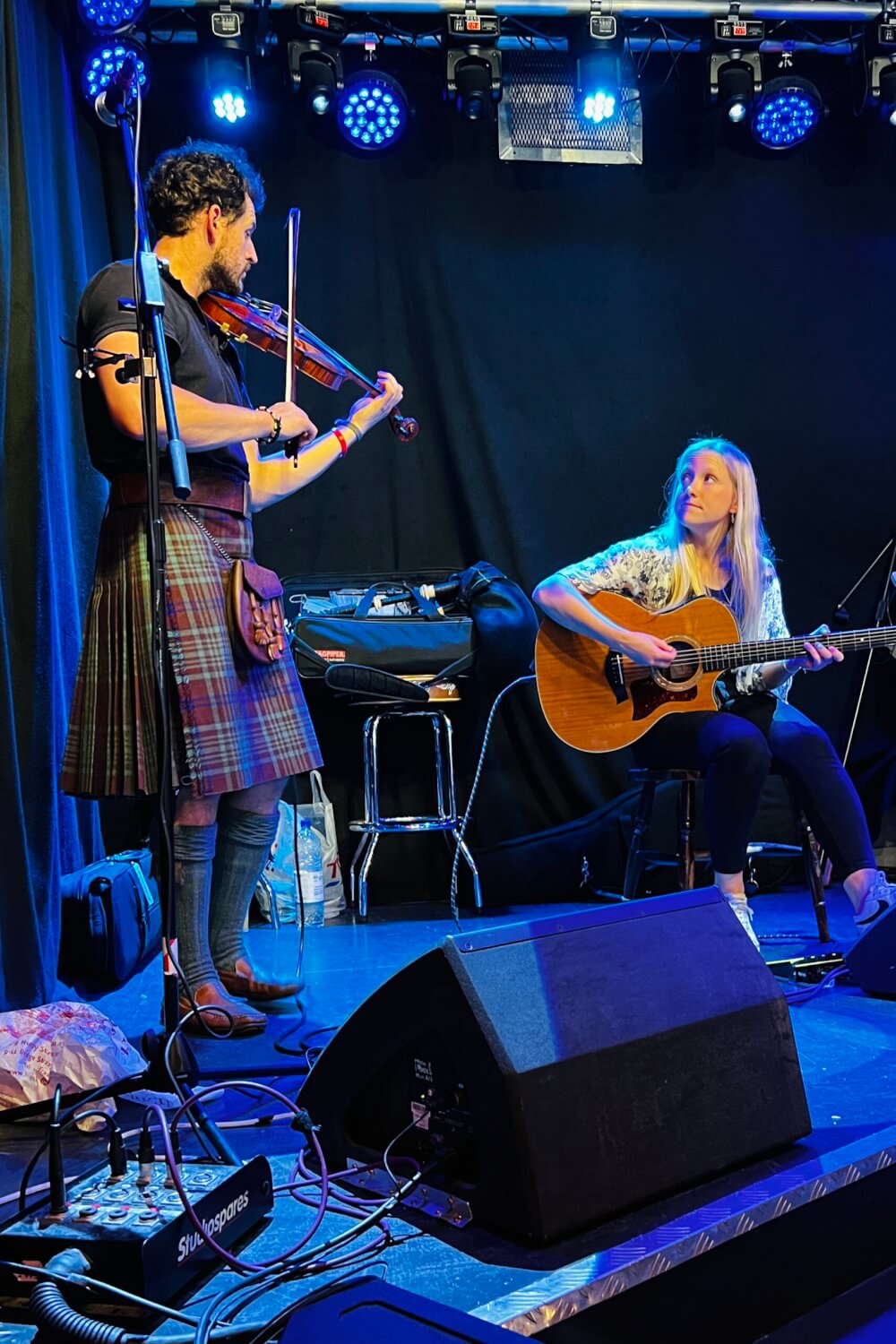
35. Avoid cheap souvenir shops and outfits in busy tourist areas
Lastly, a few Scotland tips for buying souvenirs: the first one being to avoid the tacky souvenir shops you see in busy touristy areas.
Sadly, these shops aren’t necessarily selling you the best quality stuff and if you’re looking for wearable souvenirs like a Tartan scarf that will actually last, then getting one from a pricier but more reputable brand might be a good idea. A lot of the souvenir shops sell polyester replicas which aren’t the best quality.
The same idea goes for other souvenir items – finding an independent shop stocked with local makers might mean more unique and better quality gifts to bring home.

36. Avoid buying the cheap souvenir shop tartan berets & kilts
On a similar note, I would also personally avoid buying & wearing cheap souvenir shop accessories, like tartan berets, especially the ones with red hair attached to them, just because people in Scotland really don’t wear those in their day to day lives and they look a bit silly.
The same applies for buying souvenir shop kilts. I honestly can’t imagine a scenario where it would make sense for a tourist to buy and wear a kilt while they’re just out exploring… especially because they don’t tend to be day to day attire for Scottish people anyway.
At the end of the day though, wear whatever makes you happy!

37. Be sure to leave space in your luggage
Last but not least, remember to pack light when you come to Scotland so you have room for goodies to bring home!
There are many excellent potential souvenirs in Scotland, but they tend to be bulkier items like wooly goods, so make sure you have the space for it.
PRO TIP: You can always pack a second bag (or nest a small suitcase within a larger one) so you only have to check a second bag on the way home.
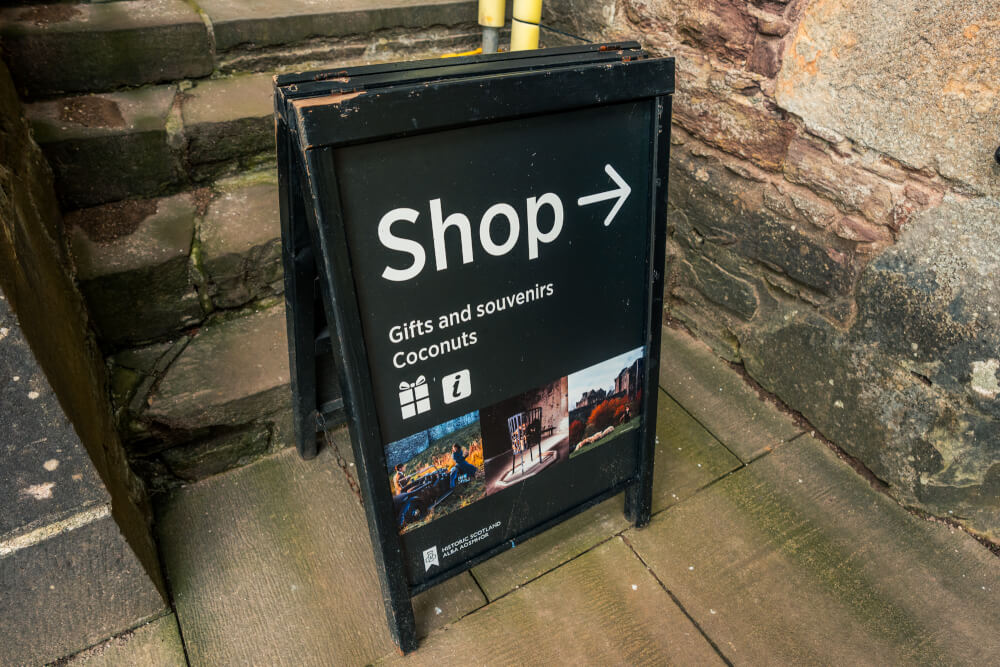
Did I Forget Any of Your Favourite Scottish Travel Tips?
Let me know in the comments! Safe and happy travels 🙂
My Go-To Travel Favourites:
🧳 Eagle Creek: My favourite packing cubes
💳 Wise: For FREE travel friendly credit cards
🍯 Airalo: My go-to eSIM
🏨 Booking.com: For searching hotels
📷 Sony A7IV: My (amazing) camera
✈️ Google Flights : For finding flight deals
🌎 WorldNomads: For travel insurance
🎉 GetYourGuide: For booking activities
2 thoughts on “37 Scotland Travel Tips for First Timers & Must Knows Before You Go”
Christina. A good fair and accurate assessment of Scotland.
Allan( a Scot from Kirkcaldy)
Thanks so much, Allan! 🙂
Leave a Comment Cancel reply
By using this form you agree with the storage and handling of your data by this website. *
- Search Please fill out this field.
- Manage Your Subscription
- Give a Gift Subscription
- Sweepstakes
- Travel Destinations A-Z
How to Plan the Perfect Scotland Vacation
From fairy-tale castles to charming small towns, the Scottish countryside is every bit as spectacular as you've heard.
Best Times to Go to Scotland
Best things to do in scotland.
- Getting to the Scottish Highlands
Where to Stay in Scotland
With its stately castles , glass-like lochs, and voluptuous glens, Scotland has always been a showstopper. The country's magic extends from its quaint small towns to the snow-capped peaks of its romantic, rugged Highlands to its dynamic modern cities like Glasgow and Edinburgh. It's home to some of the best national parks in the U.K. and more than 900 offshore islands with extraordinary wildlife like regal red stags, majestic golden eagles, humpback whales, and massive salmon (not to mention the fabled inhabitant of Loch Ness, too).
The raw, poetic beauty of this ancient land — formerly known as Caledonia — is difficult to overstate. If you're hoping to head to the U.K.'s ravishing northern nation, read on for our guide to planning the perfect Scotland vacation.
The bad news is that, like the rest of the U.K., Scotland's weather is far from reliable, even at the height of summer. But as long as you're prepared to accept that and pack a raincoat for the odd shower or two, then you'll be fine from May to September. The smart money is on visiting in June and the first two weeks of July, when Scotland basks in seemingly endless summer evenings (the sun doesn't set until 11 p.m. in some parts of the Highlands) and the British school holidays have not yet begun, so prices remain low.
For winter travelers, Scotland has the U.K.'s best ski resort at Cairngorm Mountain , while the capital, Edinburgh, hosts one of the world's biggest New Year's Eve parties, Hogmanay .
If you like the great outdoors, you'll love Scotland. It's an ideal place for hiking, biking, and generally embracing the wildly beautiful landscape. You can summit magnificent Ben Nevis in a day (the tallest mountain in the U.K., at 4,413 feet), take a ferry out to explore the Hebrides archipelago and its stunning white-sand beaches, tour scores of castles, including the Queen's favorite holiday home, Balmoral (open to the public every April through July), and dive into a quirky food scene encompassing dishes like haggis (an offal and oatmeal combo, which tastes significantly better than it sounds), deep-fried mars bars, and juicy scallops, langoustines, and mussels.
Scotland is also a mecca for both golfers ( St. Andrews Old Course is the headline act) and whisky lovers , with some of the world's best distilleries available to tour, including Johnnie Walker on Edinburgh's lively Princes Street, Glenlivet near pretty Ballindalloch, and the legendary Macallan on a sprawling country estate in nearby Aberlour.
If you enjoy driving, you'll find some of the U.K.'s emptiest, most dramatic roads here, too, (as driven by James Bond in "Skyfall"), including the latest official addition, the North Coast 500 , an action-packed 500-mile route (516 to be exact) featuring mind-boggling coastal scenery, jaw-dropping beaches, rolling hillside, quaint fishing villages, and multiple hidden gems.
And if you prefer your challenges on foot, check out the magnificent West Highland Way , the country's best-loved long-distance walking route. Snaking its way from Milngavie to Fort William, it covers some of Scotland's finest scenery over 96 miles and is normally completed from south to north.
Meanwhile, history buffs will also be agog on any visit to Scotland, thanks to its 3,000-plus castles ( Castle Sween in Argyll is the oldest, dating back to the 1100s), as well as plenty to check out in the winding wynds (narrow lanes) and twisted staircases of Edinburgh's enchanting Old Town. ( Edinburgh Castle , towering over the city, is arguably the grandest in the country, too.)
If you can, make time to visit Perth, the former Scottish capital where kings were crowned on the Stone of Destiny and infamous Glen Coe, a beautiful valley full of waterfalls and deer, also known for the brutal clan massacre of 1692 (which inspired the Red Wedding in George R. R. Martin's Game of Thrones ).
Where are the Scottish Highlands — and what is the best way to get there?
Jess Macdonald/Travel + Leisure
The clue is in its name: the Highlands are the mountainous upper half of Scotland, covering 10,000 square miles of picturesque scenery. The region's lively capital is Inverness , which sits centrally and is a superb base from which to explore, while other highlights include mysterious, misty Loch Ness, majestic Cairngorms National Park , and idyllic Isle of Skye , which has been connected to the mainland via a road bridge since 1995.
The easiest way to reach the Highlands is to fly into Inverness Airport from London or elsewhere in the U.K., or rent a car and drive from Glasgow or Edinburgh. However, the way to arrive in style is on the Caledonian Sleeper train from London Euston, a chugging time machine where you can fall asleep to the sounds of black cabs and bustle of the British capital and wake up among the red deer and magical glens of the Highlands. Regularly nominated as one of the world's best train journeys , the scenery gets truly spectacular after Fort William, as the route skirts a dramatic chain of lochs before descending into lush glens and crossing the Glenfinnan Viaduct made famous by the Harry Potter films. For the ultimate Hogwarts experience, steam locomotives work this route during the summer months, so check in advance for these special departures.
The major cities have an abundance of hotels for every budget, headlined by Glasgow's Kimpton Blythswood Square , a boutique property in the former headquarters of the Royal Scottish Automobile Club, and The Dunstane Houses in Edinburgh, a pair of beautifully renovated 19th-century townhouses.
Scotland arguably does traditional country house hotels and rustic lodges better than anywhere else in the world, with Fife Arms in Braemar and Gleneagles in Perthshire being particular treats (the latter, nicknamed the "Glorious Playground" boasts three championship golf courses, its own dedicated train station, and the only restaurant in the country with two Michelin stars).
Scotland is, of course, peppered with castles, and many have been converted into hotels and B&Bs in recent years, with some of the better fortified accommodation options including Glenapp Castle in Ayrshire, Inverlochy Castle in Fort William, Atholl Palace Hotel in Pitlochry, and Stonefield Castle Hotel on Loch Fyne.
Wherever you stay, you'll get a warm welcome — not to mention a hot bowl of Scottish porridge or a plate of bacon, eggs, and haggis to start the day in a spectacularly scenic country.
Nomadic Matt's Travel Site
Travel Better, Cheaper, Longer
Scotland Travel Guide
Last Updated: April 1, 2024
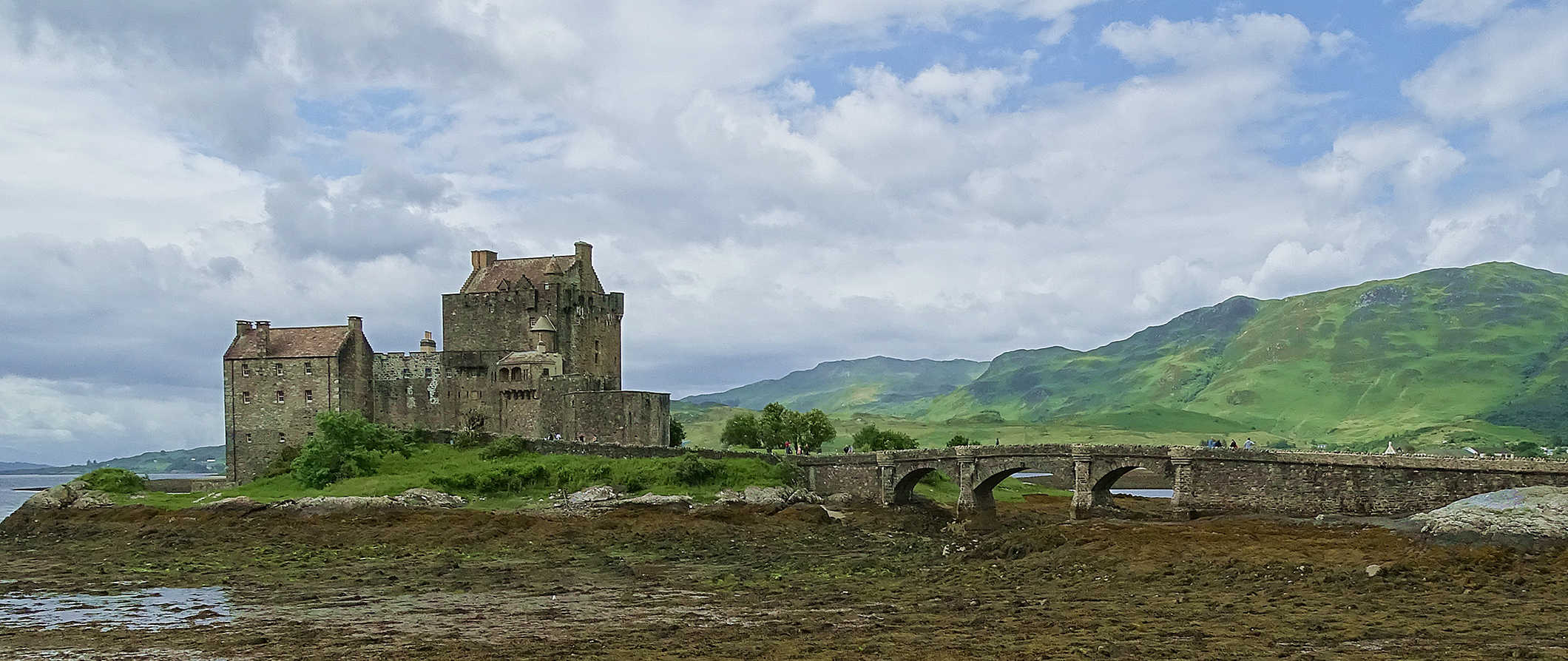
Partially conquered by the Romans, Scotland is a land with a turbulent past. It was invaded countless times by the English during the Middle Ages before the Treaty of Union in 1707 united the continent (an unpopular move at the time). Since then, it’s been a part of the United Kingdom (though there is a growing movement for independence).
While Scotland may be a small country (only 5.4 million people call it home), it’s had a huge impact on the direction of the world. Economist Adam Smith, inventor of the telephone Alexander Graham Bell, novelist Robert Louis Stevenson (he wrote Treasure Island ), philosopher David Hume, ecologist John Muir — the list of famous Scots goes on.
I love visiting Scotland. The people, the jovial spirit, the landscape, the booze — Scotland never disappoints (ok, maybe a little with the food). It’s an incredible destination for road trips so make sure you get out of the cities and into the highlands with their rich jagged landscapes. And be sure to head west to the islands of Islay, Jura, and Mull.
This travel guide to Scotland can help you plan where to go, what to see, how to save money, and everything in between!
Table of Contents
- Things to See and Do
- Typical Costs
- Suggested Budget
- Money-Saving Tips
- Where to Stay
- How to Get Around
- How to Stay Safe
- Best Places to Book Your Trip
- Related Blogs on Scotland
Click Here for City Guides
Top 5 things to see and do in scotland.
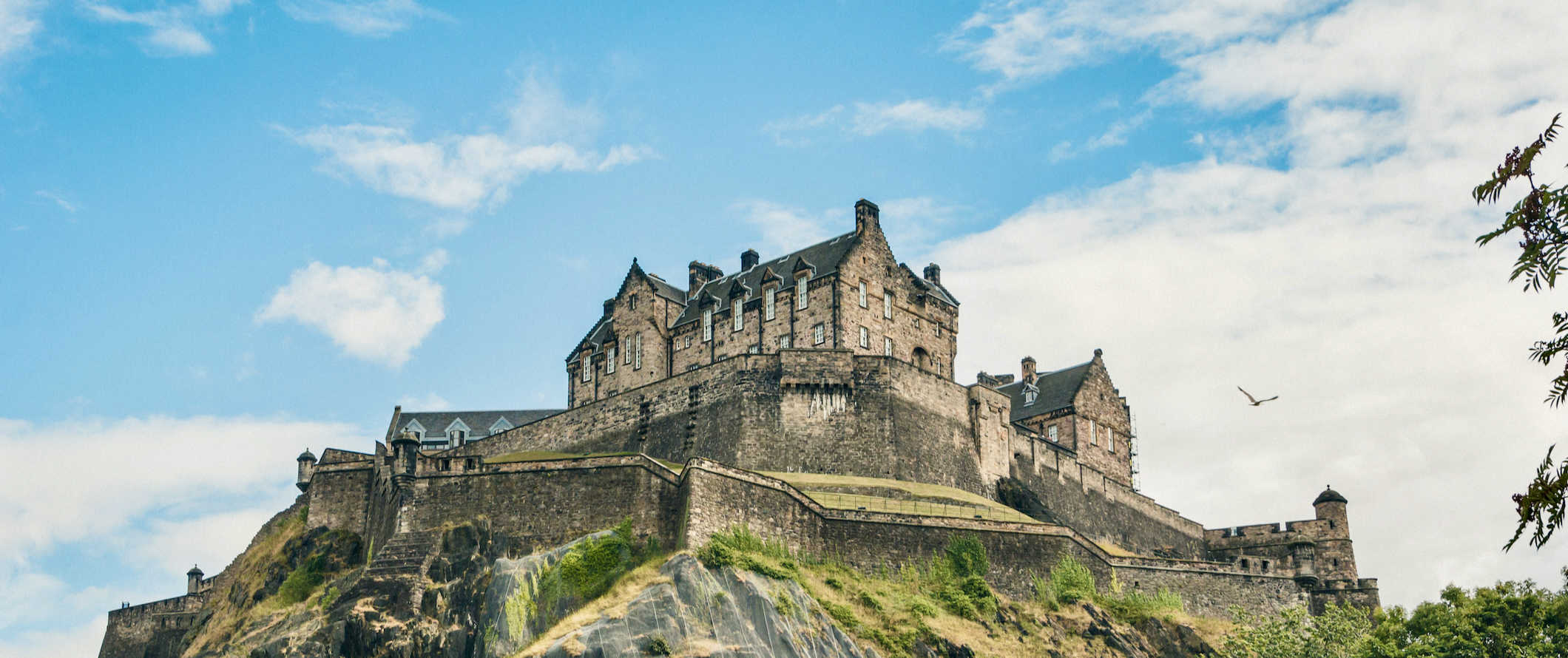
1. Explore the Scottish Highlands
Visit the highlands of Scotland for moody mountains, rugged terrain, glaciers, lochs, and kilt-clad Scotsmen. While the land may be harsh and unforgiving, you haven’t really seen Scotland until you’ve been here. Don’t miss Glencoe, Cairngorms National Park, Inverness, and the Isle of Skye.
2. Visit Edinburgh
Edinburgh is a glorious city filled with medieval cobblestone streets, lots of green space, free museums, a huge castle, and maybe even some ghosts. There’s a lot to do here so be sure to spend a few days. It’s an amazing place.
3. Celebrate Hogmanay
Hogmanay is one of the largest New Year’s celebrations in the world, attracting over 100,000 people for the two-day festival. The modern iteration has musical acts, a torchlight procession, multiple fireworks displays, and a large street party.
4. Drink whisky in Islay
Whisky has a long history on Islay . It’s been made there since the 16th–century — first in backyards and then, starting in the 19th-century, in big distilleries. Over the years, whisky from the island came to be considered a specialty and is famous around the world.
5. Visit Inverness
Besides the historic buildings in the Old Town, there is a great selection of places to eat and drink, Inverness Castle, the Inverness Museum and Art Gallery, and a Victorian Market. Plus, it is close to Loch Ness (it’s less than a 30-minute drive away), a bunch of distilleries, and a few golf courses.
Other Things to See and Do in Scotland
1. try to find nessie.
Loch Ness is one of the most famous lochs (lakes) in Scotland. It’s the alleged home to Nessie, aka the Loch Ness Monster, a creature said to live in the loch. The first “sightings” date back to the 1870s, though there is no definitive proof that any such creature exists. Nonetheless, the myth perseveres, making Loch Ness a popular destination to visit. While here, you can take a cruise, hike in the nearby hills, and enjoy some of the smaller nearby towns and villages like Dores or the nearby ruins of Urquhart Castle. The best way to get here is to travel to Inverness, from which Loch Ness is close enough to take a day trip to (it’s just a 25-minute drive from Inverness to Lochend, the top of Loch Ness).
2. Wander around Glasgow
Glasgow is a busy and bustling city, home to a youthful population (there is a university here) and a picturesque downtown. With plenty of parks, historical monuments, and museums, there is plenty to do here if you’re on a budget. It’s also a vegan and vegetarian hotspot too! Don’t miss the Kelvingrove Art Gallery and Museum, relaxing in Glasgow Green, seeing the cathedral, and day-tripping to the nearby Loch Lomond and the Trossachs National Park.
3. See the cathedrals
The cathedrals in Scotland are marvelous with their unique Gothic architecture and imposing heights. A few of the top cathedrals to visit are Dunfermline Abbey and Palace in Fife, St. Magnus Cathedral in the Orkney Islands, St Giles in Edinburgh, and Melrose Abbey in the Borders. Also, don’t miss the Glasgow Cathedral, which was built in 1136 and is the oldest building in Glasgow. Admission is free though donations are encouraged.
4. Puzzle over Rosslyn Chapel
This historic chapel near Edinburgh is ripe with intricate artwork and symbolism that has spawned many conspiracy theories (not to mention books). (Like why is there corn on the wall if corn wasn’t discovered until centuries later?). it was featured heavily in The Da Vinci Code and is located just an hour outside Edinburgh. Admission costs 9.5 GBP.
5. Play golf
The Scottish invented golf in the 15th century. If you’re not lucky enough to play a round at St. Andrews (the most famous course in the country) there are plenty of other immaculate and challenging courses to keep any golf player happy. Try to play during the low season (between November and March) if you want the lowest prices (St. Andrews, for example, costs 220 GBP to play in high season, versus 98 GBP in low season). Castle Stuart (Inverness), Royal Dornoch (Dornoch) , and Muirfield (Gullane) are some other great courses worth playing.
6. See the Cuillin
This dramatic mountain range dominates the Isle of Skye. There are two main ridges (the red and the black), which can be visited as a day trip or a longer two-day hike. Much of the mountain range, which stretches 14 kilometers (8.6 miles), can be hiked, though some peaks require more technical climbing skills. There are campgrounds and a hostel nearby in Glenbrittle as well. Some of the most popular trails are Rubh’ an Dùnain (3-5 hours, easy), Coire Lagan (2 hours, moderate), and Sgùrr Alasdair (6-8 hours, hard).
7. Visit Ruins of Melrose Abbey
Robert I (also known as Robert the Bruce) was the King of Scotland from 1306 until his death in 1329. Legend has it that his heart is buried in the ruins of Melrose Abbey. The abbey, founded in the 12th century and located in Melrose, was repeatedly destroyed by the English in the 14th century. You can still see marks on the surviving walls from cannonballs during the English Civil War. The abbey ruins (which is only a ruin of its former self, composed of several standing walls and arches) are decorated with intricate artwork carved into the remaining stone walls. Admission is 6 GBP.
8. Explore Dundee
Dundee is a lively student city along the coast with a lot of interesting museums. It’s a UNESCO City of Design and is the sunniest spot in the country too. Don’t miss a visit to Discovery Point to learn about the famous Antarctic expedition that launched from here in 1902 on the RSS Discovery (which you can board at the visitor center). Also, be sure to take in the great street art, the Vaults (a series of underground tunnels that date back to the 1750s), and The McManus Art Gallery as well.
9. Visit the Mystical Smoo Cave
The sleepy town of Durness, located 193 kilometers (120 miles) north of Inverness, is the access point for Smoo Cave , a coastline cave complex that can be explored independently or on a tour. Evidence from charcoal samples shows that it may have been inhabited over 4,000 years ago. The cave is free to enter but guided tours, which take you deeper into the cave, are 10 GBP. You get to see a lot more on the tour than you would if you just visit independently. Tours last around 20 minutes.
10. Head to the Isle of Arran
Located 2.5 hours west of Glasgow, this isle is a popular tourist destination for its charming scenery of jagged hills and rugged coasts, walking trails, and historic villages. Visit Brodick Castle, go for a hike, keep a lookout for seals and golden eagles, and enjoy the remote scenery. Don’t miss the Machrie Moor Stone Circles (which are sort of like Stonehenge) — they date back almost 5,000 years!
11. Explore the Cairngorms
Cairngorms National Park is the largest national park in the UK, spanning 4,528 square kilometers (1,748 square miles). Located two hours from Edinburgh by car, it makes for a great getaway for anyone looking to get out and see the highlands. The park is dotted with beautiful B&Bs in historic stone buildings and there are several campgrounds available for anyone traveling in a camper van or with a tent. Wild camping is also permitted, providing you do so responsibly. The park offers lots of hiking trails too. Don’t miss Ryvoan Pass (easy), Dalraddy to Ruthven (moderate), and Ben Macdui (difficult). If you visit in the winter, you can also go skiing on Cairn Gorm Mountain. If you’re lucky, you may spot some of the reindeer that call the park home (it’s the only herd in the British Isles). Admission to the park is free.
12. Attend the Edinburgh Fringe Festival
The Edinburgh Festival Fringe is the world’s largest arts festival. It usually lasts three weeks and takes over the entire city of Edinburgh. There are tens of thousands of performances including plays, musicals, live music, puppet shows, and much more! There are literally thousands of different shows held and hundreds of venues around the city. It’s a massive festival and brings in upwards of 3 million visitors. It’s a zany, inspiring, and entertaining festival and one that shouldn’t be missed. Just make sure you book your tickets and accommodation in advance as things fill up fast.
13. Tour the Isle of Skye
This popular island off the northwestern tip of the country is a scenic place to take a road trip. The island offers sweeping views over the rugged coastline, hiking trails, castles, waterfalls, and quaint villages and B&Bs. While most people just visit for a day, I suggest spending a few days driving around and getting off the beaten path. You can visit by bus if you don’t have a car, however, having your own vehicle will give you much more freedom. Don’t miss Dunvegan Castle, the Old Man of Storr rock formation, and brother’s point.
For more information on cities in Scotland, check out these guides:
- Edinburgh Travel Guide
- Glasgow Travel Guide
Scotland Travel Costs

Accommodation – Most 6-8-bed dorms in Scotland cost 18-22 GBP per night, though prices rise a few pounds in the summer and drop a few in the winter (you can find hostels for as little as 12 GBP in the off-season). Free Wi-Fi and lockers are standard, and most hostels also have self-catering facilities. Private rooms in a hostel cost around 40-65 GBP per night.
Budget hotels cost around 55-75 GBP per night with standard amenities like free Wi-Fi, TV, and coffee/tea makers. Some include free breakfast.
Airbnb is widely available in Scotland and is especially useful in the smaller towns and villages where there are fewer traditional hotels and hostels. A private room generally costs 25-30 GBP per night while entire homes/apartments start at 55 GBP per night, though most options are 70 GBP and above.
If you want to camp, expect to pay around 17 GBP per night for a basic plot (a small flat space for a tent without electricity). Most campgrounds close for the winter so availability is limited come late October/early November. If you’re in a car or campervan, you can use the app “park4night” to find paid overnight parking, free overnight parking, and campgrounds.
Food – Scottish food is hearty, heavy, and filling. Seafood is abundant, and popular traditional dishes include blood pudding, minced beef, fish and chips, smoked herring, neeps and tatties (turnips and potatoes), and of course haggis (a dish composed of minced sheep’s organs and spices inside a sheep’s stomach casing). Porridge is a common breakfast choice, though a larger breakfast of sausage, eggs, beans, and bread is not uncommon either. Sticky toffee pudding is a favorite dessert, and of course, you can’t visit Scotland without sampling some scotch.
Expect to pay around 10-12 GBP for a basic meal (like a Scottish breakfast). For pub food like a burger or fish and chips, prices are usually between 12-20 GBP for a meal. For a full three-course meal at a mid-range restaurant, prices begin around 27 GBP.
A pint of beer is around 4 GBP while a glass of wine is around 5.50 GBP. A latte or cappuccino is around 2.70 GBP.
If you’re looking for fast food (think McDonald’s), expect a combo meal to cost around 6 GBP. A classic fish and chips from a no-frills takeaway spot is around 6 GBP, while Chinese takeaway is around 8-10 GBP. Street food (like from a food truck) costs around 6-8 GBP. Eat near the universities for the cheapest food options.
A week’s worth of groceries costs around 40-60 GBP. This covers basic staples like pasta, rice, seasonal produce, and some meat. The cheapest supermarkets to look out for are Aldi, Lidl, Asda, and Tesco.
Backpacking Scotland Suggested Budgets
On a backpacker budget, you can visit Scotland for around 55 GBP per day. On this budget, you’re staying in a dorm room or camping, cooking all of your meals, using local transportation, sticking to mostly free activities (like hiking, museums, or free walking tours), and limiting your drinking.
On a mid-range budget of about 105 GBP, you can stay in a private Airbnb room, eat out at cheap local restaurants for a few meals, enjoy a few drinks, take the occasional taxi to get around, and do more paid activities like visiting castles or doing a whisky tasting.
On a “luxury” budget of 210 GBP or more per day, you can stay in a hotel, eat out for every meal, drink what you want, take the train between cities or rent a car, and visit as many museums and attractions as you’d like. This is just the ground floor for luxury though — you can easily spend more if you want to splash out!
You can use the chart below to get some idea of how much you need to budget daily, depending on your travel style. Keep in mind these are daily averages — some days you’ll spend more, some days you’ll spend less (you might spend less every day). We just want to give you a general idea of how to make your budget. Prices are in GBP.
Scotland Travel Guide: Money-Saving Tips
While Scotland is expensive, there are lots of ways to lower your costs. Here are some tips to help you save money in Scotland:
- Get the Edinburgh City Pass – If you’re planning to explore Edinburgh, get the City Pass. For 45 GBP, you get access to 22 attractions as well as free transportation to and from the airport. There is also a two-day pass for 55 GBP and a three-day pass for 65 GBP.
- Eat in a pub – The best food is often in the pubs at a fraction of the price compared to a proper restaurant. Also, pubs generally give you a true taste of Scottish culture. Scotland is pub-land – they’re everywhere.
- Eat during lunch – Many cafes, bakeries, and chains offer lunch deals for as little as 3-5 GBP.
- Visit the free museums – The public museums in Scotland are free so take advantage! Free museums include The National Museum of Scotland, Scottish National Gallery, Royal Botanic Garden Edinburgh, and the Scottish National Gallery of Modern Art.
- Use buses – If you need to go anywhere, buses are by far the cheapest way to reach the widest range of places on a regular schedule. You can even find tickets for just 1 GBP from Megabus if you book far enough in advance.
- Avoid eating and shopping in the city centers – Both Glasgow and Edinburgh get significantly more expensive the closer you get to the city center. There are plenty of good restaurants and quirky shops outside of the center, so go for those. Trust me, you won’t be disappointed.
- Use apps to get food deals – On the app Too Good to Go, participating eateries sell severely discounted meals/groceries/baked goods at the end of the day. You just sign up, see what is being offered near you, and pick up your cheap food at the end of the day. It has good coverage all across Scotland, particularly in Edinburgh. For discounts on takeout try the app Secret Takeaways which supports local restaurants in Edinburgh and Glasgow by cutting out the delivery app middleman (and their high fees).
- Stay with a local – Couchsurfing is the best way to save on accommodation in Scotland. You’ll not only save some money but get access to a knowledgeable local who can help point you to some of the country’s hidden gems. It may not be fancy, but you’ll get a unique experience and learn far more about the destination than if you stayed in a hotel!
- Take a free walking tour – If you want to understand more about the history, architecture, and people of Scotland then be sure to take a free walking tour. They usually last a couple of hours and are a great introduction to the city. New Europe has a great free tour in Edinburgh and Visit Scotland offers one in Glasgow.
- Cook your own meals – Eating out in the UK isn’t cheap. Save yourself some money and cook a few meals for yourself. It may not be as fancy as eating out, but your wallet will thank you!
- Rent a campervan – If you’re planning to get out of the city, rent a camper van. You can get them for as little as 30 GBP per day. They come with basic self-catering facilities so you can cook your food and have somewhere cheap to stay. There are lots of free places to park around the country. Just use the app park4night to find them.
- Use BlaBlaCar – BlaBlaCar is a ridesharing app you can use to travel in between cities. It’s faster than the bus and usually just as cheap. You have to find a ride, which can sometimes be hit or miss, but the profiles are verified and reviewed so it’s quite safe. Plus, it’s a great way to connect with other locals/travelers.
- Use discount websites – Groupon, Wowcher and Living Social have good deals on accommodation, attractions, and dining out.
- Bring a water bottle – The tap water here is safe to drink so bring a reusable water bottle to save money and reduce your plastic use. LifeStraw is my go-to brand as their bottles have built-in filters to ensure your water is always clean and safe.
Where to Stay in Scotland
Accommodation in Scotland isn’t cheap, but there are nevertheless lots of great hostels to stay at to help you meet people and save money. Here are my favorite hostels in Scotland:
- Castle Rock (Edinburgh)
- Edinburgh Backpackers (Edinburgh)
- Kick Ass Grassmarket (Edinburgh)
- Glasgow Youth Hostel (Glasgow)
- Euro Hostel Glasgow (Glasgow)
- Broadford backpackers (Isle of Skye)
- Stirling Youth Hostel (Stirling)
How to Get Around Scotland

Public Transportation – Public buses and trams cost around 1.50-2 GBP for one-way ride. For a single-day pass, expect prices to start at 4 GBP per person. In Glasgow, a 7-day public transportation pass costs 17 GBP.
Only Glasgow has a subway system and the tickets for the bus and metro are not interchangeable as they are operated by two different companies (though prices between the two are comparable).
Airport shuttles cost around 6-8 GBP each way.
Flying – Flying around Scotland is both inconvenient and expensive. There are very few direct flights, making it slower to fly than to take the bus. I would avoid flying and just take the bus or train.
Bus – Buses are a popular and affordable way to get around the country as they link most destinations in the country. Scottish Citylink, Stagecoach, Megabus, and National Express are the four main companies that operate here. Tickets can be found for as little as 1 GBP via Megabus, though they’re usually around 10-25 GBP.
Edinburgh to Glasgow, for example, is a one-hour bus ride that costs 8 GBP while the three-hour journey from Glasgow to Inverness costs around 20-30 GBP. The sooner you book your ticket, the lower the price, so always try to book in advance. The coaches here are modern and comfortable with bathrooms and Wi-Fi as well.
Train – Trains connect all the major cities in Scotland (as well as the towns and villages they pass through). When purchased in advance (12 weeks out is the sweet spot), tickets are only a little more expensive than the bus. For example, Inverness to Glasgow takes about as long as the bus and is only 30 GBP while Edinburgh-Glasgow is 30 minutes faster than the bus for just 1-2 GBP more. Just be sure to book early to get the best prices. Last-minute tickets can be expensive!
Car rental – Scotland is a great road trip destination. You can get cars for 20 GBP per day and campers for 30 GBP per day. Just remember that traffic flows on the left. Most vehicles are manual transmissions as well. Renters need to be at least 21 years of age.
Rideshare – Ridesharing apps like Uber are a reliable but expensive way to get around in cities like Glasgow and Edinburgh. Skip them if you can.
For longer distances, use BlaBlaCar. It’s a ridesharing app that pairs you with drivers who are traveling to other cities. They have profiles and reviews (similar to Airbnb) so it’s quite safe. It’s usually not as cheap as the bus, but it’s faster and more comfortable.
When to Go to Scotland
Summer is the most popular time to visit Scotland. In July and August, there’s warm weather and minimal rain, with temperatures reaching highs of around 20°C (68°F). This is also the busiest time of the year, so expect crowds in the cities and lots of people out enjoying the national parks. The Edinburgh Fringe Festival takes place in August, which is a huge multi-week festival. Be sure to book your accommodation in advance if you’re visiting during this time.
September is a rather wet month, though in October there’s incredible fall foliage. Overall, October is a great time to visit — especially if you plan on renting a car or camper and heading into the Cairngorms (Scotland’s biggest national park). Seasonal businesses and accommodations start to close in mid-October so be sure to keep that in mind when planning. Expect October temperatures to hover around 12°C (55°F) during the day.
The spring is a great time to visit, with April and May offering minimal rain and no crowds. There’s still snow and cool temperatures in the highlands, but the cities are lively without being crowded.
Winters in Scotland are cold and dark. December is relatively dry, with temperatures dipping below 0°C (32°F). It’s nevertheless a popular time to visit, with many tourists coming to Edinburgh for the huge Hogmanay New Year’s Eve celebration (one of the biggest New Year’s festivals in the world). Book your accommodation well in advance if you plan to attend.
By February, snow is common so keep that in mind if you plan on renting a vehicle. Unless you’re coming to engage in winter sports, I’d avoid a winter visit unless you don’t mind the grim and grey atmosphere of the country.
How to Stay Safe in Scotland
Scotland is a safe country, even for solo travelers, and even for solo female travelers. Like in all cities, stay vigilant when you’re in crowded tourist areas or on public transportation as that is when pickpockets usually strike. If you keep your valuable secure, however, you shouldn’t have any issues.
Additionally, solo female travelers don’t need to worry in Scotland, however, women should take the standard precautions when traveling alone at night (don’t travel alone intoxicated, keep an eye on your drink, etc.).
Keep in mind that traffic flows on the left here. Most vehicles are manual transmissions and have the gear shift on the left (which is opposite to most other countries). Driving might take some getting used to so drive carefully — especially in cities and when going through roundabouts.
If you are hiking, make sure you have the appropriate equipment and notify your accommodation of your plans just in case as the weather can change quickly in the highlands.
While scams here are rare, you can read about common travel scams to avoid here if you’re concerned.
If you experience an emergency, dial 999 for assistance.
Always trust your gut instinct. Avoid isolated areas at night and be aware of your surroundings at all times. Make copies of your personal documents, including your passport and ID.
If you don’t do it at home, don’t do it in Scotland!
The most important piece of advice I can offer is to purchase good travel insurance. Travel insurance will protect you against illness, injury, theft, and cancellations. It’s comprehensive protection in case anything goes wrong. I never go on a trip without it as I’ve had to use it many times in the past. You can use the widget below to find the policy right for you:
Scotland Travel Guide: The Best Booking Resources
These are my favorite companies to use when I travel. They consistently have the best deals, offer world-class customer service and great value, and overall, are better than their competitors. They are the companies I use the most and are always the starting point in my search for travel deals.
- Skyscanner – Skyscanner is my favorite flight search engine. They search small websites and budget airlines that larger search sites tend to miss. They are hands down the number one place to start.
- Hostelworld – This is the best hostel accommodation site out there with the largest inventory, best search interface, and widest availability.
- Booking.com – The best all around booking site that constantly provides the cheapest and lowest rates. They have the widest selection of budget accommodation. In all my tests, they’ve always had the cheapest rates out of all the booking websites.
- Get Your Guide – Get Your Guide is a huge online marketplace for tours and excursions. They have tons of tour options available in cities all around the world, including everything from cooking classes, walking tours, street art lessons, and more!
- SafetyWing – Safety Wing offers convenient and affordable plans tailored to digital nomads and long-term travelers. They have cheap monthly plans, great customer service, and an easy-to-use claims process that makes it perfect for those on the road.
- LifeStraw – My go-to company for reusable water bottles with built-in filters so you can ensure your drinking water is always clean and safe.
- Unbound Merino – They make lightweight, durable, easy-to-clean travel clothing.
- Top Travel Credit Cards – Points are the best way to cut down travel expenses. Here’s my favorite point earning credit cards so you can get free travel!
- BlaBlaCar – BlaBlaCar is a ridesharing website that lets you share rides with vetted local drivers by pitching in for gas. You simply request a seat, they approve, and off you go! It’s a cheaper and more interesting way to travel than by bus or train!
Edinburgh Travel Guide: Related Articles
Want more info? Check out all the articles I’ve written on backpacking/traveling Scotland and continue planning your trip:
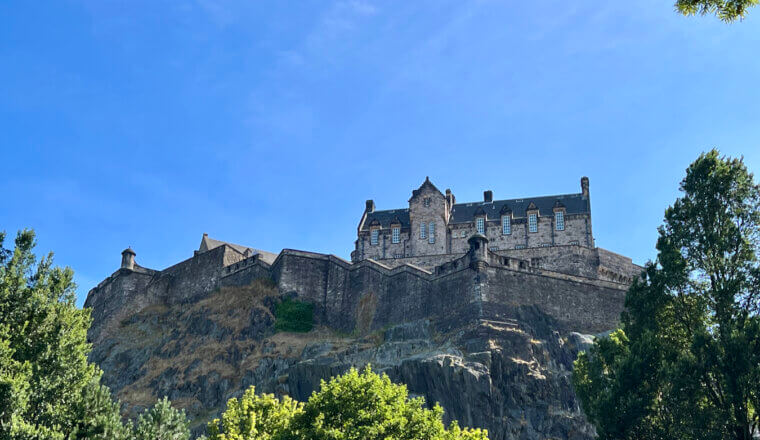
The 6 Best Hotels in Edinburgh
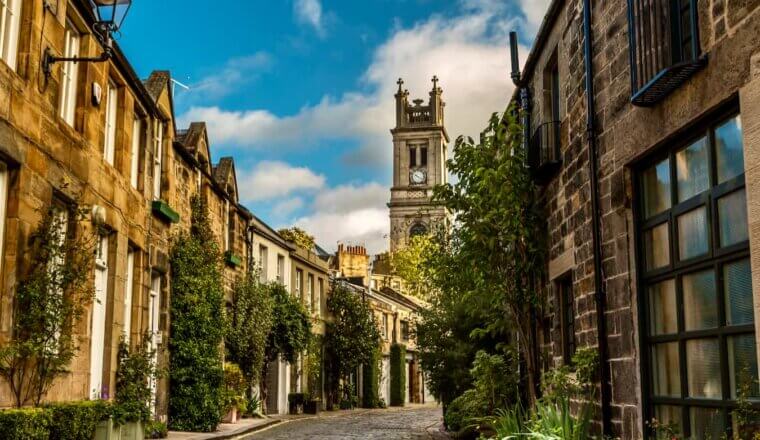
The Best Walking Tours in Edinburgh
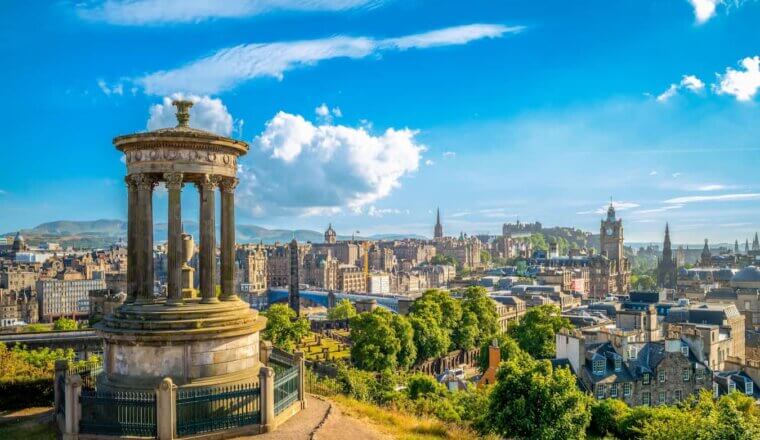
Where to Stay in Edinburgh: The Best Neighborhoods for Your Visit
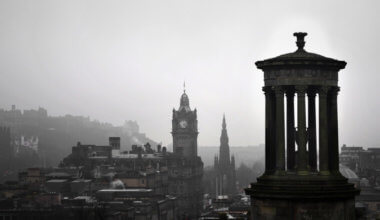
The Best Ghost Tours in Edinburgh

A Complete Visitor’s Guide to Rosslyn Chapel
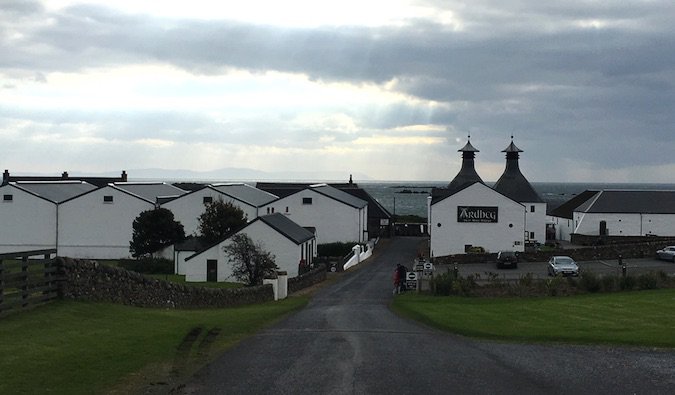
Searching for the Perfect Dram on Islay
Get my best stuff sent straight to you, pin it on pinterest.
- Where To Stay
- Transportation
- Booking Resources
- Related Blogs
10 things only Scottish locals know – and you should too before traveling there
May 22, 2023 • 6 min read
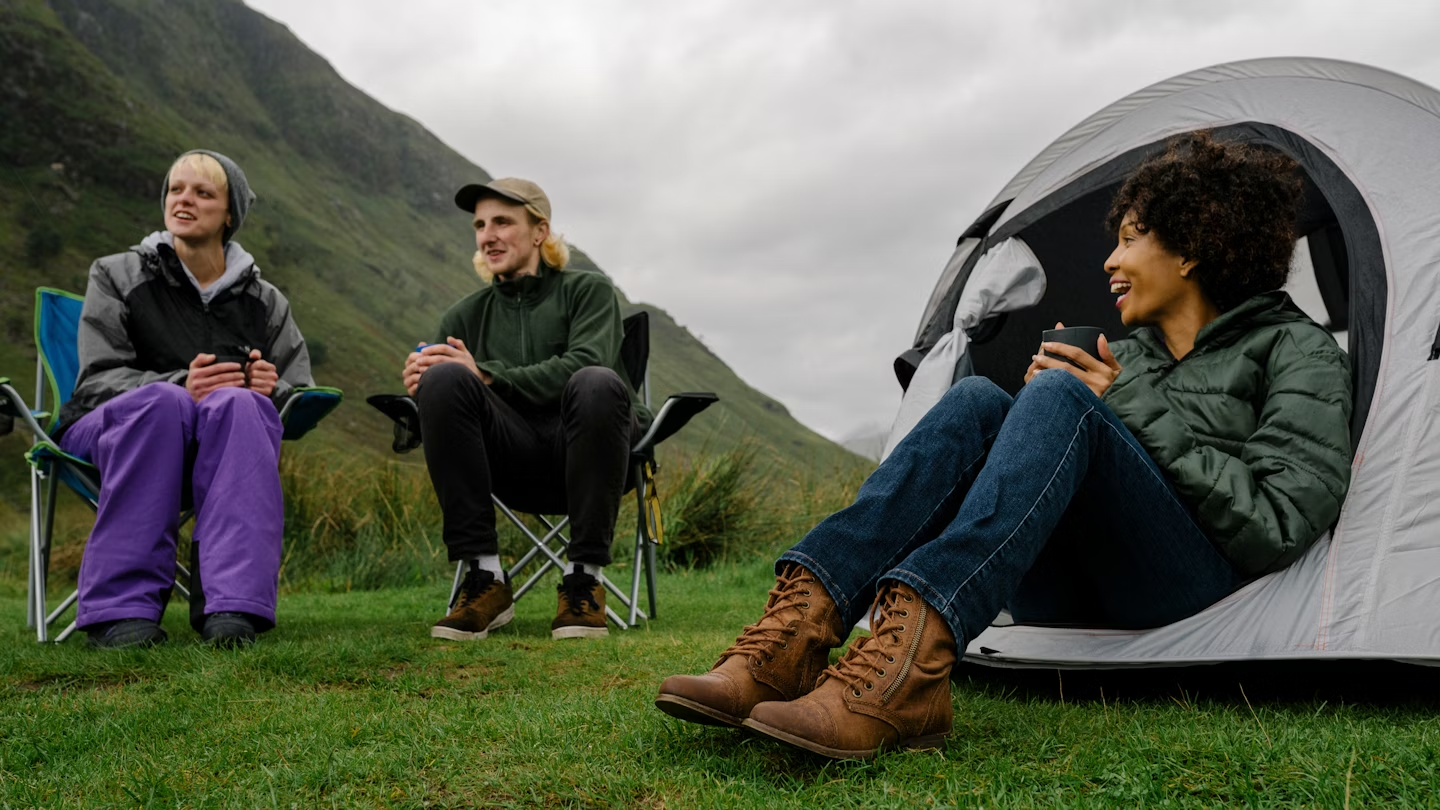
Pack for weather of all kinds for your trip to Scotland © Rawpixel.com / Shutterstock
Jam-packed with hidden glens, haunted castles and cryptic lochs, overrun with mind-boggling festivals and melodious bagpipe players, and soaked in peated whisky , gin and rain, Scotland can be as baffling as it is brilliant.
This country specializes in astonishing travelers at the same time as confounding them, delivering a double punch of euphoria and disbelief. Not that you’d know it from the chipper locals who take everything in their stride.
For all the undreamed-of scenarios that you can encounter while here – summer hiking in shorts with an umbrella, for instance, or being terrorized by an invisible nuisance, the blood-sucking midge – the truth is that Scotland is an easy country to crack if you know the answer to some crucial questions and practicalities.
What’s the smartest way to travel around when venturing outside of Edinburgh ? How long do you need to make a trip to Scotland's islands worthwhile? Is it really OK to eat a deep-fried Mars Bar in Glasgow ? (Spoiler: yes, but no one ever really does.)
Here are a few key things and etiquette tips to know before traveling to Scotland.
Pack for all seasons, even in summer...
A joke often told is that Scotland had a great summer last year – it was on a Wednesday. It’s a tongue-in-cheek punchline, of course, but there’s a kernel of truth at its core: the country’s weather is a carousel of ever-variegated four-season shifts, with summer days often wet, wild and glorious all in the same place at nearly the same time.
For the most dependably bright and dry weather, visit in May, early June or September. If gray is your favorite color, any time of year will suit you fine.

...and check the weather if you’re going to the Edinburgh Fringe Festival
Look away now if you don’t want the grim news. Despite the Edinburgh Fringe Festival, the world’s largest arts gathering, taking place in so-called peak summer in August, the event is often a washout. Waterproof shoes and an umbrella that you don’t mind getting blown inside out are as essential as a healthy appetite for comedy, theater, circus and raucous beer gardens.
Scottish pound sterling banknotes are valid everywhere in the UK
It sounds absurd, but the variety of banknotes in the UK can be bewildering. All pound sterling bills, whether printed in Scotland, England or Northern Ireland, are legal tender and valid across the country. You can spend English bills in Scotland, but many retailers won’t accept Scottish bills south of the border. Some foreign exchange services even provide worse rates for Scottish-printed bills.
Be wary when talking politics
Scotland is a divided country, politically speaking at least. On one hand, the independence movement is growing, but some Scots resolutely want to remain part of the United Kingdom. For a simple crash course, know that Scotland is a de facto separate country already with its own parliament – it exists in a political and monetary union with England, Wales and Northern Ireland – and that way you won’t raise the ire when chatting with locals in the pub.
The next decade could see unprecedented change in Scotland. A second independence referendum is often touted, after the 2014 referendum before Brexit failed to get over the line, but Westminster has resisted the call. Even a bare-bones understanding of the country’s sociopolitical history will deepen the pleasure of traveling to Scotland and remind you that you’re not just visiting a place, but a moment in time.
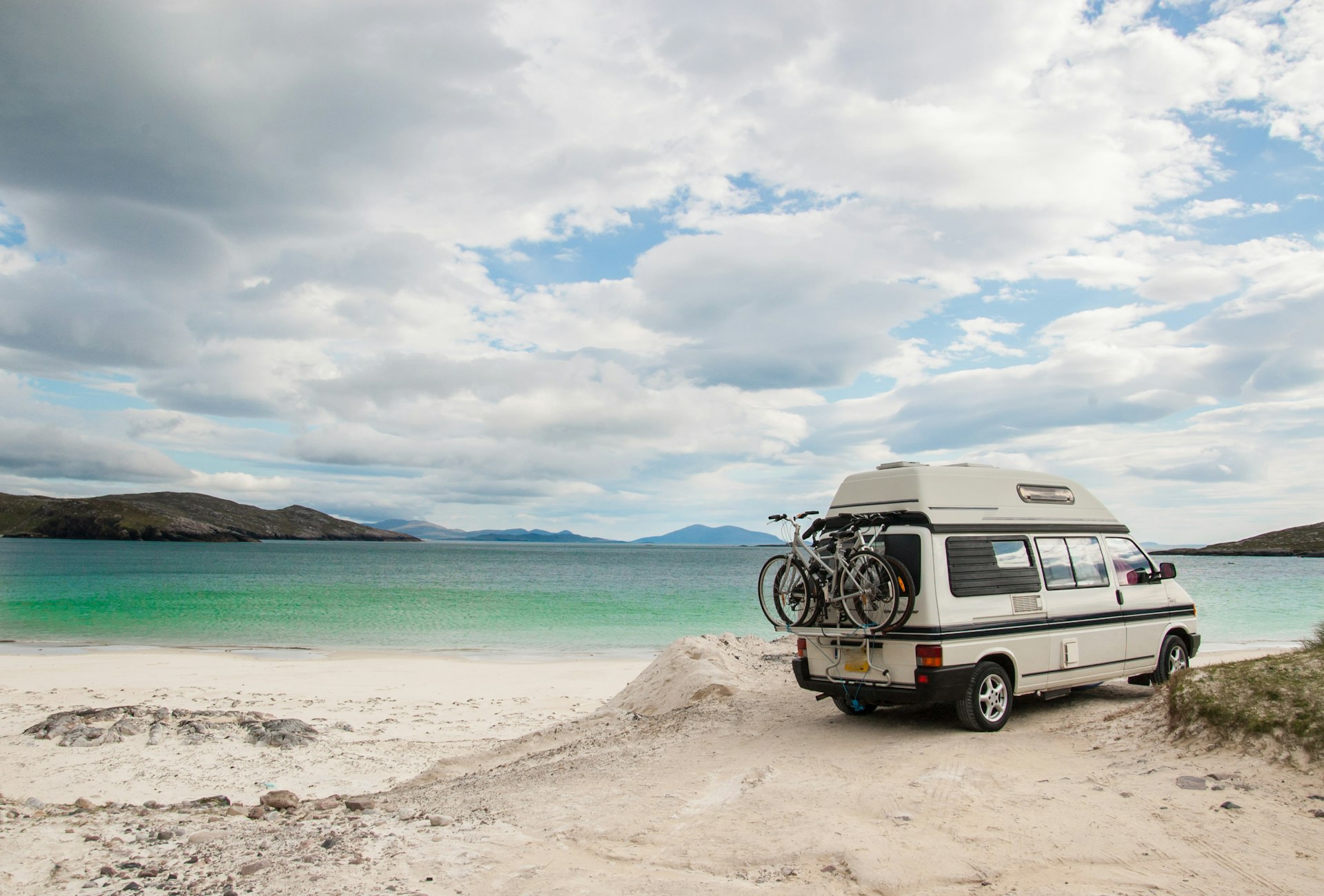
Driving outside the cities can be an art form
On first impression, Scotland is a pipsqueak in terms of European geography. It's easy to digest on the map and then drive around in a matter of days, right? Wrong.
Perhaps the most consequential effect of its jigsaw-puzzle shape, with crooked sea lochs, knobby islands and corkscrewing glens, is that getting from A to B outside the main cities always takes longer than the GPS and Google Maps suggest.
Roads are often single lane, requiring pulling to the side of the road to let oncoming vehicles pass (a friendly wave is part of the roadside theater). Slow-moving vehicles like tractors, campers and motorhomes can grind traffic to a halt, particularly on the now infamous North Coast 500 . Wayward sheep and red deer might also take over the road.
Patience is key, and a car or camper will get you to where you want to go faster – and more efficiently – than using Scotland's skeletal train and bus network . Or take your bike, inflatable kayak or canoe on a Scotrail service, now amped-up with more bike carriages and space for bulky sports gear, to see all the parts in between.
Plan for more time, not less
The biggest regret of first-time visitors to Scotland? Trying to cram too much into a single trip. If you’re spending time in Edinburgh and Glasgow and then the Highlands or Stirling and Perthshire , you’ll need at least a week. Add the Isle of Skye or the Outer Hebrides to your itinerary, and you’ll need two weeks – and you’ll still be struggling to catch your breath.
To do Scotland and its idiosyncratic islands justice, you really need three to four weeks. Travel more sustainably and focus on one chunk in particular, like the Borders and Dumfries and Galloway or Aberdeenshire and Moray . Do this, and you’ll be encouraged to stop more regularly and invest more back into the rural towns and villages you might otherwise whizz through.
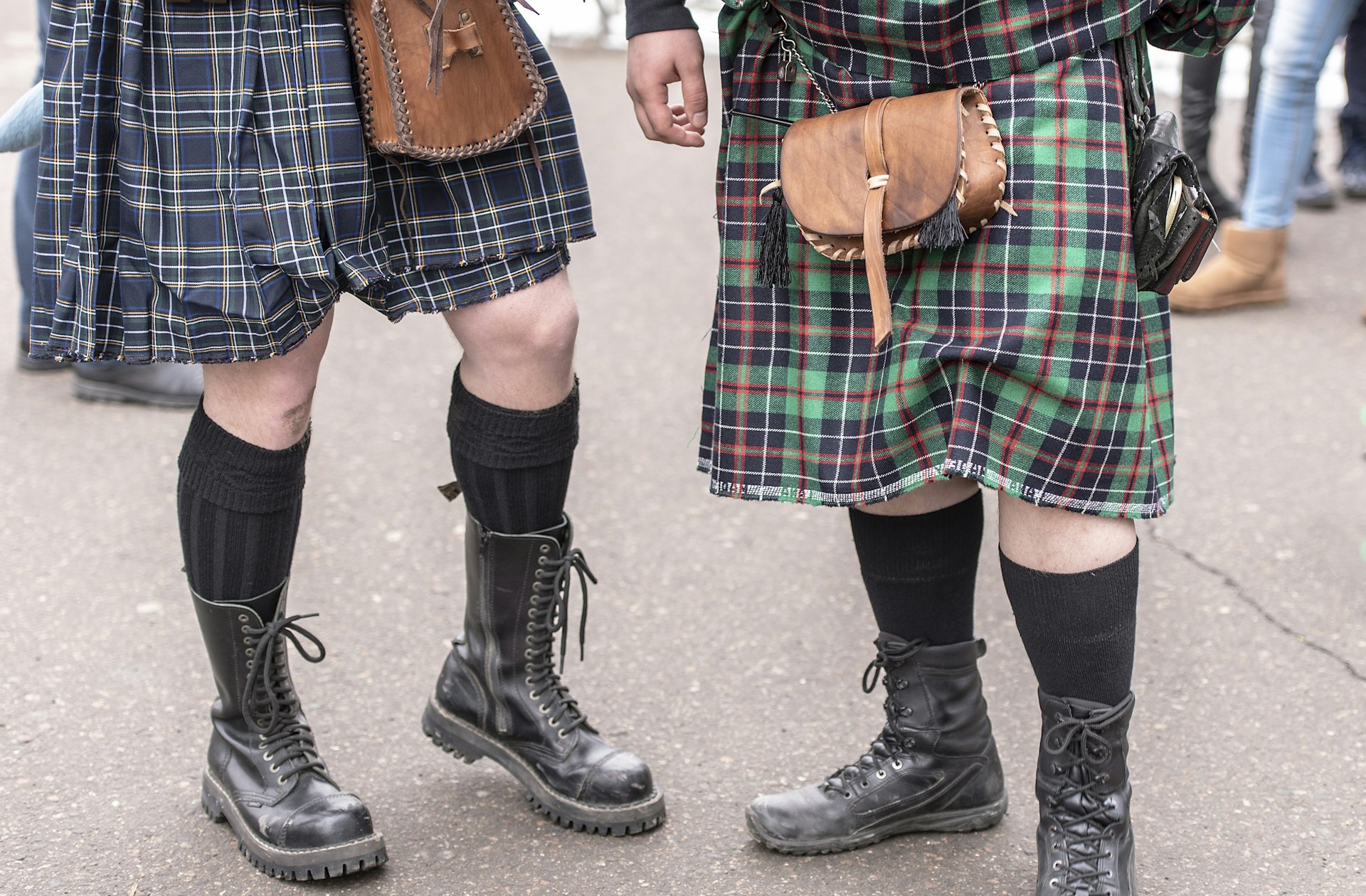
Wear a kilt if you want
The stereotypical link between the historical birthright to wear a kilt and the act of doing so is gibberish. Everyone looks better in a pleated, knee-length skirt and furry sporran, regardless of gender, nationality or patriotism to Scotland. If you need a new addition to your wardrobe, there’s nowhere better than Scotland to get measured up in tartan.
Don’t be afraid to join in
Going to the pub is a national pastime in Scotland, verging on a human right. The Scots are among the world’s friendliest, most approachable people. They love to binge on alcohol too – cue a whole dictionary of words for drinking, like blootered, bladdered, hammered, steamin’, smashed and wrecked – and see no harm in inviting a complete stranger to share a drink or dram, particularly around Hogmanay (New Year).
Expect to be invited to parties and pubs more so than you would be in many other places around the world. Like anywhere else, though, take care and be aware of your surroundings.
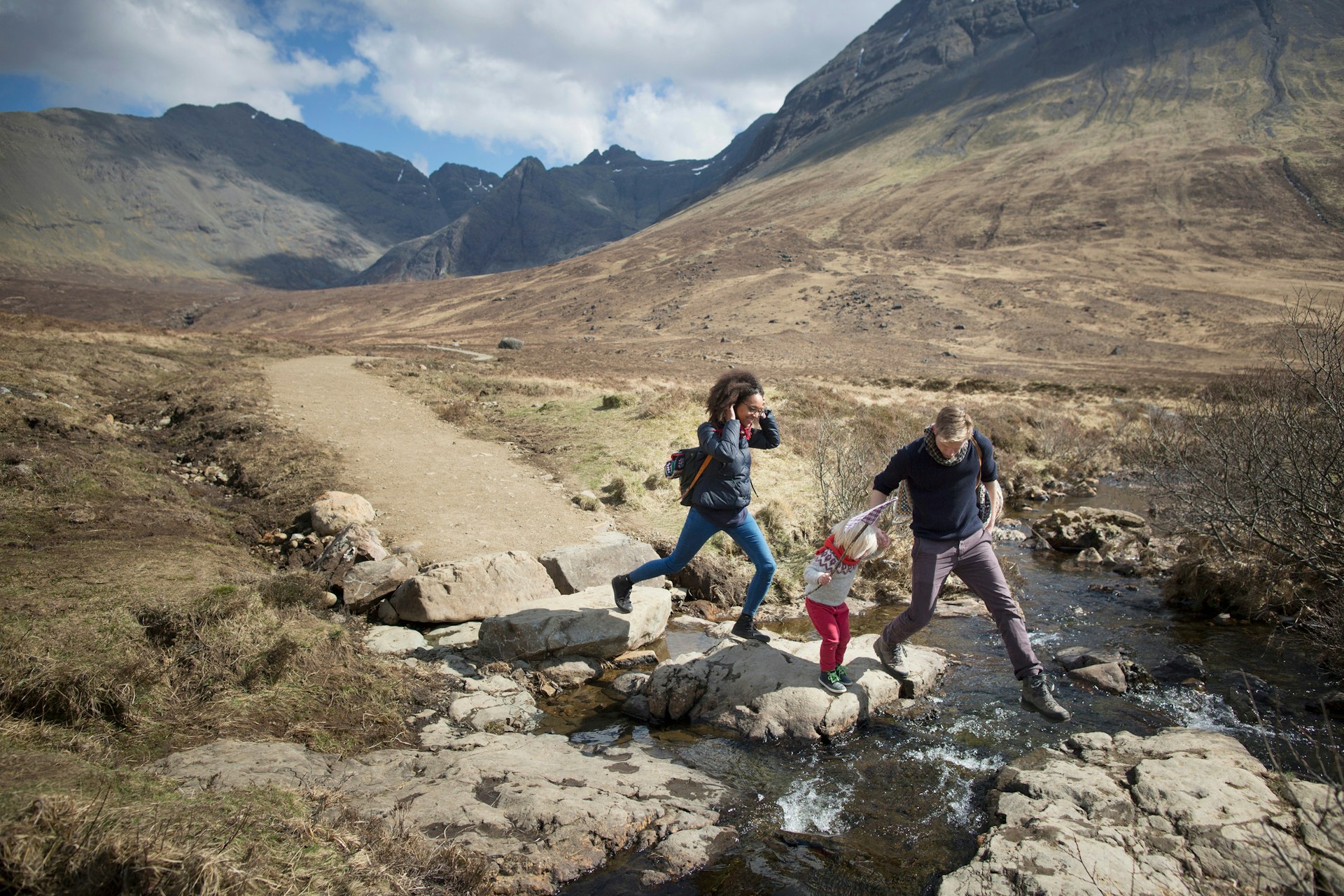
Is it safe to drink the tap water?
Yes. The one thing Scotland isn’t short of is water. Cut down on single-use plastic with a refillable bottle, and take advantage of the free network of rivers and lochs when embracing the great outdoors.
Can travelers get free health care in Scotland?
NHS Scotland, the country’s devolved National Health Service system, is a cornerstone of life, and visitors from most European countries are covered for certain emergency treatments should they have an accident while on vacation. The European Health Insurance Card (EHIC) is the key for this, while travelers from elsewhere should check on reciprocal healthcare agreements between their home country and the UK.
This article was first published September 2022 and updated May 2023
Explore related stories
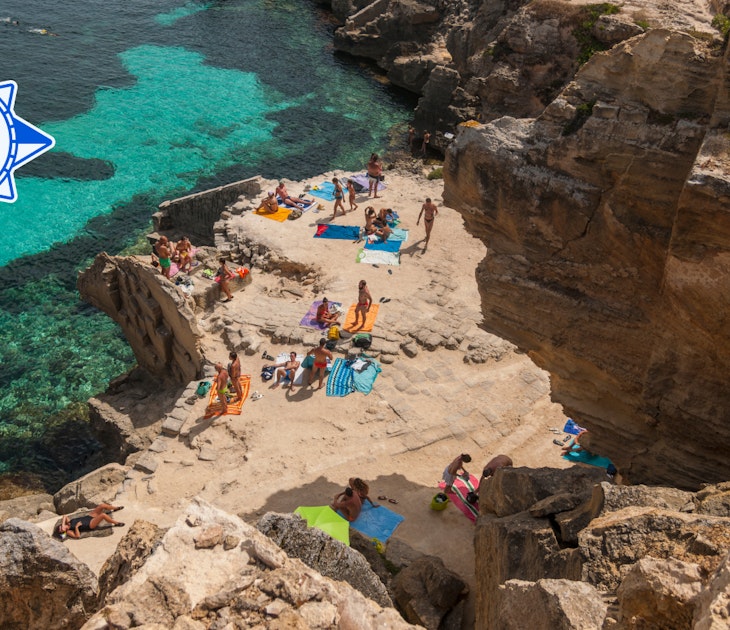
Tips & Advice
Apr 15, 2024 • 10 min read
From chilling on the beaches of Bora Bora to eating shellfish in Cape Cod, USA, here are the best places to visit in June.

Feb 8, 2024 • 7 min read

Jan 2, 2024 • 8 min read
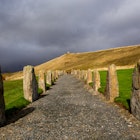
Dec 5, 2023 • 7 min read

Nov 19, 2023 • 10 min read

Sep 29, 2023 • 5 min read
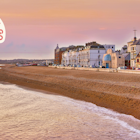
Aug 16, 2023 • 6 min read
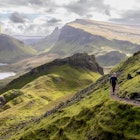
Aug 3, 2023 • 4 min read
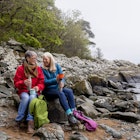
Jun 2, 2023 • 7 min read
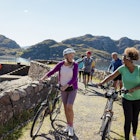
May 26, 2023 • 5 min read
National Geographic content straight to your inbox—sign up for our popular newsletters here
- DESTINATION GUIDE
The essential guide to visiting Scotland
Here’s everything you need to know about this land of lochs—when to go, where to stay, what to do, and how to get around.

Why you should visit Scotland
Monumental mountains and misty glens. Castles with hidden stories. A dram of whisky straight from the source.
Best time to visit Scotland
Spring: Many attractions are open without summer crowds. Golf courses open in April; the season officially starts in May.
Summer: This is the ideal time for hiking and biking, although accommodations along the most popular routes—such as the West Highland Way —fill up well in advance. There are plenty of events, including the Edinburgh Festival and Highland Games .
Autumn: Changing leaves create arresting scenes in forests—it’s a great time to visit Perthshire , known as “Big Tree Country.” The Edradour and Glenturret distilleries are well placed for combining a walk with a whisky sampling.
Winter: The Edinburgh Christmas Market kicks off in November, and Scots prepare to celebrate Hogmanay (New Year’s Eve). On January 25, pubs honor Burns Night —the birthday of national poet Robert Burns —with a dinner of haggis , neeps (turnips), and tatties (mashed potatoes).
Lay of the land
Cities: Well-heeled capital Edinburgh hosts the world’s largest performing arts festival . The medieval Old Town looms over Princes Street gardens and the New Town with art galleries and chic bars. Glasgow is boisterous and friendly, with a lively music scene. Craggy Stirling , topped by the eponymous castle, was the site of several historic battles. On the east coast, Dundee and Aberdeen pack museums and maritime history into their walkable downtowns.
Highlands: Hikers flock to the heather-bound moors and mountains of Cairngorms National Park , overlapping the Speyside whisky-producing region. The landscapes surrounding Glenfinnan and Glencoe have featured in films.
Hebrides: The Isle of Skye is famed for its otherworldly topography. Flawless beaches await on Lewis and Harris . On Mull , stop by the colorful coastal town of Tobermory or scale the rugged slopes of Ben More.
Northern Isles: Neolithic sites, including Skara Brae, are scattered across the Orkney Islands . View Viking sites and the eponymous ponies on the Shetland Islands .
Southern Uplands: Stately homes and castles grace the Scottish Borders. Dumfries & Galloway is home to the Galloway and Southern Ayrshire UNESCO Biosphere and the majestic Sweetheart Abbey .
North East: Seek out royal connections at Glamis Castle in Angus, or Balmoral Castle in Aberdeenshire. Photogenic Perthshire is home to the prestigious Gleneagles hotel and golf course.
Central Belt: Relive the greatest victories of Robert the Bruce and William Wallace at Bannockburn and the National Wallace Monument , respectively. The John Muir Way spans 134 miles of lochs and woodlands.

Getting around Scotland
By plane: Daily flights operate from Glasgow to several Hebridean islands. Flights to Sumburgh (Shetland) and Kirkwall (Orkney) depart from Edinburgh, Glasgow, and Aberdeen.
By bus: National Express and Citylink operate buses between the major cities. Buses are limited in the Highlands and Islands.
By train: ScotRail runs most services in Scotland, mostly along the Central Belt. This reduces to a few main lines in the Highlands.
By car: Driving in Scotland is on the left and requires an international driving permit. Road types include motorways (M), A-roads (A), and B-roads (B). Scotland’s main roads include the A1 from London to Edinburgh; the A74(M)/M74 from Gretna to Glasgow; and the M9/A9, stretching from just outside Edinburgh to Thurso on the north coast.
By boat: Caledonian MacBrayne (CalMac) ferries sail to 21 Hebridean islands; Northlink runs car ferries to Orkney and Shetland. Book well in advance.
Know before you go
Scottish languages: Scots Gaelic (pronounced “gaa-lik”) is still spoken by around 60,000 people, mostly in the Highlands and Islands. English, however, has been the main language spoken in Scotland since the 18th century. Though many believe it to be a dialect, Scots (descended from Northern English) is a distinct language , spoken by 1.5 million people.
Hours: Even in cities, restaurants can keep restrictive hours, with some kitchens closing as early as 8 p.m. On Sundays, businesses often open at 1 p.m. and may close by 4 p.m.
LGBTQ+: Scotland legalized same-sex marriage in 2014. Glasgow hosts Scotland’s largest Pride festival, as well as the Scottish Queer International Film Festival (SQIFF) in autumn.
How to visit Scotland sustainably
Outdoors: Read the Scottish Outdoor Access Code before setting out. Avoid deer stalking areas between July and February. Refrain from stone stacking, which can cause erosion .
Dining: Farm-to-table—or, indeed, sea-to-table—is easy to find in this nation of farmers and fishermen. It’s increasingly common for restaurants to display ingredient provenance on their menu.
Shopping: Seek out independent farm shops and sustainable distilleries . Support Scottish artisans at rural markets and festivals, such as the Pittenweem Arts Festival . Check labels to be sure the products you’re eyeing were made in country.
Accommodation and attractions: The Green Tourism certification scheme, which now operates in 20 countries, was founded in Scotland. It assesses 70 criteria, such as ethical production, carbon, and waste. Certified members—including accommodations, attractions, and tours—display a Green Tourism plaque.
What to read
Scotland: A Concise History , by Fitzroy Maclean (Fifth Edition). The former soldier and politician brings bloody battles and national heroes to life. In the fifth edition, journalist Magnus Linklater adds chapters on Brexit and the 2014 independence referendum.
Rival Queens , by Kate Williams. The historian charts the alliance between Mary Queen of Scots and Elizabeth I of England, which ends in devastating betrayal.
Rob Roy , by Sir Walter Scott. The celebrated writer’s classic work takes place during the Jacobite Rebellion of 1715.
Raw Spirit: In Search of the Perfect Dram , by Iain Banks. A humorous travelogue of Scotland’s distilleries, from the iconic to the obscure.
( For more tips on what to do in Scotland, see our Explorer’s Guide .)
Related Topics
- CITY GUIDES
- CULTURAL TOURISM
- PEOPLE AND CULTURE
You May Also Like

The essential guide to visiting Ireland

10 whimsical ways to experience Scotland
Free bonus issue.

10 best things to do in Maine

Visiting Ireland? Here’s what the locals love

The essential guide to visiting Alaska

The essential guide to visiting Texas

Visiting Maine: Here’s what the locals love
- Environment
- Perpetual Planet
History & Culture
- History & Culture
- History Magazine
- Mind, Body, Wonder
- Paid Content
- Terms of Use
- Privacy Policy
- Your US State Privacy Rights
- Children's Online Privacy Policy
- Interest-Based Ads
- About Nielsen Measurement
- Do Not Sell or Share My Personal Information
- Nat Geo Home
- Attend a Live Event
- Book a Trip
- Inspire Your Kids
- Shop Nat Geo
- Visit the D.C. Museum
- Learn About Our Impact
- Support Our Mission
- Advertise With Us
- Customer Service
- Renew Subscription
- Manage Your Subscription
- Work at Nat Geo
- Sign Up for Our Newsletters
- Contribute to Protect the Planet
Copyright © 1996-2015 National Geographic Society Copyright © 2015-2024 National Geographic Partners, LLC. All rights reserved
- Jump to main content
Scroll to main content
From pristine beaches to magnificent castles, exciting cultural attractions and ancient heritage, Scotland has it all. Come pay us a visit. We promise you won't be disappointed.
Events & Festivals
Travel essentials, visa and immigration, accommodation, getting around scotland.
Sure, we have stunning castles and monuments. Yeah, we have more than 460 museums and galleries. Of course, we have internationally-renowned, national performance companies. However, we’re also an amazing hotbed of new and emerging music, home to one of the largest concert venues in the UK and have a well-earned reputation for putting on a party and having a great time.
Learn more about Scottish culture
Food and Drink
Learn about scotland, map of scotland, money and currency, safety and inclusivity.

Scotland Travel Guide
Your ultimate scotland travel guide, with tips, and things to see and things to do in scotland. great for first-time and returning travelers..
Found in the northern third of the United Kingdom is the great country of Scotland.
Known for the warmth of its people, lush greenery and mountains, beautiful coastlines and beaches, medieval castles, and rich history, Scotland is a place like no other.
It is perfect for those who find the beauty in nature. Made up of almost 800 small islands, there is a lot to see and explore here.
This Scotland travel guide will help you plan your next vacation.
Popular Guides
- Things To Do in Edinburgh
- North Coast 500
Our Highlight
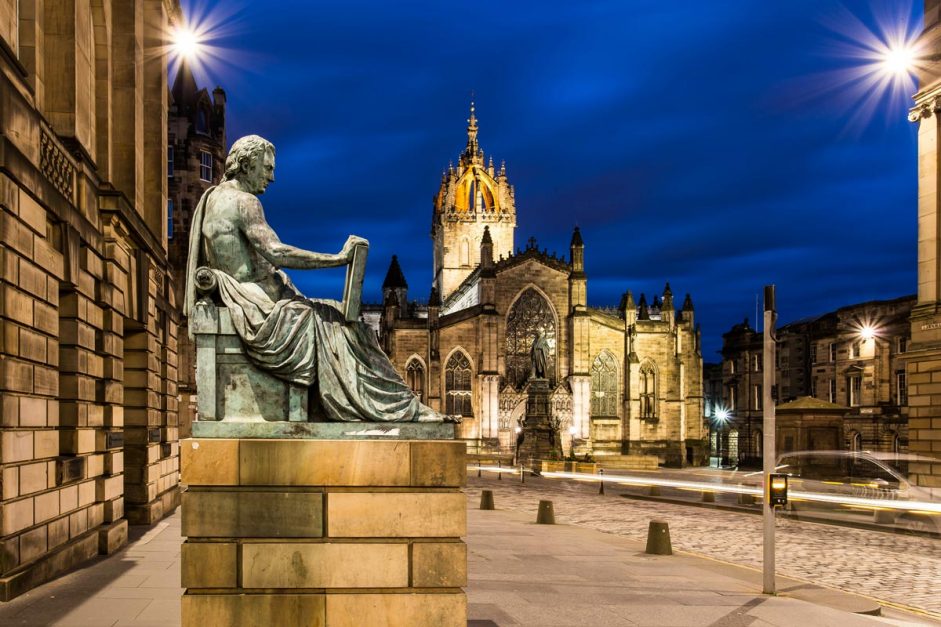
Table of contents
Table of Contents
Fast Facts about Scotland
- Currency: Scotland currency is the Pound sterling (£) and 1 pound sterling is equal to 1.25 USD.
- Power: Scotland power voltage is 230v 50 Hz.
- Visa: Tourist Visas are not required when visiting Scotland. All that is needed is a U.S. passport that has been valid for at least 6 months prior to visiting Scotland.
- Best way to get around: Renting a car is considered the best way to get around Scotland. You must be over 21 to rent a car.
- Driving in Scotland is done on the left-hand side of the road!
- SIM Cards: The most common cellular networks in Scotland are Orange, O2, and Vodafone. You can purchase a UK SIM card to connect your phone to one of these.
- Value-added tax (VAT) is applied to most goods in Scotland. Visitors may be able to reclaim these taxes based on the store and amount purchased. For more information, click here. http://www.rampantscotland.com/know/blknow_vat.htm
Things to See and Do in Scotland
- Edinburgh Castle : Take a guided tour through this medieval and world-famous castle. Visitors will get to learn about the fascinating history behind this castle while exploring the castle up close.
- Culloden Battlefield is the historic site of the last battle to take place on British soil in 1746. This battle is frequently referred to as one of the most important for Scotland, as it marked the end of the clan system in the highlands.
- Kilchoman Distillery: Learn everything you wanted to know about whiskey and how it’s made. Stay for lunch at their café, try some coffee or cake, or enjoy whiskey tastings.
- Drive the North Coast 500 – Scotland’s epic road trip takes you around the entire northern route of the country through the highlands, past impressive sea cliffs and through the land of castles and distilleries.
Scotland Travel Guides
- Dunrobin Castle
- Dunnet Head
- Clava Cairns
- Culloden Battlefield
- Things to do in Inverness
Accommodation
Budget: For those on a budget, Scotland offers many hostels at roughly 20 pounds per night. Many have shared bathrooms, but you can upgrade to get a private bathroom in some if you’re willing to pay more.
Mid Range: These typically cost £60 to £100 per night and often come with complimentary breakfast as well as free Wi-Fi. Scotland also offers plenty of bed and breakfasts around the same price.
High End: For those who wish for a unique experience, Scotland offers plenty of high-end castle hotels. These castle hotels are rich with history and offer plentiful views. Prices tend to fall in the £100 to £350 range. In the smaller cities, it might be best to check out VRBO for more of a selection.
- Check out our favorite booking platforms Booking.com , Tripadvisor and VRBO for the best deals on accommodation.
You can find a variety of pubs and street food in Scotland.
The national dish is haggis, a meat pudding served with mashed potatoes and turnips. Expect to pay around £30 per day for food.
The Best Ways to Get Around Scotland
Getting to scotland:.
Getting to Scotland: For those flying to Scotland, the Edinburgh Airport or Glasgow Airports are two of the main airports and are conveniently just 7-8 miles from the city center.
You can check for the best flights to Scotland on Skyscanner .
Transportation:
Bus: When you need to get around the city, the bus is a cheap option. They run all throughout the day and cost around £2-5 depending on where you go
Train: Trains are available throughout Scotland and tend to cost at least 20-40 pounds for a one-way trip depending on how far your journey is. This is a great way to get to major cities if you don’t have a car, as routes such as Glasgow to Edinburgh only take an hour.
Car Rental: By far the most flexible way to discover the country is by renting a car . It is fairly reasonable ($40/Day) and allows to reach those charming little towns you might not otherwise be able to discover.
Just remember they drive on the left-hand side of the road and almost all cars are manual transmission. If you want an aoutomatic you will have to pay more.
When to go To Scotland
June to August is considered the best time to visit Scotland, as this is Scotland’s summer months. This is also the peak of tourism.
For those who want to avoid the crowds and perhaps get better deals, the spring season (late March to May) is a good period to go.
There is also little difference in weather between the spring and summer seasons, so you can still enjoy plenty of great weather, with temperatures around 59 degrees Fahrenheit.
Where to Stay in Scotland
Grand Central Hotel : Located right in the city center of Glasgow, this Victorian hotel is 4 stars and offers many attractions. Take a stroll through the shopping district, walk to Central Station to visit more of Glasgow, or dine at the hotel’s very own restaurant and bar. This hotel also offers the best in high-speed Wi-Fi.
Radisson Blu Hotel Edinburgh : Shaped like a castle, this four-star hotel comes with 24-hour room service, a spa and health club, and its own restaurant and bar. Located in the famous Royal Mile, you get to see amazing sights and history of Edinburgh. The Edinburgh Castle, National Museum of Scotland, and shopping area are all within walking distance from this hotel.
The Chester Hotel : This contemporary and classy hotel is in the heart of West End Aberdeen. Enjoy some of the best in hospitality, with rainfall showers, Egyptian cotton sheets, and designer toiletries. Explore more of Aberdeen or stay indoors for some afternoon tea and cake.
Scotland Accommodation Guides
- Where to Stay in Edinburgh – A Guide To The Best Places and Neighborhoods
- 3 Days in Edinburgh – The Complete Edinburgh Itinerary
- Things to do in Inverness – The Capital of the Scottish Highlands
What to Pack for Scotland
Packing tips.
Scotlands weather is relatively mild throughout the year except in the Highlands. Rain can be exp[ected at anytime so pack accordingly.
- Pack a raincoat – chances are that you will encounter rain no matter what month you travel. A light rain shell is highly recommended as it will combat the rain AND wind you will probably face in Scotland.
- Layers – As Scotland has diverse weather, it is best to bring clothes with multiple layers to accommodate the changes in temperatures. Scarfs, sweatshirts, gloves are all good options. For travel during winter months, make sure to bring a heavier coat as air frost can be common in certain areas.
- Footwear – Pack a pair of lightweight, durable, waterproof and comfortable shoes and/or a pair of light boots with lugged soles and ankle support if you plan on doing a lot of hiking
- Classic Basic items – You do not need to be a fashionista to blend in. The key is in embracing neutral toned items that can be mixed and matched easily. Avoid logos, baseball caps, shorts, hoodies, flip-flops, and running shoes as these items scream tourist!
Scotland Travel Guide: Best Booking Resources
Whenever we travel to we make sure to start with these companies. We have tried a lot of different ones over the years and all of these have consistently proven to be the best when it comes to offering great prices.
We have used every one of these personally and continue to do so.
- Booking.com : This is our go site to when comparing prices for accommodation. It usually has the cheapest prices, especially in Europe and we love their interface. Not to mention you get free cancellation and you are guaranteed the best price.
- Trip Advisor : What we like about Trip Advisor is that we can look at all the reviews and then book our accommodation. TripAdvisor is where we go when we want to compare prices with multiple accommodation providers.
- VRBO : is the main search engine we use when we are looking for a home or apartment rental. It can sometimes be cheaper than hotels and it is the best way to stay in areas that offer a more local feel.
- Hostelworld : With one of the largest databases of hostels in the world, Hostelworld is the go-to site when you are looking for budget accommodation.
- Skyscanner : This is the first place we check for flights. It consistently comes back with the cheapest and best options. It allows us to compare a lot of airlines to get the best price.
- Rome 2 Rio : If you want to see how to get somewhere by plane, train, bus, ferry or car Rome2Rio lays it all out for you as well as related costs.I love how they show it all to you on a Google Map and it works offline.
- Get Your Guide: For all your day trip and city guide needs, we use Get Your Guide. It has the world’s largest collection of things to do with more than 30,000 activities in 7500 destinations.
- World Nomads Insurance: When traveling to Italy you should always have travel insurance. We have found the best bang for your buck is by far World Nomads.
Scotland Travel Guide: Related Articles
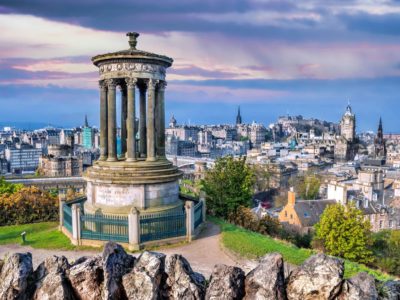
25 Best Things To Do in Edinburgh, Scotland In 2024

26 Best Things to do in Scotland in 2024
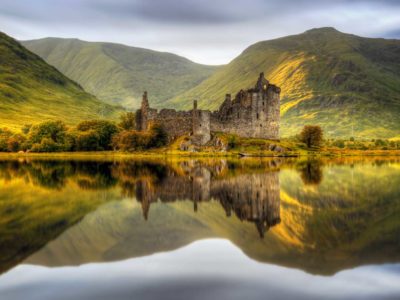
15 Best Castles in Scotland to Visit in 2024

50 Scotland Travel Tips For An Unforgettable Trip
Last Updated on March 16, 2024
On my first visit to Scotland, there was so much that I didn’t know when I arrived. SO. MUCH. And as I scrolled through my Scotland content, wondering what else you guys would need to plan a perfect trip, I was dumbfounded that I had not written any Scotland travel tips?! SO, here I am, presenting a whopping FIFTY tips that will help you traverse your way around Scotland whether that be in the highlands, islands, cities, mountains, hills, valleys, and everywhere in between! This blog post might just be one of my favorites that I have written yet! I really want to start doing this for all the other destinations that I have visited: Iceland, Bali, The Philippines, Japan, Utah, and more, so keep an eye out for those up and coming posts on the blog!
Without further ado, here are fifty Scotland travel tips that will enhance and improve your traveling experience in this magical land!
This post may contain affiliate links for the products I mentioned, but as always, all opinions are my own. I make a small commission , at no extra cost to you, when you make a purchase or booking through these links. This helps to support this space and keep me blogging, which I am so extremely thankful for.
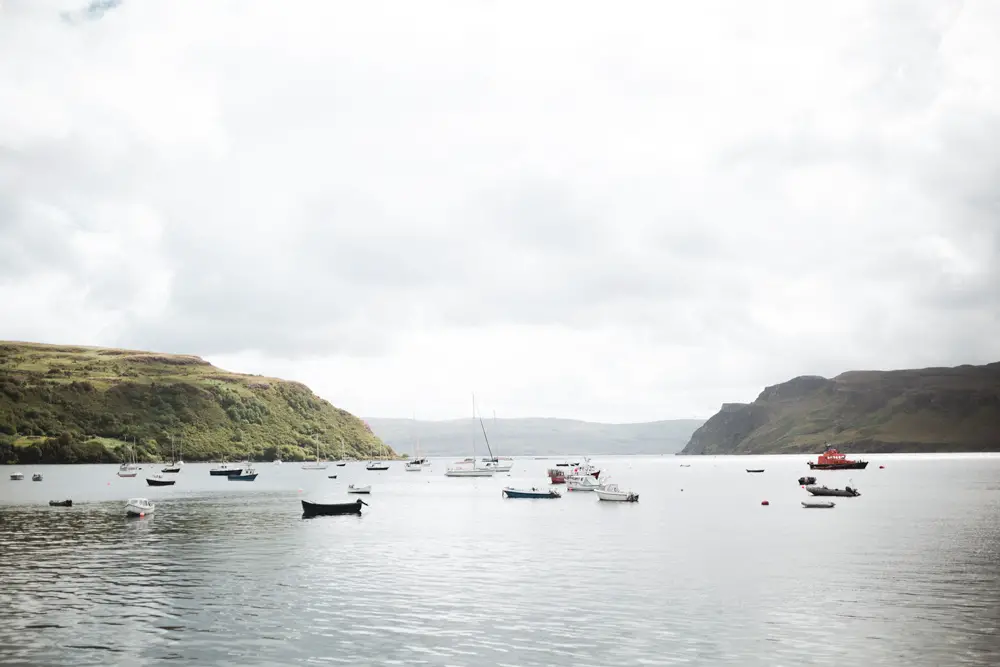
Tips For Planning + Booking Your Trip To Scotland
1 | plan time to explore more than just the major cities and touristy locations. .
Every part of Scotland is beautiful no matter where you go, but block off some extra time to go off the beaten path, explore some of the western islands, and even the northernmost parts of Scotland. Whenever I traveled there, I was with a large group for a tournament so I really only got to see the highlights, which, don’t get me wrong, I was still blown away, but I wish I would have gotten to see St. Kilda (a double UNESCO World Heritage Site), The Outer Isles, The Outer Hebrides, The Northwest Highlands, and a lonnnnnnng list of other sites. Your trip is going to be special regardless, but dig a little deeper in your research and find those places that will make your trip special.
2 | Plan Your Own Highlands Roadtrip > Booking A Guided Tour
Highland tours are expensive, they don’t give you any flexibility, and you’re not able to choose when you arrive in certain places, which means that you’re going to arrive in places at a similar time as all the other tour buses. The best option if you want to explore the Isle of Skye, The Highlands, or anywhere else outside of the major cities in Scotland, renting a car and crafting your own tour is going to be the best option. Hell, you could even rent a campervan and REALLY get that full Scottish road trip experience!
3 | Get To Know The History
Scotland is chalked full of history and stories about practically everything that you’re going to see and when you know of the stories and history, you’ll appreciate everything you see a whole lot more, at least I did. The key thing here is to bring a guidebook that will also teach you the history of the locations. You will look at certain landscapes, castles, and hikes with a different perspective once you dive deeper into their cultural stories and history of them.
4 | Book Excursions, Day Trips, And Tours Ahead + Online
I rarely end up booking things ahead of time, but in Scotland, booking online and in advance is going to save you some money and guarantee you a spot. If you’re planning on riding the Glenfinnan Viaduct (AKA The Harry Potter Train), you want to book several months in advance no matter the season. If you’re really keen on saving money, check out my other tips for traveling Scotland on a budget !
5 | Spend More Than Just A Day In Major Cities Like Edinburgh + Glasgow
You can easily see the highlights of Edinburgh like The Royal Mile, Edinburgh Castle, and many other iconic spots in a day, but spending more than a day, ideally three days in Edinburgh is going to get you into the Scottish groove, possibly into some shenanigans, and a more thorough experience of the city. The same goes for Glasgow!
6 | Get Into The Scottish Spirit Before You Head Out Via Books + Movies
Scotland is the setting for many iconic movies and tv shows. To name a few, Game of Thrones, Outlander, Braveheart, Monty Python and the Holy Grail are all recognizable, more mainstream movies that will get you into Scotland before you even leave for the airport. However, as I just said, these are all pretty mainstream, some even being historically inaccurate, so if you really want to explore the true Scottish culture, ‘The Sunshine On Leith’ and ‘Trainspotting’ are both great movies to start with and the Outlander series are great books to go to from there.
7 | The best way to get around the city is by foot and public transport and the best way to get around the highlands is in your own rental car.
Once you get into the cities, there really isn’t a need to rent a car until you leave to go to the more wild parts of Scotland. You can get around the vast majority of the country via public transportation, but a car allows you to squeeze into those little roads and explore more off the main areas. There are some parts that a large bus cannot get to, so having your own car is going to give you access to absolutely EVERYTHING.
8 | Scotland has its own currency, but it is valid all across the United Kingdom. The same goes for England and Northern Ireland currencies.
The prints on the currency vary depending on the bank that printed them in Scotland, but the Scottish currency can be mixed and matched with other currencies in the United Kingdom. It would basically be like if Texas printed it’s own dollar bills and I was visiting California, they are both technically the same currency, just different prints.
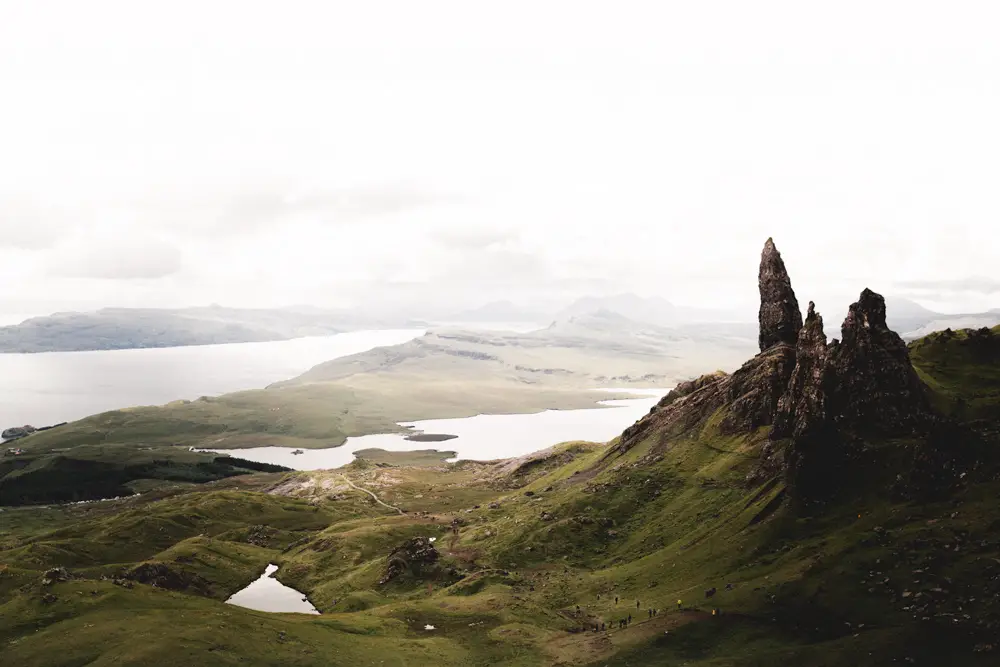
Packing + Adventure Tips For Scotland Travel
9 | use every opportunity to exercise scotland’s ‘right to roam’ law, but be respectful of the land and clean up after yourself. .
Back in 2003, Scotland passed its ‘Right to Roam’ law that allows both tourists and locals to enjoy Scotland’s land and waters no matter who owns them. This means that wild camping is legal, AND you can expect to find some hidden and spectacular locations! If you do choose to exercise this, PLEASE make sure that you don’t leave any trash, destroy the natural environment, and leave the place how you found it.
10 | Pack the proper gear that will keep you warm and dry.
When I think of warm and dry, I think of my absolute favorite hiking essentials: my cozy fleece , stylish yet still functional raincoat , waterproof pants , and my tried and true hiking boots ! If you’re out on a hike, or outside in general, you don’t want to end up a soggy mess, so I recommend investing in some high-quality gear if the outdoors is a large part of your life. Start out with some warm baselayers like the Patagonia Capilene Thermal Baselayers , and then layer up with the rainpants and outer shell. This is what my current layering system looks like:
Patagonia Capilene Midweight Longsleeve > T-Shirt > Sweater / Fleece > RAINS Classic Raincoat
Patagonia capilene midweight bottoms > leggings > mountain hardwear ozonic stretch pants.
This way I was able to strip down or add layers as the weather changed throughout the day!
11 | Pack comfortable shoes!
This is the FIRST thing you should even consider putting on your Scotland packing list because the hills and cobblestone streets are not going to do your back, hips, arches, or toes ANY favors. I made the mistake of trying to wear Vans around the city and let me just say, YIKES. I haven’t found the perfect pair of casual, yet still comfy walking shoes yet, but I want to give these adorable white sneakers a go, since they match with everything, but bring the pair that works best with your feet and back!
12 | “If you don’t like the weather, just wait a minute”
You can be in sunny, beautiful, partly cloudy weather one minute and then drive through a torrential downpour the next, seriously. It is both a blessing and a curse, but that is why you pack and wear those layers so that you’re unstoppable!
13 | Don’t rely on an umbrella to keep you dry; you’ll end up soggy.
If you encounter a light drizzle, sure, an umbrella will do the job, but when that afternoon, torrential downpour occurs, that umbrella is useless. Which is why I recommend having a waterproof shell, AKA a waterproof jacket, pants, and shoes that will keep your whole body dry!
14 | If you’re planning on taking a road trip, watch out for sheep on the road!
You’ll see these fluffy lil’ guys all over the country! Be careful on the roads and stay vigilant!
15 | Don’t stop in the middle of the road or street to take a photo.
If you try and stop in the middle of a bust street or road, 1. you might get hit, and 2. you’re going to get dirty looks and probably called a couple of names for not going off to the side. There are beautiful places all over Scotland, but make sure you walk to the side or pull off onto a spot on the side of the road before you take your photo.
16 | There are people that still speak Scotlands original language of Gaelic, so you will spot some bilingual signs on the road.
Practically everyone speaks English in Scotland, but as you veer away from the major cities, the more prominent Gaelic will be!
17 | If you get yourself into a bad situation where you need medical or emergency services, the phone number is 999.
There are tons of outdoor activities, hikes, and excursions that just might get you into a sticky situation. Ideally, you’ll never need this number, but just in case you need emergency help, the number is 999.

18 | ^^ and if you do need to make a call, that’s why it’s best to get a local, Scottish SIM card.
Throw you international phone plan out the window and step into the world of local SIM cards, my travel savior and my favorite way to stay safe while traveling . Generally, international phone plans cost around $10/day if it doesn’t already come with the plan you have, and that is WAY too much, especially if you travel for longer periods of time like I do. I’m not trying to drop that much coin to use my phone, so I opt-in for SIM cards, which are a one time fee, generally never over $30-40 USD, that will allow you to use your phone across the country you’re traveling in! You can make local calls and texts as well, so it’s a great way to save money and stay safe! All you have to do is make sure your phone is unlocked so you can pop out your SIM from home.
19 | The remote parts of Scotland are REALLY remote, so know where you’re going and don’t wander so far that you can’t find your way back.
This is true in Scotland, The United States, Europe, and really anywhere that is rich in nature, so just don’t do anything stupid, know your limits, and don’t go so far that you get lost and have to call the emergency number. I do encourage everyone to exercise the legality of wild camping, but just don’t be dumb, like with anywhere else you travel to.
20 | Get lost in the wildlife + help save it!
Something that I found out recently via a Scottish Youtuber was that Scotland is in a major climate crisis due to 1-in-11 of their wildlife in threat of extinction, illegal wildlife hunting, and other practices that have destroyed the natural landscape and wildlife.
She says, “We need to show the Scottish government that wildlife is valuable and worth saving. So come to the Isle of Mull to see white-tailed sea eagles and otters, come to Shetland to go whale watching, come and see the Eurasian beavers in Argyll and the ospreys that make the trip from Africa to the Cairngorms every year. We need to show them that ecotourism and wildlife tourism are greater assets to the tourism industry and the economy than shooting estates are.”
You can watch her video here and she describes the entire situation very very well.
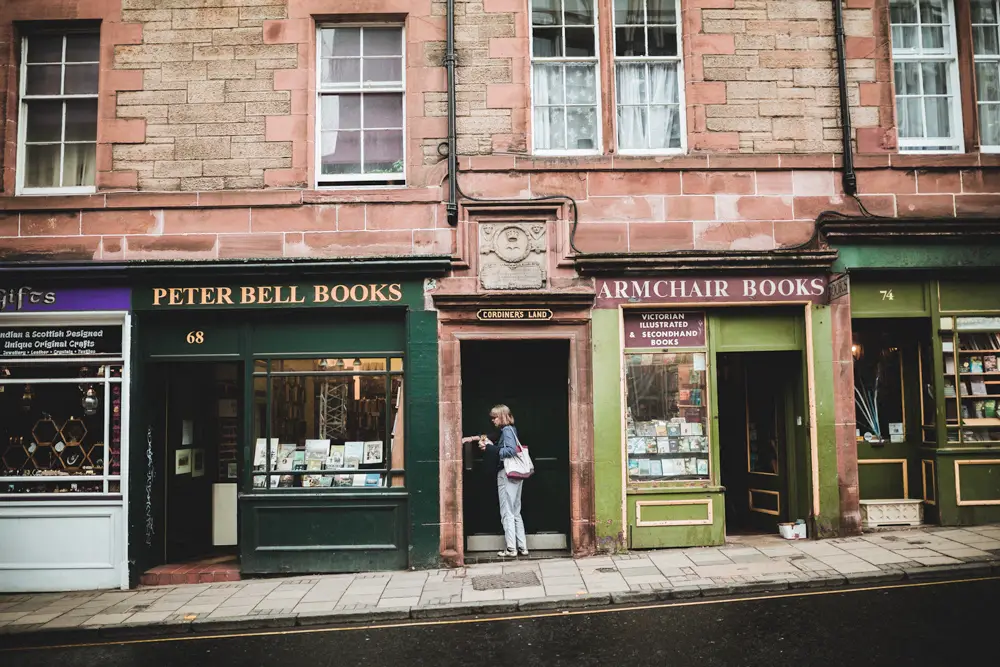
General Scotland Travel Tips + Tips For On The Road
21 | scotland is not england or a part of england. .
Some people get confused and think that Scotland and England are the same thing, or at least within the same realm, and that is totally false. Scotland is very much its own country and is a part of the United Kingdom, which is made up of England, Scotland, Wales (that make up Great Britain), and Northern Ireland. So, yes, Scotland is its own country and even the accents there are drastically different than they are in England.
22 | English is widely spoken, but you may not understand what they’re saying. Just ask them to repeat it again slowly.
Understanding a Scottish accent is going to get easier and easier as you spend more time in the country, but at the beginning, sometimes you really need to focus on what they’re saying to understand. If it all goes over your head the first time, just ask them to say it again more slowly, and don’t feel dumb or embarrassed for having to ask because some of those accents are thick!
23 | Dive into some Scottish slang words before you arrive.
With the heavy Scottish accents around, knowing a couple of slang words is both fun to know and good practice when you’re traveling to a new place. Some great words to know are wee, dram, bevvy, + tatties!
wee / wee bit | a little bit
Bevvy | a drink, juice | anything that isn’t alcohol (juice), ah dinnae kin | i don’t know, tatties | potatoes, awright | are you alright / i agree / yes, braw | good, blether | you talk a lot / you talk a lot of rubbish.
Eager to dive deeper into Scottish slang? My friend Graham from My Voyages Scotland has the PERFECT guide!
“Scotland has a whole host of different dialects from north to south and east to west. Event the Scots themselves can get a bit confused as someone from Stornoway may have a completely different saying for something that a Glaswegian has. Read this guide to Scottish Sayings before heading to Scotland to make sure you do not get lost in the many different regional sayings. And remember, everyone can always revert to ‘proper’ English if asked!”
24 | Cards are widely accepted, especially in major cities, but keep extra cash on you once you venture outside of them.
This is a travel tip that goes beyond just Scotland, but most of the time, the farther you are from a major city, the less likely they’re going to accept cards. It’s best to keep cash enough cash to last you at least a couple of days: not so much that if you’re robbed you’re screwed, but not so little that you’re screwed if they don’t accept cards.
25 | Don’t shy away from public transportation. It can save you a lot of money!
Every time I travel somewhere in Europe, I am blown away by the efficiency of their public transportation systems. Living in the US, basically, if you’re outside a city and don’t have a car you’re screwed, but this is not the case in Scotland! You can use buses or trains to get around and in between major cities and other places around the country and it’s a whole lot cheaper than renting a car! When you’re looking at how to get around, don’t forget to check out routes and prices for buses and trains!
26 | If you decide public transport is your way to get around Scotland, consider buying a Scotrail pass.
A Scotrail Pass is great if you plan on going all around Scotland via bus/train/etc.. There are multiple ticket tiers that you can buy for your individual trip, which you can view here , and they cover buses, trains, ferries, trams for whatever region you choose to buy your ticket for. It is quite useful whether you plan on hopping around a certain area or thoroughly traveling the whole country. It isn’t always the cheaper option, so compare rates before you buy to make sure it’s worth it for you.
27 | Taking the bus? Bring exact change!
The bus drivers don’t give change back if you overpay, so make sure that you have smaller coins to pay the transport fees! There are also day passes available for purchase so that you don’t have to worry about getting the change right every single time.
A lil Update | January 2020
I was notified via the comments from a traveler that visited Edinburgh recently and the bus drivers were able to give him exact change back for his ride! It looks like some changes are being made to help things run a little smoother, so an exact change may not be necessary as you can now pay with a card as well!
28 | Tipping is customary in Scotland, but the standard is 10%.
Tipping culture isn’t as widespread and stressed as it is here in the United States, but the standard is 10% for services, but there are some exceptions:
Taxis | Round up to the nearest pound
Hotels / tours | none, 29 | sales tax is included in all the prices, so you’ll always know exactly what you’re paying..
Unlike SOME places, ahem *cough* the United States, the prices that you soo on products and goods is exactly what you’re going to pay for that item. All the tax is included in the price so you don’t have to play guessing games as to how much something actually costs. This was a really nice switch coming from the United States and I’ve always wondered why we don’t do that ourselves… At any rate, this makes buying things SO much easier!

Tips On Scottish Food, Drinks + Culture
30 | the local foods and dishes are very interesting but try them, and then ask what they are or try veggie versions of them.
Haggis and black pudding are two foods that you for sure want to give ago while you’re in Scotland. I didn’t try them since I am vegan, but some of Edinburgh’s best vegan restaurants serve a veggie version of this dish that is quite tasty! If you’re not vegan, ask what the food is after you’ve tried it so it doesn’t steer you away from eating it. It’s all in the fun and mystery of experiencing Scotland!
31 | Get restaurant and meal recommendations from locals instead of eating at all the touristy restaurants.
Scotland’s cities are chalked full of incredible local and international cuisine; seriously, it’s some of the best food I’ve tasted! Not to mention, touristy restaurants are expensive, typical, and not as high-quality food than real local dives in the city. Food is probably, like, half the reason I travel to places so I looooooove trying new dishes and combinations while I travel. I know some people don’t care for the food in certain places, but if you can manage it budget-wise, try out local breakfast spots instead of the one offered at the hotel and go out of your way to find those special places!
32 | Indulge in the whisky and craft beers while you’re here.
While you’re in Edinburgh, make sure you pay a visit to the Scottish Whisky Experience ! They have a display of over 4,000 bottles of whisky and it is one of the seven wonders of the Scotch whisky world! Also, the Scots know how to party, so don’t shy away on having some fun and trying new drinks!
33 | When you order a scotch, don’t take it like a shot. It’s meant to be sipped and savored.
Many people make the mistake of ordering a scotch and tossing it down the hatch immediately, buuuuuuut you’re going to get some looks if you do that. Slow down and savor the flavors!
34 | The vegan/vegetarian food scenes in Glasgow and Edinburgh are some of the best in the United Kingdom! I had some of the best vegan breakfasts , coffees , and dinners while in Edinburgh!
I didn’t know if I was going to starve or indulge while I was in Edinburgh, and I am pleased to say that I indulged! There are many incredible restaurants that offer vegan, vegetarian, and gluten-free options for visitors, so check out the links above and scope out some awesome eateries!
35 | The men do wear kilts (do not call it a skirt) and the pattern on it is called tartan, not plaid!
Kilts aren’t a taboo thing in Scotland. In fact, each clan has its own specific tartan that has been passed down over generations! It’s not uncommon to see these on the streets of Edinburgh, but not everyone is going to be wearing them. Back in the 19th century, kilts became formal wear that was only worn for ceremonies, weddings, and sporting events, but they’re slowly making their way back into informal, casual wear, so expect to see them while you’re strolling around the cities and highlands!
36 | Whatever you do, don’t lift up a man’s kilt!
Well, okay, not that you would do that anyway, but don’t say I didn’t warn you (;
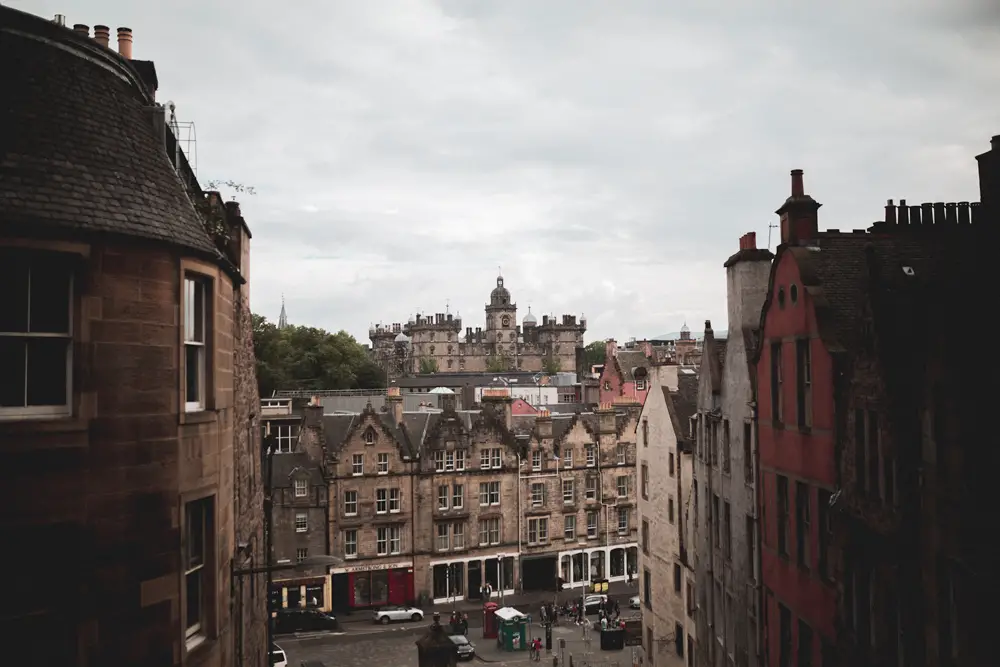
Tips For Visiting Edinburgh
37 | edinburgh is pronounced ed-in-burr-uhh, not ed-in-burg (i messed it up the first time too lol)..
Come to my surprise, and maybe yours as well, the g is silent in Edinburgh… I looked like a total goober pronouncing it with the g the first time I ever tried to say it, so make sure you the correct way, which sounds way cooler than what I thought it was.
38 | Avoid traveling to Edinburgh in the month of August unless you’re attending The Fringe Festival.
Edinburgh turns into an absolute zoo in the month of August from the Fringe Festival , so unless you’re planning on paying it a visit, I would avoid this month. The prices skyrocket, the crowds are massive, and it’s an all-around madhouse among the streets. Personally, there isn’t really a bad time to visit Scotland, much like most other countries around the world, as long as you pack the proper gear and attire! If you want to avoid crowds, go in the spring and summertime!
39 | Among your time in Edinburgh, consider a day trip to Glasgow. You don’t want to write it off your itinerary!
Glasgow is only an hour away from Edinburgh by bus, so make sure you head over there and roam around for a day. I wasn’t able to visit myself, but I know many people who love Glasgow over Edinburgh, and vice versa! Take the time to see both, indulge in both cultures, and decide for yourself!
40 | Stay in Airbnb’s and guesthouses over hotels to save money and experience Scottish culture. You’ll also want to book this in advance as they fill up fast!
Hotels are more than likely going to be close to the Royal Mile, AKA expensive, so I recommend renting out a flat or apartment through Airbnb to get a feel for local life, save a bit of money, and have a unique experience! That isn’t to say that this is an uncommon practice, so book as soon as you can! These places book up fast!
41 | Edinburgh is a busy, popular city year-round, so get to more touristy places, like Edinburgh Castle, as early as you can to avoid crowds.
I believe we can all admit that a large crowd can really damage an experience, that is unless you’re attending an awesome concert, so I suggest that you get to popular places like Edinburgh Castle, The Royal Mile, St. Giles Cathedral, The Elephant House, Arthur’s Seat, and many other popular destinations either when they open or as early as you can. This tip is more stressed in the summer months since those are a lot busier than other times of the year, but I always think this is a great practice to have no matter where you’re traveling to! Early bird gets the worm (and the best photos)!
42 | Walk the Royal Mile more than once. You’ll see new things every single time.
Since I was in Edinburgh for a tournament, I walked up and down the Royal Mile multiple times and I saw new shops every single time. There is so much you miss and look past if you only walk it once, so if you can manage the time and are up to hunt down some wee shops, do it! You’ll find some true treasures! If you only have a day in Edinburgh , use that time to explore as many of the treasures of the city that you can! There is a lot to see!
43 | Explore the outskirts and small villages of Edinburgh like Leith and Stockbridge. You’ll escape crowds and feel like you’re in a fairytale!
If you’ve ever imagined a Scottish fairytale, Leith and Stockbridge are those imaginations coming to life. These villages are quaint, floral, adorable, picturesque, and everything in between! The best part is that not many people roam out to these two spots, so you’ll be able to see the quieter towns and sides of Edinburgh!
44 | Get lost and take the stairs.
There are many ‘closes’, random stairways, and other corridors that are begging for people to come and get lost in (in a good way). If you see a small alleyway or staircase going down somewhere, GO! It is going to lead you to some awesome, hidden and beautiful parts of the city!
45 | Geek out at all of the Harry Potter spots in the city: Greyfriars Kirkyard, The Elephant House, Spoons.
If you didn’t know already, J.K. Rowling wrote and gathered inspiration for Harry Potter right in the heart of Edinburgh! I can understand how because it’s hard not to be inspired in a city like this! If you visit the Greyfriars Kirkyard, you’re able to see Professor McGonagall and Tom Riddle’s gravesites, which are known for being an inspiration for these characters! Also, you can pay a visit to The Elephant House, which claims to be the birthplace of Harry Potter, but it is more likely that she wrote the first book of the series in a cafe called Nicholson’s own by one of her relatives at the time, which is now called Spoons. The Elephant House tends to be extremely crowded, so if you want to avoid that, but still feel the magic, pay a visit to Spoons, instead!
46 | Spend a night watching a classic or modern film at The Cameo Picturehouse.
The Cameo is one of the oldest cinemas in Scotland that is still in use! It was built back in 1914 and most, if not all, of the original decor, has either been restored or kept as is. If you want to take a deep dive into a taste of what life was like back in the 1910s/20s, pay a visit here and step back in time!
47 | Avoid the typical tourist souvenir shops and get a handmade souvenir while you’re in the highlands, Isle of Skye, or other parts of Scotland.
Most of the souvenirs on the Royal Mile are massed produced, overpriced wares that are not worth holding your memories of Scotland in. Once you venture out into the highlands and more remote parts of Scotland, find a local artist or artisan that you can buy a unique souvenir from, such as pottery or a piece of art. This way you’re giving back to the local community and you have something more special than, let’s say, a t-shirt or shot glass.
48 | If you’re there on a weekend, go to the farmer’s market to try local produce and local vendors!
Heading to the Edinburgh Farmer’s Market on a fine Saturday morning was one of my favorite things I experienced during my entire time in Edinburgh! I ate some drool-worthy vegan food, bread, and even picked up some skincare items that I loved every last drop of! I recommend picking up some Scottish strawberries and tomatoes and sourdough from the local bakery vendor. The market is right under Edinburgh Castle so it’s a great place to visit after you’re done exploring the quarters.
49 | DO visit one of Edinburgh’s festivals!
Indulge in art, music, and movies during the Fringe Festival or party like there’s no tomorrow at the Hogmanay Festival ! If there is one thing for sure, the Scottish sure know how to host a party!
50 | If you want to get really crazy, hit up Scotland’s Viking Festival, Up Helly Aa , in Lerwick, Shetland!
This party is so wild that people even say its bigger than Christmas… Yes, CHRISTMAS. Must be pretty off the chain if you ask me! It normally takes place in January each year and is filled with fire, food, and fury! If you need any information about the festival, that is linked above and if you need information on staying and getting to Shetland, then you can visit their tourism website here for all the information!
LOOKING FOR MORE SCOTLAND TRAVEL RESOURCES? CHECK THESE OUT:
– The Best Time To Visit Scotland
– The BEST Scotland Packing List For Summer
– The Ultimate 10 Days In Scotland Road Trip Itinerary
– 10 Tips For Traveling Scotland On A Budget
– 72 Hours in the Isle of Skye
– Hiking The Old Man Of Storr: The Isle Of Skye’s Crown Jewel
RESOURCES FOR VISITING EDINBURGH:
– 3 Days In Edinburgh: The Ultimate Itinerary for Edinburgh, Scotland
– The 8 Best Day Trips From Edinburgh You CANNOT Miss
– The 10 Best Hostels In Edinburgh For A Magical Stay
– The Best Coffee Shops In Edinburgh: 15 Cafe’s You Can’t Miss
– The 10 Best Mouth-Watering Vegan Restaurants In Edinburgh
– The Top 15 Places To Get A Vegan Breakfast In Edinburgh
Do you have any useful tips for traveling Scotland? Share with me in the comments below!
Did you find these Scotland travel tips helpful?

Sample Content

Leave a Comment Cancel reply
Your email address will not be published. Required fields are marked *
18 comments on “ 50 Scotland Travel Tips For An Unforgettable Trip ”
I love that you list all of these great travel places and the comes my humble state of Utah. Most out of country (and state for that matter) don’t realized how beautiful it is. From desert to mountains, we have it all. The red rock areas are the most beautiful. Can’t wait to see your travel tips for us. Just now reading your travel trips for Scotland which is my most favorite place on earth.
Hi Marcia! Scotland has been one of my all-time favorites as well (: What place was your favorite that you visited?
Scotch, ie the drink that can only be made in Scotland, is named WHISKY not whiskey (that’s all the other stuff).
Thank you for the clarification! (: It’s revised
Edinburgh in August is a must in order to attend the Military Tattoo
I only didn’t recommend it since it can get so crowded, but I definitely recommend going in August if that’s what someone is interested in (:
Such helpful tips. Scotland is definitely beautiful. Can’t wait to visit it soon
I am stoked to go back as well! I cannot wait till we can explore again!
#32 what’s all this whiskey stuff?
Scotland is an incredible destination for whisky drinking and sampling (:
Loved reading this! Been living in Edinburgh for half a year now and have yet so much more to explore in Scotland!
What’s your favorite place in Edinburgh?! That’s awesome that you have so much time to see the city!
I loved Scotland so much and hope to go back one day! Your pictures really made me wish that one day comes soon.
I’ve been keen on another visit myself! There’s just so much to see!
Love these helpful tips. Also, your Scotland photos are stunning; thanks for the inspiration!
I’m glad you enjoyed it and my photos (:
I really enjoyed your article! One thing I’d like to mention though, when I was in Edinburgh this past Sept, the local busses did actually make change for me. I guess it’s a relatively new thing. They also took credit and debit cards. And excellent tip about the sim card. I wish I had thought of that before we went!
Oh, thank you! It looks like they are implementing some changes! I’ll go ahead and put a note for it (: + yes SIM cards are my favorite way to stay connected while I travel!


Planning A Trip To Scotland – The Ultimate Guide
Categories Planning a trip to Scotland , Scotland , Scotland Guides

Are you planning a trip to Scotland for the first time? How exciting! My first trip to Scotland was so amazing, that I ended up moving to Edinburgh a few years later. I’ve combined my years of experience working as a travel agent, travelling the world, and living and exploring Scotland to put this guide together to help you plan your dream trip.
Table of Contents
In my Planning a Trip to Scotland Guide I’m spilling the beans on how I personally plan my trips around Scotland. I cover the best times to visit Scotland, the regions you can visit, how to book flights, accommodation and activities and what to pack.
I hope this guide is a great introduction to planning a trip to Scotland!
Planning a trip to Scotland

Hiking the Quiraing on Isle of Skye at sunrise
What is the best time to visit Scotland?
Anytime! It really just depends on what you want out of your trip to Scotland.
My favourite months for exploring Scotland are April and May . This is spring in Scotland when the weather is starting to get warmer and we have more daylight hours. Scotland’s nature is also in full bloom, and you can enjoy it with fewer tourists around before the busy summer months.
Scotland gets busier in June, July and August, and these are the busiest months for tourists. That being said, Edinburgh is really fun during August because five of the Edinburgh festivals are on. The streets are swarmed with people attending the festivities, including the Edinburgh Festival Fringe and the Royal Edinburgh Military Tattoo.
Bear in mind this may not be the best time for you to visit if you hate crowds, and accommodation prices also triple during August making Edinburgh an expensive option!

Kinlochbervie in the northwestern highlands in summer
I also love travelling around Scotland during September and October. The autumn colours are gorgeous and the weather is still warm (particularly in September). If you’re looking for autumn breaks in Scotland , I’ve written a guide on my favourite places to see the golden foliage.
Another thing to be aware of when you’re planning a trip to Scotland is that most attractions are only open from April to around mid-October. If you’re visiting outside this time, you may be unable to visit all the castles, palaces and other historical attractions you want to see. Make sure you check the opening dates on the websites of the places you’d like to visit. Historic Scotland and the National Trust For Scotland are two of the main organisations that look after Scotland’s ancient attractions and are a good place to check opening dates.
During winter in Scotland , there is very little daylight. The sun will usually rise at around 8.30am and it will be pitch black by 3-4 pm. Keep this in mind when planning your trip to Scotland- you will need to squeeze in a lot with short daylight hours.
Average temperature guide:
- Spring: 7°C (45°F) to 13 °C (55°F)
- Summer: 15°C (59°F) to 25°C (77°F)
- Autumn/Fall: 8°C (46°F) to 14°C (57°F)
- Winter: -5°C (23°F) to 11 °C (51.8°F)
Please note the above is a guide; Scotland has very changeable weather and we can sometimes get snow or 25°C (77°F) days in spring!
Times to avoid visiting Scotland
When planning a trip to Scotland it is best to visit outside our school holiday and public holiday periods. Scotland can be busy during these times! You can search school holiday dates for each region here and public and bank holidays here .
Read my complete guide: When is the best time to visit Scotland?

Plan a trip to Scotland in the spring or autumn for the pretty colours
Where should you visit in Scotland?
Are you a nature lover or city slicker? Are you adventurous or do you like a relaxing spa weekend? Do you prefer whisky distilleries and bustling pubs or going off the beaten path?
Scotland may be a small country, but each of her regions are unique and different. There is something for everyone in Scotland!
I’ve written an in-depth guide on the regions in Scotland – so make sure you give that a read. It will give you a good idea about what there is to do in each region, and what each region in Scotland is known for. I’ve also given my top accommodation recommendations for each region.
Here’s a brief overview of each region:
Join my Scotland Travel Tips Facebook group for help planning your trip -it’s free!
- Aberdeenshire & Moray – Aberdeenshire is home to some of Scotland’s most famous castles on The Castle Trail. Moray is also home to the Speyside whisky region and the Malt Whisky Trail. Read my posts on Aberdeenshire and Moray
- Argyll & the Isles – Known as ‘Scotland’s Adventure Coast’, this region is known for its cute seaside villages, delicious seafood, and the islands making up the Inner Hebrides. It’s one of the most beautiful regions in Scotland and a personal favourite! Read my posts on Argyll and the Isles
- Ayrshire & Arran – Ayrshire is home to rolling farmland and over 50 golf courses! Arran is known as ‘Scotland in miniature’ and is an island that offers a little bit of everything. Read my posts on Ayrshire and Arran.
- Dumfries & Galloway – D&G is home to Scotland’s largest Dark Sky Park, Scotland’s National Book Town and Gretna Green, the marriage capital of Scotland where English couples would elope during the 18th century. Read my posts on Dumfries and Galloway
- Dundee & Angus – Known for its outstanding glens, innovation in design, museums and Arbroath Smokies [smoked haddock].
- Edinburgh & the Lothians – Edinburgh is Scotland’s capital city and is known for its beautiful gothic architecture. This region is also home to Linlithgow in West Lothian, the birthplace of Mary Queen of Scots (I also call West Lothian home!) Read my posts on Edinburgh & the Lothians
- Fife – Nicknamed the ‘Kingdom of Fife’ by locals, Fife was once home to Scotland’s biggest cathedral, St Andrews Cathedral. Today it is known for its pretty fishing villages in the East Neuk of Fife and for being a popular Outlander filming location. Read my posts on Fife
- Glasgow & the Clyde Valley – Glasgow and The Clyde Valley is known for its parks and green spaces, colourful and quirky locals, entertaining nightlife and thriving music scene. Glasgow is a great city for foodies, shopping and a night out! Read my posts on Glasgow & the Clyde Valley
- Loch Lomond & The Trossachs National Park [and Stirlingshire] – Loch Lomond and The Trossachs is Scotland’s first national park and is the perfect place for a nature escape. Stirling is famous for the almost-impregnable Stirling Castle and the world’s largest equine sculpture, The Kelpies. Read my posts on Loch Lomond & The Trossachs National Park
- Orkney & Shetland – Orkney is made up of more than 70 islands off the northeastern coast of Scotland. It’s home to a variety of 5000-year-old Neolithic sites, towering sandstone cliffs and seal colonies. Shetland is located even further north of Orkney and is known for its ancient standing stones, Iron Age brochs and Viking heritage. Read my posts on Orkney & Shetland
- Outer Hebrides – An archipelago chain of over 100 islands spanning 150 miles and surrounded by white sandy beaches and crystal clear water, the Outer Hebrides are one of Europe’s last untouched natural habitats. It’s the perfect place in Scotland to get off the beaten path. Read my posts on the Outer Hebrides
- Perthshire – Perthshire is the colourful beating heart of Scotland made up of cosy villages, tranquil walking trails, and bubbling brooks. Perthshire is the best place to visit in Scotland during autumn! Read my posts on Perthshire
- Scottish Borders – In the Scottish Borders you will find rolling hills and farmland, ancient abbey ruins and Roman roads that were once walked regularly by Scottish and English armies. It’s a region filled with history, and is popular for hill walking and horse riding. Read my posts on the Scottish Borders
- Scottish Highlands – Home to misty mountains, enormous lochs, cosy cabins, craggy castles and rugged coastline- the Highlands is a playground for outdoor lovers. Combined with it’s romantic clan history, it’s a must-see for anyone visiting Scotland. Read my posts on the Scottish Highlands
- Scottish Islands – The Scottish Islands are primarily located in the Western Isles, however, there are some located on the north and east coast of Scotland. Each island is special in its own way and you’ll find an abundance of unique culture, cuisine and friendly hospitality second to none. Read my posts on the Scottish Islands
Read more: 34 books about Scotland you’ll love

The Old Man of Storr, Isle of Skye
Things to do in Scotland
There are SO many things to do in Scotland, but I won’t overwhelm you. If you have a week in Scotland, I recommend ticking the following off your bucket list:
- At least 1-2 castles
- A whisky distillery
- A traditional Scottish pub
- At least one city, one town and one village
- At least one island
- Go on 1-2 hikes
- Visit a loch
- Visit at least one place in Scotland off the beaten path
If you need inspiration or ideas on things to do in Scotland, you can read all my Scotland blog posts here .
I also recommend using the Historic Scotland and National Trust for Scotland websites to find interesting historic sites to visit!
Read more: 10 Must-Sees in Scotland You Can’t Miss

Hiking in the Northwestern Highlands
Booking flights to Scotland
The key to finding the cheapest and most direct flights is patience and knowing where to search. I predominantly use Skyscanner to search for flights, and I also check Google Flights .
This is my four step process for finding cheap flights:
First of all, I do a quick search in Skyscanner to get a rough idea of price and the different flight paths available.
I always search in Incognito mode. Most commercial websites use Cookies to keep track of what you are searching on their website. Let’s say you’re flying from San Francisco to Edinburgh and you search for these flights in Google Flights or Skyscanner; now that website knows you are planning a trip there. Do you think they’re going to show you the cheapest prices anymore? Nope!
If you search while in Incognito, however, you are able to browse the web without these Cookies tracking what flights you’re searching for, so you’ll always see the cheapest flights!
Once I have an idea of what airlines fly the route I am wanting to go, I get out a notepad and write down the different flight options I can think of. I will write down the closest airport to me, and any other large airports nearby. For example, if I’m searching for flights from California to Edinburgh the major airports I’d write down would be Los Angeles and San Francisco. I would then search flights departing Los Angeles to Edinburgh, and San Francisco to Edinburgh. I also do the same for my end destination. The major airports in Scotland are Edinburgh, Glasgow and Inverness- search for flights to all of these airports!
For example, the flights I would search would be something like this:
- Los Angeles to Edinburgh
- Los Angeles to Inverness
- Los Angeles to Glasgow
- San Francisco to Edinburgh
- San Francisco to Inverness
- San Francisco to Glasgow
If you do all of the above searches, you’ll eventually find the cheapest and most direct route. You could also try flying into an airport in London; flights to London are often cheaper than flying into Scotland. You could then spend a few days in London and catch the LNER train or fly to Edinburgh.
Please note you can only book trains 3 months in advance- but there are regular trains from London to Scotland.

Ring of Brodgar, Orkney
Step 3 [optional]
You can even take the above a step further and add a stopover in halfway. Do a search and write down where airlines seem to stopover.
Most airlines tend to have stopovers in their ‘hub city’. For example, Air France’s hub city is- you guessed it, France. KLM is a Dutch airline so it will often stop in Amsterdam.
Using the KLM example, you could search for a flight from Los Angeles to Amsterdam, and then have a stopover here for a couple of nights, and then book a separate ticket from Amsterdam to Edinburgh. I did this when I moved to the UK from Canada, I booked two one-way tickets (Kelowna to Toronto with Canada Air, and Toronto to London with West Jet). Doing it this way saved me $300. Just ensure you allow plenty of layover time in between your flights [at least 8 hours or spend a couple of nights]. If your first flight is delayed and you miss your second flight, you may not get rebooked on another flight.
You will also need to weigh up the costs of accommodation and activities for your stopover too. When I fly long haul I like this process because it means I get to see another country and it’s cheaper than booking two separate trips!
Once I find a price I’m happy with, I search the exact flights directly with the airline. I always book direct with the airline now in case of any problems that arise. When you book via a third party, you have a whole other set of terms and conditions to adhere to. Cut out the middle man and book direct!
More helpful tips for booking flights
- Flights come out 9-10 months in advance. Flights are sometimes cheaper at this time.
- Sign up for airline email lists that fly to your destination so you are aware when they are having a sale.
- Aer Lingus is known for having cheap flights from America to Scotland (if that’s where you’re flying from).
- WestJet often has cheap flights from Canada to London.
- As soon as you book your flights, you should purchase your travel insurance in case the airline you are booking with collapses [for example when Thomas Cook went bankrupt in 2019, many people without travel insurance didn’t receive a refund- and don’t get me started on Covid!].
- For flights within Scotland [for example to the Orkney and Shetland] check the airline Loganair .
Read more: How to travel Scotland on a budget

Highlands dancers at the Royal Edinburgh Military Tattoo in Edinburgh
Finding the best accommodation in Scotland
When looking for accommodation in Scotland I use Booking.com . I like Booking.com because they have a large range of accommodation and offer free cancellation. Once I find a place I’m happy with, I’ll also compare prices booking directly with the property to see which has the cheapest price.
If I’m looking for a self-catering property or a house, I use VRBO and Airbnb. When I’m travelling with a group, these websites are my go-tos.
In my experience, the cheapest and most reliable third-party platforms are Booking.com , VRBO and Airbnb.
For pods, eco-huts, glamping and luxury camping I recommend Canopy & Stars and Huts and Cabins .
Read more: The best hostels in Scotland

A Scottish mansion
Booking tours and attractions in Scotland
I book most of my tours and attractions with Get Your Guide .
Get Your Guide is great because once you’ve purchased your tickets and booked your tours you can download their app, and all your tickets are in one place. They have a QR code system in the app so when you arrive the tour operators just scan your phone. It’s also super easy to make bookings on your mobile phone via the app or on their website.
Read more: 50 Travel Tips For Scotland
They also have free cancellation up to 24 hours before your activity in case your plans change, and 24/7 customer service.
I also like Get Your Guide because ticket prices are the same as purchasing direct but you can keep all your tours and activities in one place on the app.
Passes that will save you money
If you’re planning on visiting castles, cathedrals, abbeys and other Scotland attractions you might save money with an Explorer Pass from Historic Scotland.
Historic Scotland has the 7-Day Explorer Pass . With this pass, you can visit over 70 attractions in Scotland! All days must be consecutive and the cost is £44 per adult.
Entry into Edinburgh Castle alone is £19.50 online (£22 at the gate) and Stirling Castle is £17.50 online (£19.50 at the gate)- so all you have to do is visit these two attractions, plus one other, to make it worth buying the Explorer Pass.
I have an annual Historic Scotland membership and I love it! With this pass, you can purchase it for an entire year or pay monthly. If you live overseas you can purchase this pass too- but you have to pay more for postage if you wish to receive the quarterly magazine.
👉 Buy the Explorer Pass
The National Trust for Scotland also has a similar annual membership, which I also have. It’s particularly useful if you’re visiting Aberdeenshire, as many of their castles are owned by the National Trust.
You can purchase this membership online . It’s important to note that they do not have a pass similar to the 7-day Explorer Pass, so you will have to purchase the annual membership.
You can also visit other National Trust sites nationwide – including the National Trust for England attractions, which has over 500 sites.
👉 Purchase a membership with the National Trust

Edinburgh Castle
Car hire in Scotland
It is worth hiring a car if you’re visiting Scotland- you’ll get to see so much more! There are over 2000 castles in Scotland, so you won’t need to drive far to discover ancient castle ruins (with many being free to visit).
There are also many scenic drives in Scotland, including the North Coast 500 – Scotland’s answer to Route 66!
For car hire, I use Auto Europe , a car rental comparison site (similar to Skyscanner). I have my own car in Scotland, however, I used Auto Europe to hire a car on my recent trip to Ireland and they were fantastic. I was able to secure a great rate that included insurance, so all I had to do was pick up my car from the airport when I arrived.
Read more: 11 tips for driving in Scotland for the first time
One thing to always check in the fine print is the excess. In the UK and Ireland, the excess can be expensive- so ensure you have that amount on your credit card, as it will be blocked off when you pick up your rental car.
Something else to consider is the cost of fuel. If you’re visiting Scotland from Canada or the USA, you may be disappointed with the fuel costs here. As I write this in 2024, the cost for petrol/gas is sitting at around £1.50 per litre ($1.89USD).
I’ve found fuel to be a little cheaper in the bigger cities such as Edinburgh, Glasgow and Inverness. The cheapest place to buy fuel is usually at an ASDA or Morrisons supermarket (but please note not all stores have a fuelling station).
Other car hire companies in Scotland that I recommend include Celtic Legend and Arnold Clark Car Rental .
Don’t want to drive yourself around Scotland? My husband and I provide private driving tours in Scotland! We can take you on a day trip or multi-day tour departing Edinburgh. You can choose from our range of itineraries or we can take you wherever you want to go! Visit our website Kiwi and Haggis Tours for more information.
Motorhome hire in Scotland
Another popular way self-drive option is touring Scotland in a motorhome !
There are many fantastic campsites throughout Scotland, plus you can also wild camp in Scotland. Just be sure to follow the Outdoor Access Code , and dispose of your waste at a designated site if you plan on wild camping in a motorhome.

Driving the North Coast 500
Read more: The best bookshops in Scotland
Public transport in Scotland
Travel by train.
Scotrail is the main railway in Scotland. Their website is useful for researching train routes and prices.
I always compare prices with Scotrail and Trainline to find the cheapest train tickets. For long journeys, I recommend purchasing your tickets online. For short train journeys (Edinburgh to Glasgow and travel within the central belt) you can purchase your tickets at the train station using the machines there.
Tickets for trains are available to book 12 weeks in advance.
Travel by Bus
For travel within the UK, I recommend first looking at Megabus . They have some fantastic fares- some for just £1!
Stagecoach and Scottish Citylink are other popular bus companies in Scotland.
Tickets for buses are available to book 12 weeks in advance.
Read more: 25 tips for sustainable travel in Scotland
Each region has their own local bus system. The bus companies in Edinburgh and Glasgow are fantastic- it’s my favourite way to travel around the cities. To explore Edinburgh by bus you can purchase an all-day ticket with Lothian Buses for £5. In Glasgow, you can get a day pass with First Buses for £5.60-£7.50.
Tickets can be purchased on board and most buses in cities accept contactless payments (tap or Apple Pay). In smaller towns and villages they may not accept contactless payments, so make sure you bring the correct change.
You can also explore Scotland’s cities on the Hop-On Hop-Off bus (HOHO). You can grab a 24-hour tour in Edinburgh , Glasgow and Inverness. These are useful because they usually stop outside the main attractions, so you can use it like a normal bus pass, plus you learn about the city’s history via the audio guide!
Get your tickets in advance 👉 Buy the 24-hour HOHO tour in Edinburgh 👉 Buy the 24-hour HOHO tour in Glasgow 👉 Buy the 24-hour HOHO tour in Inverness

The Hop-on, Hop-off bus is a great way to get to know Scotland’s cities
Packing for a trip to Scotland
I have written a complete blog post on what to pack for a trip to Scotland , so make sure you give that a read. Here are a few essentials I recommend you bring to Scotland:
- Shoes that are waterproof. I love my Timberlands ‘- they’re perfect for navigating cobblestone paths in small towns and cities.
- Rain jacket. My Rab rain jacket is a godsend- plus it’s flattering!
- A hat and gloves. I love my Barts beanie and these gloves .
- Lots of layers for the changeable weather.
- A warm-down jacket. I love my one from The North Face .
- For hiking, I recommend these Scarpa Terra hiking boots for women. They also have a men’s version .
You can find all of the above in my Amazon store. Here is my USA Amazon store and here is my UK Amazon store.

Packing for a hiking adventure in Scotland
Recommended Scotland itineraries
I’ve written several itineraries for travel in Scotland. My itineraries cover all the must-sees in Scotland, and I’ve also included many off-the-beaten-track experiences too!
If you’re planning on going to any of these areas, make sure you give these itineraries a try.
- How to spend 4 days in Scotland
- How to spend 10 days in Scotland
- How to spend 2 days in Edinburgh
- How to spend 2 days in Inverness
- How to spend 2 days on the Isle of Skye
- How to spend 1 day in St Andrews
- Things to do in Glencoe
- An itinerary for the North Coast 500
Everyone has a different travel style, so if you’d like a personalised itinerary made for you, I’d love to help! Just check out my itinerary planning services page for all the information.
Read more: Common questions about visiting Scotland answered

Exploring the castle ruin of Elcho Castle in Perthshire
Planning a trip to Scotland course

Need help planning your trip to Scotland?
I highly recommend signing up for my Planning A Trip to Scotland Course . Created by myself and Lonely Planet writer Kay (The Chaotic Scot), the course includes 70+ short videos that walk you through planning your itinerary step-by-step!
This course will help you save time, stress, and money- and help you plan your perfect trip. Kay and I walk you through the exact process we use for planning our own trips around Scotland- including hiring a car and using public transport, finding things to do, travelling to the islands, the map-building technology that we use, travel etiquette, and SO much more.
👉 Get the Planning A Trip to Scotland Course
Helpful Links
Historic Scotland – to research any castles or historic spaces you’d like to visit, and to check opening dates National Trust For Scotland – to research any castles or historic spaces you’d like to visit, and to check opening dates Skyscanner – to find cheap flights and compare prices with different airlines Google Flights – another flight comparison website Booking.com – for booking accommodation VRBO – for booking accommodation Canopy & Stars – for glamping and luxury camping Huts and Cabins – pods, huts, glamping, and camping accommodation WalkHighlands – for information on hiking in Scotland with over 2000 hiking routes Auto Europe – car hire comparison website I use for hire in the UK Celtic Legend – car hire in Scotland Scotrail – main train network in Scotland and for checking train routes Trainline – it’s sometimes works out cheaper booking trains here Megabus UK – for cheap bus fares in Scotland and the UK
>> Did this guide help you? Don’t forget to sign up to my monthly newsletter about my adventures in Scotland!
PIN FOR LATER

Related posts

Saturday 30th of March 2024
Thank you for your blog post! Its been very helpful in planning my first solo trip. Visiting Scotland in June and coming from South Carolina in the U.S. It's VERY hot here in summer. Still going back and forth on what for June in Edinburgh. A good pair of sneakers or boots? Beanie and gloves? Rainjacket and light sweaters ordered?
Sunday 18th of February 2024
Fabulous email! Thanks for all the info!
Wednesday 1st of March 2023
Hi! I am planning a trip to Scotland in September. This will not only be my first time to Scotland, but also my first time out of the United States! Thank you so much for this; it has been so helpful! I did have a question as far as spending money there. I plan on paying ahead of time for some attractions with the links you provided. But as far as restaurants, bars, and shopping, do most places accept credit cards? Will I need a lot of cash on me, that I'll need to switch over from US dollars?
Friday 27th of January 2023
Great site, so useful! I'm combining this with London/SW England. Do you have a good blogger to suggest for that area? Thanks
Chuck Schall
Friday 11th of November 2022
My wife and I are planning a trip to Scotland in early June. We are interested in hiring a driver/guide instead of driving ourselves. Do you have any recommendations?
Yvette Webster
I highly recommend Tom from Photo Walk Scotland - I've been on a few tous with him and he is fantastic! He can do day tours and multi-day tours. He has a degree in Scottish History too, so a very interesting chap! Plus if you mention that I referred you, he will give you 15% off too. His website is https://www.photowalkscotland.com/
- WATCH ME SEE | A SCOTLAND TRAVEL BLOG
- Privacy Policy

- Itinerary Review
- Ready-Made Itineraries
- Bespoke Itineraries
- Planning Your Trip
- Scottish Regions
- Free Checklist
- Scotland Itineraries
- All Blog Posts
- Where to go?
- Scotland Resource Library
- Scotland Travel Journal
- Meine Schottland Bücher
- About Watch Me See
- Work with Me
- In the Press
Scotland , Travel Tips
70 useful travel tips for scotland.
Scotland is a dream destination and a trip here has great potential to become a life-time memory. But planning can be overwhelming when you’ve built up a destination so much in your head. These 70 useful travel tips for Scotland will help you get the most out of your trip!
This post contains affiliate links from which I may make a commission. Find out more here . All opinions are my own.
Whether you are a seasoned traveller or just dabbling in globetrotting as a lifestyle, it is always a good idea to read and learn as much as possible about the destination of your next trip.
Scotland is no different!
While Scotland is pretty compact and fairly straight-forward to navigate, especially for first-time travellers , you can’t go wrong reading up on the ins and outs of travelling this country.
Need help with your trip? Hire me to review your itinerary or to plan a custom route for your trip!
The 70 travel tips on this list will…
- Prepare you with facts that are good to know before you go ,
- Offer tips for planning every detail of your trip at the right time,
- Provide an overview of transport options ,
- Give you plenty of inspiration for your itinerary ,
- Help you figure out how to navigate facilities along the route ,
- Sum up my top tips for visiting Edinburgh and Glasgow ,
- Tell you tips for visiting castles and other tourist attractions,
- Help you with some packing tips ,
- Provide tips for engaging with Scots and Scottish culture ,
And make you chuckle from time to time!
Download my free Scotland Trip Planning Checklist to make sure you don’t forget anything important!
Table of Contents
Scotland FAQ: Good to Know Before your Trip
1. scotland is its own country, but it’s not independent from the uk (yet).
Don’t call Scotland “England”.
Scotland is a sovereign nation that is part of the United Kingdom, alongside England, Wales and Northern Ireland. Scotland has its own parliament and a First Minister who leads the Scottish government. However, many decisions are made by the British parliament down in Westminster which is dominated by English “Members of Parliament” (MPs).
The Question of Scottish Independence :
In 2014, Scotland held an Independence Referendum to discuss the question of Scottish independence. At the time, the majority of the country voted to remain in the UK. However, there still is a significant independence movement in the country and a strong sense of national pride – especially after the 2016 EU Referendum (Brexit was not supported by the majority of Scots).
In 2022 the First Minister of Scotland, Nicola Sturgeon has proposed that another Independence Referendum should be held on 19 October 2023.

2. You might experience a “Language Barrier”
Scottish people speak English, but that doesn’t mean you’ll understand them.
There are many different accents all over Scotland and in some regions, the accent is so thick, even native speakers might struggle to understand. Some people also speak Scots, Gaelic or Doric.
Get in the groove by watching Scottish films, TV programmes and interviews with Scottish celebrities. I recommend watching Scottish productions as these will feature the most authentic representations of local accents.
If you don’t understand a local, don’t be afraid to ask them to slow down and repeat what they said.
Useful Scottish Words
- Wee = small, little
- Dram = small alcoholic drink, often refers to whisky
- Skint = broke
Try all three and maybe someone will buy you a drink!
3. Pick up a few words of Scottish Gaelic
While not all Scots speak Gaelic, it can be useful to pick up a few phrases of the language before you visit. Note that Scottish Gaelic is not the same (although related to) as Irish Gaelic.
Some useful Gaelic words are ‘Slàinte’ which means ‘Cheers’ and ‘Tapadh leat’ which means ‘Thank you’.
Areas where you might be able to hear native Gaelic speakers are the Outer Hebrides, the West Highland Peninsulas and parts of the Isle of Skye and Small Isles.
Road signs in the Highlands and islands are generally bilingual, especially on the west coast, and there are Gaelic radio and TV stations (BBC Alba).
You can learn Gaelic online if you are interested or on Duolingo , but it is not necessary to get by in Scotland.
Listen to my conversation about Scottish Gaelic with Gaelic-speaker Calum Maclean .
4. Dealing with Scottish weather
Scottish weather is unpredictable at any time of the year. You may be anxious to plan your trip around the best weather period, but the truth is that it will probably rain during your trip, no matter when you visit.
It can be cold and wet in June, or gloriously sunny in November – it’s impossible to predict. That said, the days are longer in the summer, so at least you get more daylight.
In Scotland, you can experience all four seasons in a day at any time of the year. Thus, it is important to be prepared:
- Check the forecast, but don’t rely on it.
- Pack in layers. (You’ll find more packing tips below)
- Embrace the weather and remember that the rain is what makes Scotland so beautifully green.

5. Budgeting for your trip
How much does it cost to spend a week or two in Scotland?
It’s hard to give you a definite answer, because the total cost depends on where you travel from, your transport mode, standard of accommodation, and of course your spending habits.
Here are some average prices of common expenses:
- Accommodation: Double Room incl. Breakfast – £120-200 (for 2 people)
- Meals: 2 courses + drinks in a mid-range restaurant – £50-70 (for 2 people)
- Rental car: Expect £70-100 per day including insurance, although currently it may be more.
- Petrol: Click here to check up-to-date average petrol prices.
6. Scottish or British money?
Scotland uses British Pound as currency, just like England, Wales and Northern Ireland (GBP, £). Three different Scottish banks print their own banknotes, which means Scottish pound notes look different to English pound notes. You can look at the Scottish banknotes here: Bank of Scotland , Clydesdale Bank , and Royal Bank of Scotland .
All Scottish pound are acceptable legal tender across the UK. However, some people in England might have never seen a Scottish banknote before and may not recognise it as British pound right away. Just make them aware that it’s a Scottish banknote and they should really accept it.
7. Paying with debit and credit cards
Debit and credit cards are widely accepted throughout the country, even in rural areas. Mastercard and Visa are the most commonly used cards.
Contactless debit cards are very common – especially since the Covid-19 pandemic – and usually the easiest way to pay for things. ApplePay and GooglePay are also widely accepted.
All that said, it is useful to carry a small amount of cash with you, particularly as some B&Bs prefer cash payments (or can’t accept cards – make sure you double-check), some shops have minimum limits for card payments, and some very remote areas might only accept cash due to limited internet access.
I’d recommend withdrawing cash from a cash machine (ATM) rather than exchanging money back home or going to an exchange bureau on arrival.
Tips for Planning a Trip to Scotland
8. start planning early.
I recommend starting to plan your trip approximately 9 months in advance.
Why 9 months?
Because that’s how far in advance Aer Lingus releases its flight schedule. They are by far one of the cheapest airlines to get from from North America to Europe. Find your flight with Aer Lingus US or Aer Lingus Canada .
Need help finding cheap airfare to Scotland? Check out my tips for booking flights to Scotland .
My Scotland Resource Library contains a cheat sheet for what to book when.

9. When to go
The best time to visit Scotland depends on many things including your budget and what you’d like to experience.
Of course, I have a personal favourite time to visit Scotland – but you might choose a different month or season depending on your preferences.
You might also like: My Scotland travel tips for winter
10. Less is more: Reduce your mileage and explore more in-depth
I think people sometimes wrongly assume that “seeing more” requires them to move on often and visit many different places. In reality, this just means that you have less time in each place and may end up feeling rushed.
I understand the desire to see as much as possible, but I think that’s possible without covering a huge amount of miles.
Whether you move on each night to see many places that are far apart, or pick 2-3 locations to explore more in-depth, you’ll see roughly the same number of sites – maybe even more if you move slower.
Here’s how to choose the best regions for you and end up with a perfect Scotland itinerary.
11. Book accommodation in advance
Depending on the time of the year of your visit, you must book accommodation well in advance.
If you don’t book ahead, you run the risk of not finding a place that fits your budget, or worse, no place to stay at all. Many B&Bs close for the winter season, so even in the off season, it is wise to book accommodation.
For trips from April to October, I recommend booking accommodation by November or December. Particularly if you plan to follow my 8-day itinerary and want to visit popular sites like Glencoe, Fort William, the Isle of Skye or Inverness.
Here are some of my favourite places to stay in Scotland , which are worth a trip!
12. Book ferry crossings in advance
It is essential to book ferry crossings on popular routes in advance to avoid disappointment or long wait times in the hope of a last-minute spot. This includes the ferries to the Isles of Skye and Mull, Orkney, the Outer Hebrides and Islay.
But really, I would book any ferry that can be booked in advance. Some shorter crossings operate on a first-come, first-serve basis though.
For more guidance on taking Scottish ferries, check out my Practical Guide to Island Hopping in Scotland .
13. Allow time for outdoor activities
Scotland is beautiful from the roadside, but I highly recommend planning some time for outdoor activities to really immerse yourself in the Scottish scenery. It doesn’t have to be anything extreme – a short walk or hiring an e-bike would do.
There are endless opportunities for outdoor activities in Scotland . Some of my favourites are:
- Go hiking and/or hire a mountain guide,
- Learn sea kayaking ,
- Go outdoor swimming in the sea or a loch,
- Climb Scotland’s only Via Ferrata ,
- Go snorkelling off the west coast,
- Hire an e-bike and explore part of the Caledonia Way .
A great platform to find responsible activity providers is Wild Scotland .
Join my Facebook group Wild for Scotland and be a part of a community of Scotland-lovers !

14. Consider hiring an expert – me!
How far can you make it in three, seven or ten days? Which attractions and activities are really worth the admission fee, and what are the best free things to do? What are the hidden gems you should not miss?
Planning a trip to Scotland can be overwhelming. There are so many things to do and places to see, where is one to begin?
I offer Travel Consultation Services including itinerary reviews, itinerary planning and accommodation research to help you plan a trip that is 100% tailored to you. Find out more here !
Transport Info: Getting around Scotland
15. hire a car.
Personally, I think hiring a car is the most convenient way to get around, especially if you plan a road trip to the Highlands !
Check out my guide to hiring a car in Scotland !
16. Drive with care – but don’t overthink it
If you’re a little nervous about driving on the left or navigating small mountain roads, read my top tips for driving in Scotland . As someone who learnt to drive on the right side of the road, I was surprised by how quickly I got used to driving on the left.
Here are some basics:
- It seems obvious, but has to be said: Remember to drive on the left.
- Pick up a leaflet at the car hire place with info on speed limits, roundabouts, parking rules etc.
- Allow others to overtake you on single track roads.
- Don’t park in passing places.
Learn more about driving in the UK with the Tripiamo transport guide – it also includes some videos!
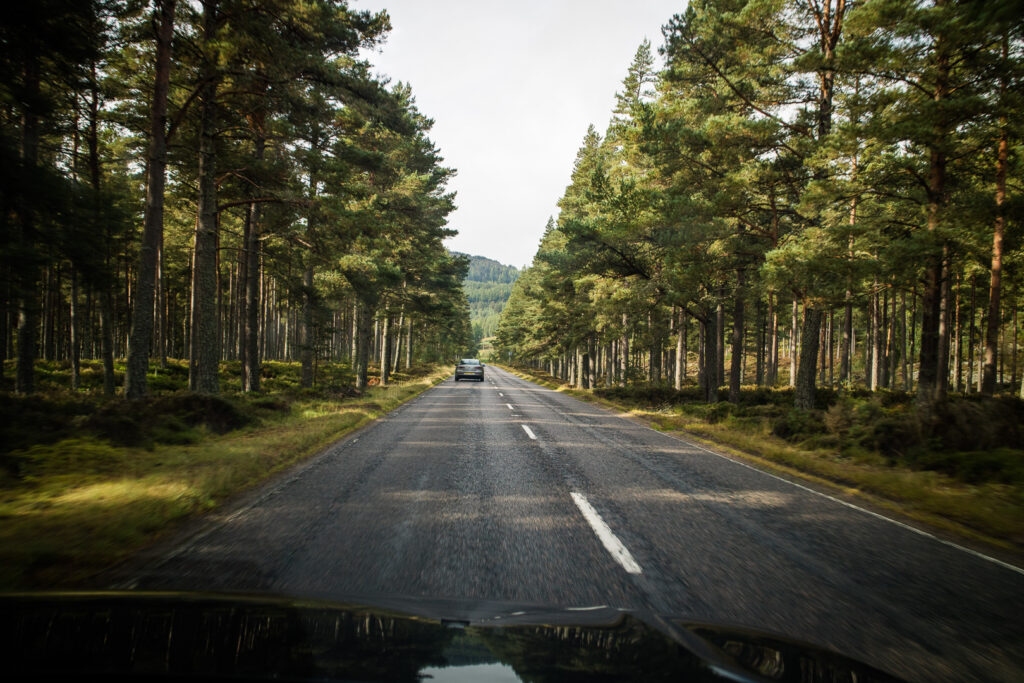
17. Alternatively, take public transport
Consider investing in a ScotRail ‘Spirit of Scotland’ Pass if you travel around Scotland by public transport. These passes usually cover trains, some buses and most ferries, and allow multiple travel days within a set period. It can, however, be cheaper to get individual tickets!
When you look up public transport, always check buses as well as trains. Buses reach more places than trains and they can be a lot cheaper.
Find out more about travelling Scotland by public transport and use my Best of Scotland itinerary by public transport .
18. Consider a guided tour
If you’d rather not drive yourself, there are many tour companies taking people around Scotland on day or multi-day trips.
My favourite recommendation is Rabbie’s . They’re driver-guides are excellent and they only use 16-seater buses, which guarantees small groups. Their scheduled tours leave from Edinburgh, Glasgow, Aberdeen and Inverness.
You could even join for just a day tour if you just need a day’s break from driving yourself.
19. Splurge on a private driver
Hiring a private driver for your road trip in Scotland is the ultimate luxury option. Not only can you lean back, enjoy the scenery and listen to the stories of your driver-guide, your itinerary will also be entirely tailored to your interests.
Expect to pay around £500 per day plus accommodation for the driver (on multi-day trips).
My Scotland Resource Library contains a few personal recommendations for private drivers.
20. Use my recommended providers & tools
Wonder where to book flights, hire cars, accommodation, train tickets, or activities?
Check out my Travel Resources page for my preferred car hire platforms, local transport companies, booking platforms, tour companies and activity providers.
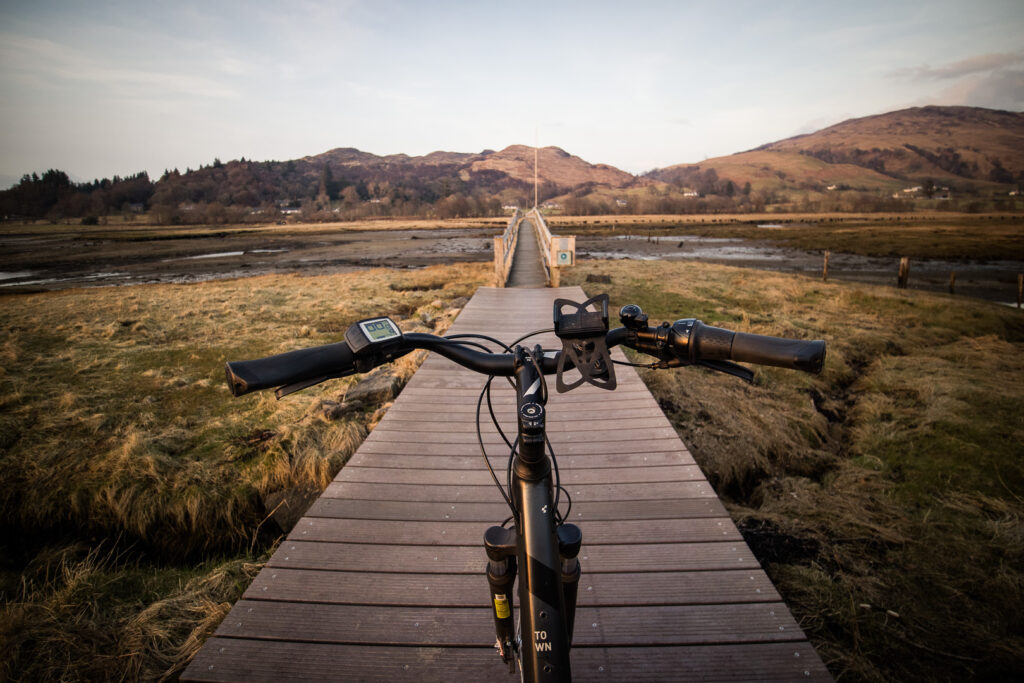
Tips for your Scotland Itinerary
21. which airport to fly into.
Most people arrive at Glasgow airport or Edinburgh airport, the two largest international airports in Scotland. There are also international airports in Inverness and Aberdeen.
I generally recommend flying into Edinburgh airport as it’s located most conveniently for trips that start and finish in Glasgow and/or Edinburgh.
Edinburgh airport is close to Edinburgh, but incredibly well connected to both cities – there is a direct airport bus from to Glasgow.
Glasgow airport is close to Glasgow, but a little further and harder to get to from Edinburgh.
Inverness and Aberdeen airports are well-located if your itinerary focuses on the north-west or the north-east respectively.
22. Listen to Wild for Scotland
Listen to my immersive travel podcast Wild for Scotland to see which regions resonate with you – then follow my travel tips to plan your itinerary.
You might also like: 12 binge-worthy podcasts from Scotland
23. Explore Scotland off the beaten path
Do more than the typical bucket list items, like Edinburgh, Loch Ness and the Isle of Skye. They are all beautiful, but Scotland has so much more to offer and it’s easy to go off the beaten track !
24. Choose “your” destinations and think outside the box
Don’t just follow the crowds.
Read up on different Scottish regions and make an informed decision. Choose destinations that tick the boxes that are important to you .
Some of my favourite regions to explore are Argyll, Aberdeenshire, Galloway and Angus.
25. Make a list of your “must have” experiences
Is there a specific place you want to visit? A dish you want to try? An activity you want to do? Don’t just think about destinations, but about experiences that will make your trip memorable.
In other words, make your own bucket list, than following someone else’s!
Maybe my list of first timer’s experiences could help?
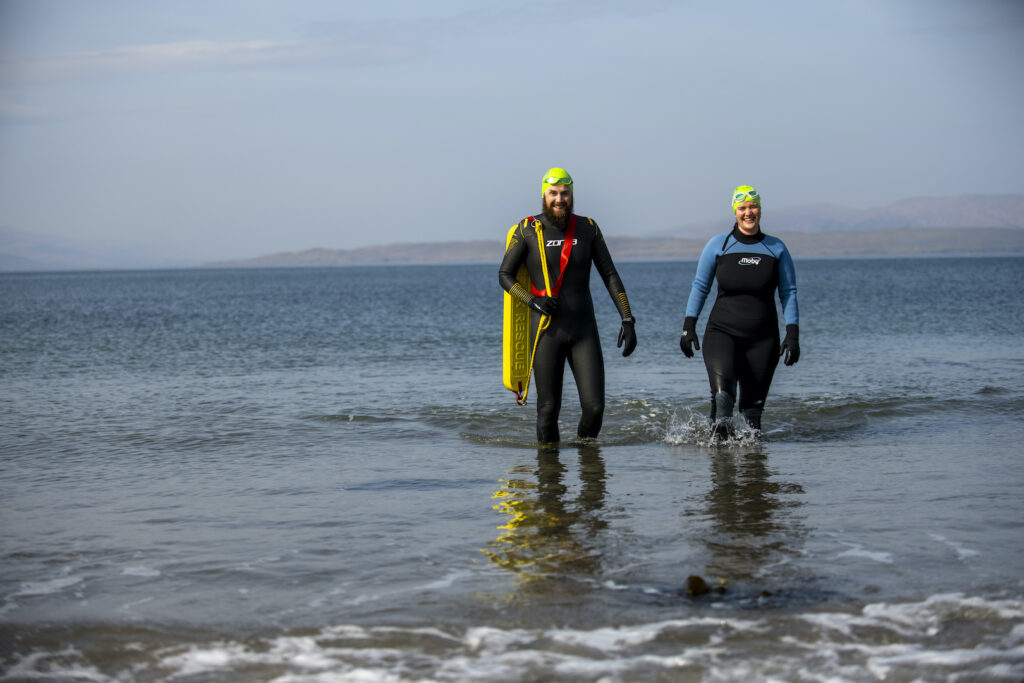
26. Go on an epic road trip
I love exploring Scotland by car and there are endless opportunities for scenic drives all over the country.
From the famous North Coast 500 which loops around the far north-west of Scotland’s Highlands, to the North East 250 in Aberdeenshire , the South West Coastal 300 in Dumfries & Galloway and the Heart 200 in Perthshire .
There is no shortage of epic road trip routes in Scotland .
27. Island hopping is easy
There are over 900 islands in Scotland, most of which are uninhabited. Since many of them are within easy reach from the mainland and/or from each other, it is easy to do some island hopping in Scotland.
One island region where island hopping is particularly easy to do, is the Outer Hebrides, also called the Western Isles. Cycling or walking the Hebridean Way , you can easily visit 10 islands in a week or two, and add a few more to the count by taking breaks for day trips to nearby islands.
Closer to Glasgow and Edinburgh, the southern Inner Hebrides are also a great island-hopping destination. Following my Inner Hebrides itinerary , you could easily hop from one isle to the next, including Islay, Jura, Colonsay and Gigha.
28. You don’t need to go far for an island adventure
The Isle of Skye is Scotland’s most popular island destination, but if you only have a couple of days in Scotland, I recommend choosing an island that is closer.
For example, the Isle of Arran makes for an amazing island getaway if you’re pressed for time. The island is easy to reach with a train & ferry combo ticket and suitable for a day trip or longer stay. The beaches and mountains are gorgeous (try climbing Goatfell ) and there are endless things to do on Arran, from Brodick and Lochranza Castle, a brewery and whisky distilleries, to standing stones and wildlife experiences.
Another island that is easy to reach is the Isle of Bute .
There are many other Scottish isles to explore that are much closer than Skye – no need to spend hours in the car only to be able to say you’ve been there.
29. Visit the Small Isles
The Small Isles are one of my favourite destinations off the beaten path. They are easy to get to from Mallaig which is a fixture on many people’s Scotland itinerary. Instead of taking the ferry to the Isle of Skye though, set sail for Rum , Eigg, Canna or Muck.
A visit to the Small Isles is also easy to connect with a road trip down the Road to the Isles or a ride on the Jacobite Steam Train .
The Small Isles are car-free and incredibly welcoming. All the islands are great for hiking and bird watching, but also if you are interested in historic sites or spending time immersed in a small Scottish community. Each island has something different to offer.

30. There are standing stones all over Scotland
There is no need to travel as far as Orkney or the Isle of Lewis to see standing stones in Scotland – unless you have time for a longer trip.
There is no shortage of standing stones and stone circles all over Scotland. Some of my favourites are the Machrie Moor standing stones on the Isle of Arran, the Nether Largie standing stones in Kilmartin Glen and the stones at Clava Cairns near Inverness .
31. Go wildlife watching
If you want to see Scottish wildlife, timing is everything. So, read up on where and when to find them.
Many marine mammals and seabirds are best observed during the summer months from mid-April to early August. This includes puffins and gannets, basking sharks and whales.
Seals and dolphins on the other hand, are more permanent residents on the Scottish coast.
If you’d like to go on boat trips or sailing, I recommend choosing a company that is part of the WiSe scheme to ensure you’re going with someone who’s wildlife-aware. On their website you can find all operators that are registered with them throughout the UK.
You might also like: The best places to see wildlife in Scotland
32. Where to see puffins?
Puffins and many other seabirds form massive nesting colonies up and down the Scottish coast, but they prefer places that are less frequented and take some effort to get to (usually a potentially choppy boat ride). Two of my favourite areas to see them, are the Treshnish Isles near Mull (Lunga) and Sanday off the Isle of Canna.

33. Where to see Highland Cows?
No trip to Scotland would be complete without seeing some Highland cows. They are not commonly used as farm animals anymore but are kept as treasured “pets” all over the country (for example by farmers or at hotels).
Great places to see them up close are Pollok Park in Glasgow, at the Loch Melfort Hotel in Argyll or at Newton Farm Holidays in Angus .
34. Visit Scottish Beaches
Ever thought about a beach holiday in Scotland?
Some Scottish beaches are so beautiful, the sand so white and the water so clear, that images have been accidentally used to promote tropical beach destinations!
Only the temperatures would give it away…
Some of my favourite beaches in Scotland can be found:
- in the Outer Hebrides on Vatersay, Berneray, and Bosta beach on Great Bernera.
- along the North Coast 500: Red Sands, Achmelvich Beach and Sango Sands.
- in Fife: St Andrews and Ruby Bay, Elie.
- in Aberdeenshire: Rattray Head, Newburgh and Balmedie.
- and the Inner Hebrides on Colonsay, Coll and Islay.
For more stunning beaches to visit, check out the book The Beaches of Scotland .
Need more help planning your itinerary? Hire me as a travel consultant and let me help you plan an itinerary that is 100% YOU!
On the Road
35. road navigation.
You could hire a GPS with your rental car, or use Google Maps on your phone. Reception in the Highlands and on islands can be patchy, but you can download Google Maps areas for offline use.
Of course, it never hurts to have a traditional paper map as backup.
36. Pay & Display Car Parks
All over Scotland, you will come across many Pay & Display Car Parks – some are run by the local council, others by private landowners. You have to pay for parking at the ticket machines and display the ticket on your dashboard.
Some – but not all – machines accept card payments. Some – but not all – machines allow you to pay via the RingGO app, but reception isn’t always great. It’s best to have some coins at hand.
Keep track of your travel memories with my Scotland Travel Journal !

37. Navigating public transport
Google Maps has a very useful public transport option to look up connections – it’s fairly reliable with inter-city connections and local buses in the cities.
For local buses in rural areas, I always check connections on Traveline as it’s more reliable than Google Maps.
For trains, I always double-check connections on the ScotRail app to make sure there are no cancellations or delays.

38. Public toilets
Toilets are not a glamorous topic, but knowing where to find them is necessary on any trip. Here is a website with a map of all public toilets in the UK .
My ready-made Scotland itineraries come with maps that point out public toilets along you route.
39. Finding WiFi on the road
Most cafes and restaurants generally have free WiFi for customers. You may want to get a local pay-as-you-go sim card – just make sure your phone is unlocked for all networks. You can pick these up at most large supermarkets.
40. Dealing with midges
Midges are tiny black flies that show up during the summer months all over Scotland. They are annoying and most people get itchy from their bites – but they won’t ruin your trip.
Midges hatch from the end of May until late September – that’s when they are around. They like overcast skies, mornings and evenings, windstill weather and standing water – expect them to be around in these circumstances. They dislike wind and sunshine, which is why they’re often not too bad on the coast.
Unless you’re camping, you can get away from them really easily by going inside. If you are camping, bring a midge net and set on spending evenings inside your tent.
There are several repellents that work for midges – first and foremost, Smidge and Avon Skin So Soft which you can pick up anywhere in Scotland.
You might also like: More tips for dealing with Scottish midges
41. Storing luggage
If you are travelling on public transport, you may want to store your luggage at some point during your trip.
Most hotels, B&Bs or hostels will allow you to drop off your bags before check-in or leaving them there for a few hours after your checked out.
There are luggage storage facilities at some train stations, but really only in large cities and towns, such as Glasgow, Edinburgh, Fort William and Inverness. You can search for station facilities at all train stations here (look for ‘Left Luggage’ facilities).
Visiting Scottish Castles + Attractions
42. visit a variety of castles.
I recommend visiting castle ruins as well as fully preserved or restored castles to experience a variety of Scottish castle architecture.
My favourite castles in Scotland include:
- Stirling Castle : very well preserved & a great self-guided tour,
- Dunnottar Castle : my favourite ruined castle in a breathtaking location,
- Balmoral Castle : only the grounds + gardens are accessible since it’s an official Royal residence, but it’s incredible,
- Kilchurn Castle : a stunning castle ruin on the way to Oban,
- and Culzean Castle: overlooking the sea and the Isle of Arran.
You might also like: 11 Educational & Science-Based Tourism Experiences in Scotland

43. Follow the Scottish Castle Trail in Aberdeenshire
If you want to see many castles in a short amount of time, follow the Scottish Castle Trail through Aberdeenshire – it covers 19 (!) castles that are all just a short drive from each other!
44. Invest in an attractions pass
Visiting many castles and attractions, most of which charge an entrance fee, can quickly add up.
It might be worth investing in an annual membership for the National Trust for Scotland (join here ), an annual Historic Environment Scotland membership, a short term Historic Scotland Explorer Pass or the VisitBritain Heritage Pass.
Note though, that privately owned castles are not included in these castles. This includes Dunvegan Castle on Skye, Inveraray Castle in Argyll, Dunnottar Castle in Aberdeenshire and many others.
Write down which castles and attractions you’d like to visit, look up entrance fees and research which passes would cover them. Then do the maths.
Edinburgh Travel Tips
45. spend at least 2 days in edinburgh.
2 days in Edinburgh gives you a good amount of time to see the highlights and explore off the beaten path.
The city is very walkable, there is an easy-to-navigate bus system or you can use Uber.
My personal highlights are:
- Scott Monument for the best views,
- the Royal Mile and its many closes, wynds and hidden gardens,
- Grassmarket for pubs + castle photos,
- Calton Hill and/or Arthur Seat for a hike – maybe at sunset?,
- National Museum of Scotland for stunning views from the rooftop,
- the Water of Leith Walkway to escape the crowds,
- the Shore + surrounding neighbourhood in Leith for pubs and food,
- the Scottish Design Exchange on George Street for shopping.
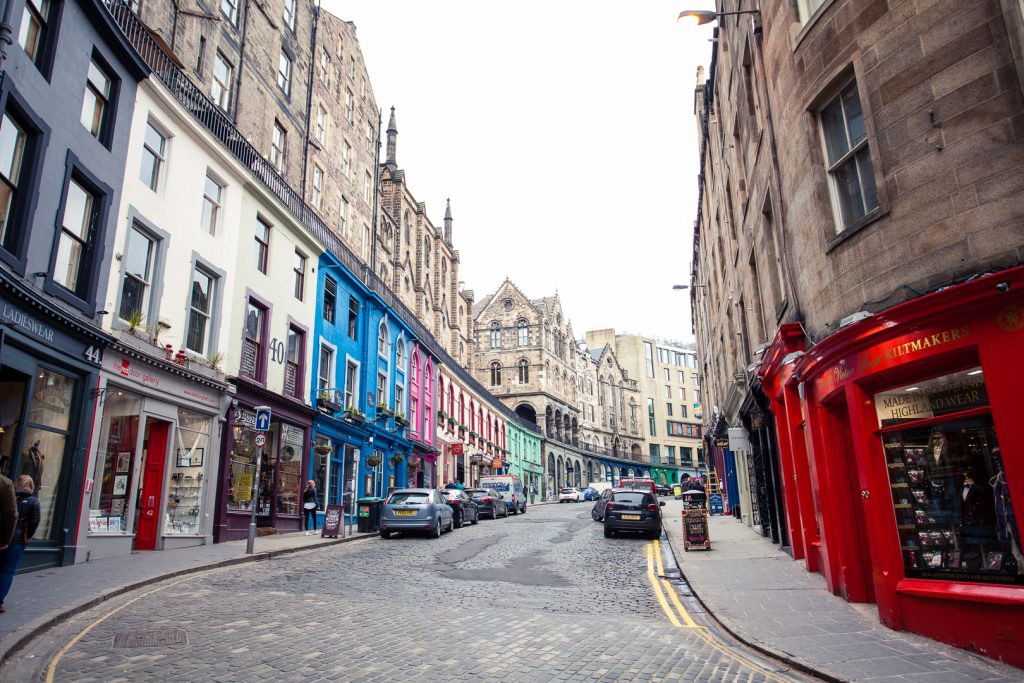
46. Start with a city tour
The Edinburgh Hop on Hop off bus tour can give you a great introduction to the city. I recommend doing this as soon as you arrive!
Read up on my favourite tours in Edinburgh here!
47. Explore beyond the Old Town
Particularly in the summer, Edinburgh is bustling with visitors – but it is easy to escape the crowds by leaving the medieval Old Town.
Explore beyond the major tourist attractions and go off the beaten path:
- Visit the Royal Botanical Gardens ,
- Wander around the Stockbridge neighbourhood,
- And explore Leith.
48. Book accommodation well ahead
Accommodation in Edinburgh can be expensive and hard to come by, so book well ahead of time. I recommend staying in the Old Town, West End (Haymarket area), New Town or Leith.
On a budget? Check hostels, avoid August and December (festival season) and stick to weekdays. Alternatively, you could stay in Glasgow or Dunfermline and take the train to Edinburgh for a day trip.
You might also like: My accommodation guide for Edinburgh
Glasgow Travel Tips
49. don’t make the mistake to leave glasgow off your itinerary.
Glasgow is an amazing city with a thriving cultural scene, beautiful architecture and parks, a great food scene and plenty of things to do. I recommend spending at least one day in Glasgow .
My personal highlights are:
- Visiting Glasgow Cathedral and the view from the Necropolis,
- Seeing the Highland coos at Pollok Park,
- Wandering around the Glasgow University campus,
- Eating haggis and drinking beer at Ashton Lane,
- Visiting the many free, public museums like People’s Palace,
- Following the City Centre Mural Trail,
- Shopping at the Hidden Lane.
You might also like: 50 useful Travel Tips for Glasgow

50. Mingle with Glaswegians
Visiting Glasgow is all about mingling with the locals – the city’s slogan is “People Make Glasgow” after all!
It’s easy to meet locals at the pub – just stand by the bar and someone will start chatting to you.
51. Discover free things to do in Glasgow
Glasgow is a budget-friendly city and there are many free things to do .
Most museums are free of charge, the City Chambers offer free tours during the week, there are beautiful parks and nearby hiking areas and lots of beautiful architecture to discover.
52. Book a walking tour with me
Glasgow is a city best seen through the eyes of a local. Whenever I can, I offer private walking tours through Glasgow to show you my favourite places, take you off the beaten track and answer all your questions about life in Glasgow.
Read more about my Glasgow tours and email me to check availability.
Packing Tips for Scotland
53. wear layers.
Since Scottish weather is unpredictable it is important to wear layers. That way you will be prepared for any kind of weather and can add or remove one or multiple layers as needed.
My Scotland Resource Library contains a full packing list & heaps of packing tips for Scotland.
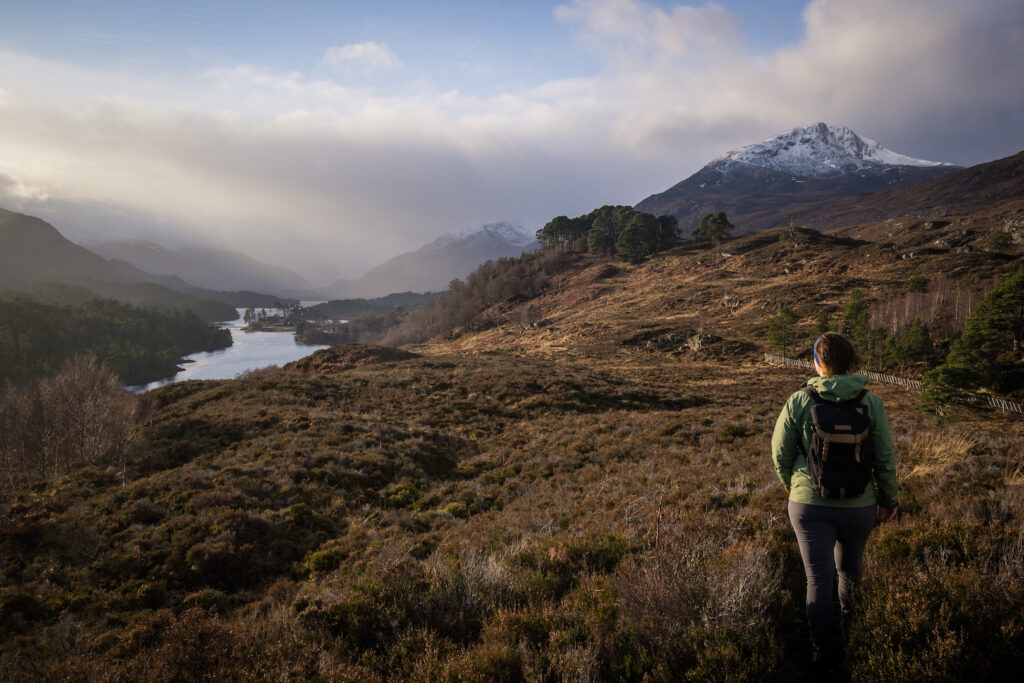
54. Invest in GOOD waterproofs – a jacket and trousers
Forget umbrellas – it’s too windy. Invest in a high-quality waterproof jacket and some waterproof trousers (pants) – the latter especially if you plan togo for walks. It’s worth the money to stay dry and comfortable!
And don’t forget: don’t let a bit of rain drag you down. It’s all part of the Scottish experience.
Check out some of my recommended shoes & clothes for Scotland here .
55. Wear comfortable walking shoes
Comfortable walking shoes are an absolute must on your Scotland packing list. They should keep your feet warm and dry.
I recommend wearing shoes that you don’t mind getting wet and dirty. Even if you don’t plan to go hiking, foot paths to viewpoints or around attractions can be muddy.
Waterproof/-resistant shoes are ideal. I love my Barbour half-wellies .
For proper hikes, I always wear my Zamberlan boots , but I may even put them on for shorter walks. They are just so comfortable and keep my feet dry.
Apart from these, I usually wear comfortable trainers to drive or walk around or Chelsea boots.
56. Pack hiking equipment
If you plan to go hiking in the Scottish Highlands, on islands or on the coast, bring proper hiking equipment to protect yourself from the elements.
This includes waterproofs (jacket + trousers), sturdy hiking boots, a map and compass, and emergency supplies. Hiking in inadequate clothes or shoes, or getting caught in bad weather without required emergency supplies can cause unnecessary search + rescue missions for the local mountain rescue teams. Make smart choices.
Never underestimate the weather in the hills and only go as far as you can safely navigate back.
If wild camping, pack what you need to leave no trace. Check out my guide to wild camping in Scotland for tips.
57. Where to buy essentials
Forgot something? Here are some useful shops you can find in most cities: Boots (drug store/chemist and pharmacy), Marks & Spencer (clothes), Tiso and Cotswold (outdoor gear).
You can literally buy anything in cities like Glasgow and Edinburgh, Stirling, Perth, Dundee, Aberdeen and Inverness. In the Highlands, Fort William has the biggest range of shops.
Experiencing Scottish Culture, Food & Drink
58. give whisky a chance.
Be open-minded when it comes to Scottish whisky.
It took me three years and multiple visits to whisky distilleries to realise that I kind of like single malt whisky. Try a few different ones to find a dram you like.
To learn more about the different whisky regions and find your preferred taste visit the Scotch Whisky Experience in Edinburgh .
If you’re a whisky lover, check out my whisky itinerary for Scotland.
You might also like: An essential guide to trying Scottish whisky
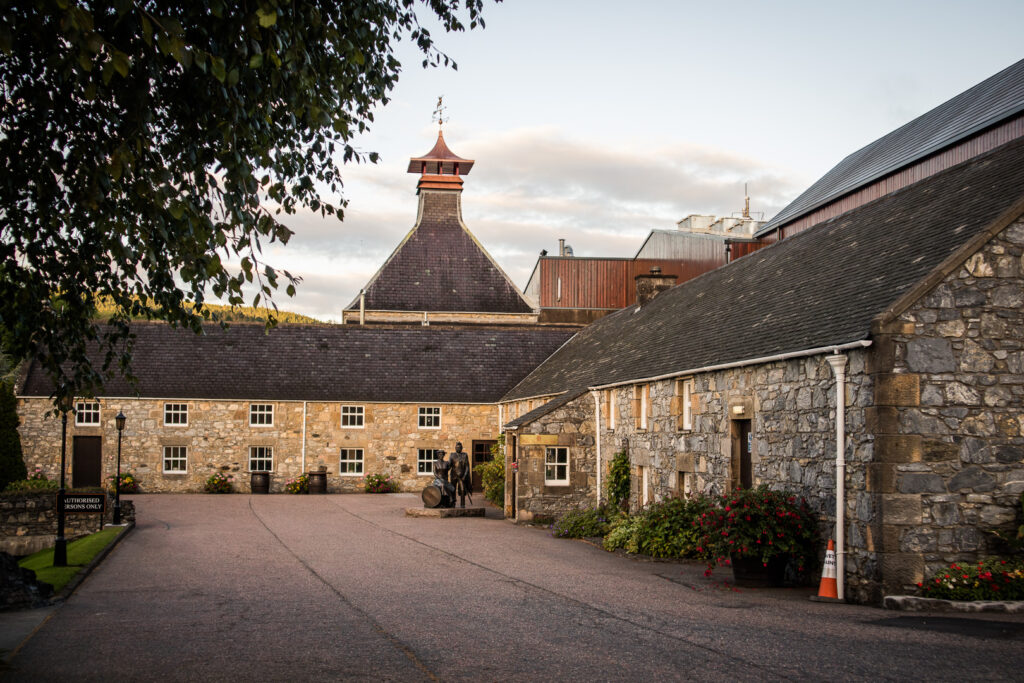
59. Just don’t call it Scotch
Scottish whisky is never spelled with an ‘e’ (whiskey) and we never call it Scotch. It’s whisky, malt, single malt, or a dram.
Bonus tip: Don’t order a single malt whisky with ice or pour water in right away. Try the whisky neat at first, then maybe add a few drops of water to release the full aroma. Only if you still insist, ask for some ice.
60. Experiment with Scottish cuisine
Scottish food is excellent, whether you go for traditional dishes like haggis or Cullen skink, or try contemporary cuisine.
If you eat meat and seafood, order typical Scottish dishes like Cullen skink (a creamy fish soup), steak and ale pie, stovies (a potato dish), fresh seafood, and of course the famous chicken tikka masala.
For the best fish & chips head to a seaside town of your choice where the fish is the freshest. I highly recommend the Anstruther Fish Bar near St Andrews !
61. Ask what’s in haggis after you tried it
Or simply, don’t ask at all – just enjoy it. Haggis is better if you don’t think about what’s in it.
If you don’t eat meat, try vegetarian haggis instead – it’s delicious!
Black pudding is not a pudding. As with haggis, don’t overthink it or try the veggie version.

62. Don’t worry if you’re vegan – you’ll find plenty to eat!
If you are vegan, find out how easy it is to travel Scotland as a vegan here !
63. Tap water is safe to drink in Scotland
There is no need to buy bottled water in single-use plastic bottles. Scottish tap water is safe to drink and tastes delicious. Bring a reusable water bottle & fill it up frequently!
64. Be aware of Seagulls
When buying fish & chips to take away, especially by the seaside, watch out for seagulls. Scottish seagulls are big and fierce – they are known to steal food out of people’s hands .
65. Taste Scottish (craft) beers
Scottish appreciation for alcoholic beverages does not stop at whisky. The Scots also love their beer!
Tennent’s is by far the most famous lager, so make sure you try a pint of that. It has been brewed in Glasgow for over 400 years. The brewery also offers a great tour + tastings.
There is a growing craft beer scene in Scotland and there are many small breweries. Some of my personal favourites are Loch Fyne Ales from Argyll, six°north from Stonehaven , and Hangman’s Rock from Colonsay Brewery.
66. Try Irn Bru in all its forms
Irn Bru is an iconic Scottish carbonated soft drink. It is bright orange and a staple in many Scots’ regular diets. Produced by Barr’s in Cumbernauld near Glasgow, only 3 people know its secret recipe.
You can drink it, or try Irn Bru-flavoured sweets or ice cream. I prefer the latter!
67. Find local live music
Scotland has a diverse music scene. Many bands and singers from Scotland are famous around the world – Belle & Sebastian, The Proclaimers, Biffy Clyro and Franz Ferdinand, just to name a few.
Traditional music is also big in Scotland and there are many bands who play old-fashioned or contemporary versions of trad music, such as Skerryvore, Talisk or Breabach.
Many pubs around the country host regular trad music nights, such as the Ben Nevis Bar in Glasgow, the Edinbane Inn on Skye, the Clachaig Inn in Glencoe or Macgregor’s Bar in Inverness.
68. Dance at a ceilidh
Another important part of Scottish music culture is the Ceilidh, a traditional social gathering that involves lots of dancing and traditional music. Many Scottish weddings end with a Ceilidh and many rural communities host regular Ceilidh dances.
An easy way to participate in a Scottish Ceilidh is by visiting Sloans in Glasgow (Ceilidh every Friday night, tickets are £12.50) or join the Edinburgh Ceilidh Club .

69. Attend a Scottish festival
Edinburgh is famous as a festival city, particularly during the summer festivals in August, such as the Fringe theatre, comedy & performance festival and the Military Tattoo.
Many islands host music, food and whisky festivals, and each city is home to a variety of cultural festivals throughout the year.
Whether it’s Hogmanay in Edinburgh or other Scottish winter festivals , a music festival, an arts festival like NEOS in Aberdeenshire , a cultural festival like Up Helly Aa , a food event or a whisky festival – the Scots love to celebrate. Join them!
70. No matter how wild the party gets, don’t lift up a man’s kilt!
Do I have to say more?
I hope my travel tips for Scotland will prove useful to you on your upcoming trip or inspire you to get started planning a trip to Scotland!
What is your top tip for a journey to Scotland?
Pin this post for later:
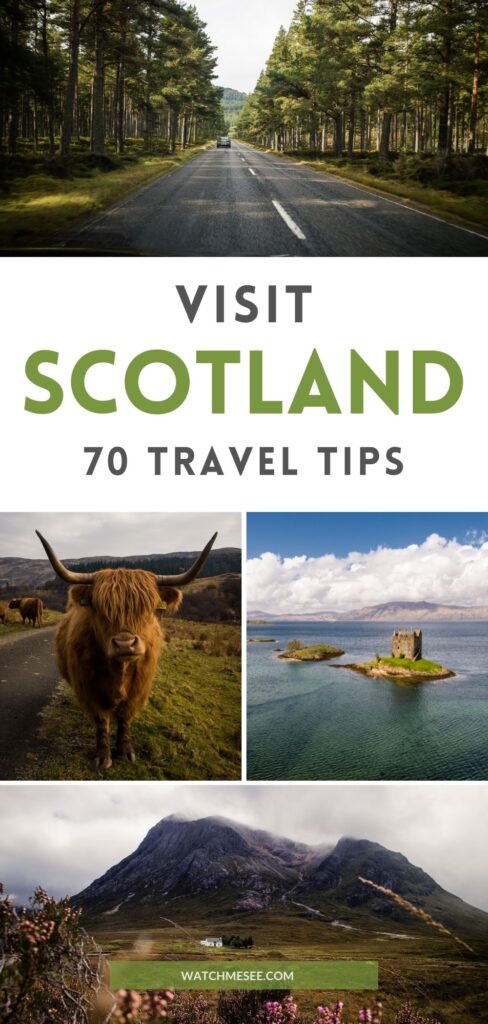
Planning a trip to Scotland?
Download my FREE Trip Planning Checklist
Join my Facebook group to find inspiration for big & small adventures
Listen to my podcast Wild for Scotland for lots of travel inspiration
Use my Scotland Travel Journal to document your trip
Make trip planning easier with my Scotland Resource Library
Save time and get one of my pick-up-and-go Scotland itineraries
Beat the overwhelm and hire me to plan a bespoke itinerary for you
67 thoughts on “ 70 Useful Travel Tips for Scotland ”
those are very valuable tipps, though picking up gaelic might prove a tall challenge 🙂
Pingback: Insider Tips For Planning a Scotland Trip With Kathi Kamleitner
Excellent advice for Scotland. I’ll save them for when I go there. The castles and the Jacobite Steam Train are two things I would especially love to visit.
very informative article. Scotland travel in my bucket list. Hope to travel there soon.
Thanks for sharing these great tips for traveling.
Superb blog thanks for sharing amazing post.
I love this list! We are heading there with our family last year on 17th March 2019 after ITB berling. Flying to Scotland for a week. Amazing destination to be in everone backlist.
I was in Scotland and did Edinburgh and Glasgow on the top of the list. It was a really good trip. I will go back again in the near future.
We will have a carhire when we visit in May. How should one go about selecting where to pick up your car once you are ready to travel outside of Edinburgh? Airport, train station, city outskirts?
I’d probably get it from the airport – it’s easy to get to from the city after sightseeing for a few days, easy to navigate because signage is good, and usually also a bit cheaper than city offices!
Thank you SO much for the wonderful info, ESPECIALLY including vegan and vegetarian info and options! Your site is fantastic!! I hope to be traveling to Scotland with my hubby in 2020 for our first time and your blog has been extremely helpful!
Thanks for taking the time to comment, Tomina! I hope you have fun planning your trip to Scotland – and a great time here, when it comes!!
Here is my plan in May. 2020 Inverness – Fortrose Cromarty Dingwall Fodderty carbisdale castle Dunrobin castle Backies Dunbeath castle Wick castle sinclair Girnigoe Keiss – old keiss castle bucholie castle john o groats duncansby head and stacks Castle of Mey dunnet head lighthouse Crosskirk Puffin Cove,Drumhollistan Tongue – castle bharrich Durness scorie drumbeg Clashnessie and falls Lochniver Ardvreck castle and peach and horne memorial ullapool poolewe torridon – am ploc open air church Applecross Plockton- duncraig castle Caisteal Maol Fort augustus -falls of foyers Dores Inverness
Then Nairn Brodie castle Culloden battlefield Lossiemouth Spynie palace Dufftown – Glenfiiddich Distillery Bow fiddle rock Banff – temple of venus Pennan Rattray lighthouse peterhead prison museum bullers of buchan Cruden bay Slains castle Aberdeen banchory – abergeldie castle Braemar castle Balmoral castle Glen lui blairgowrie bon scott statue linn of tummel Airlie monument newtonmore blair castle garry bridge Carrbridge and back to Inverness
Some great sites on your list! How much time do you have?
amazing blog loved going through it thank you so much for sharing
I really love for traveling mostly i have travel to Europe for business purpose next time i will try to travel Scotland and visit this unique places. overall thanks for share this informative blog.
I’m so excited to be returning to Scotland for a 4th time! With my 82 year old mom who just hurt her knee pretty bad, so hoping to do some things that don’t involve a lot of walking or hiking. We’ll have a car and wanted to go to Inverness and beyond. Oban sounds interesting! Any islands that wouldn’t involve a ton of walking? We love castles! Thanks for a great post!
Hi Lynne, Thanks for your comment and question! Have you seen my Scottish islands post – I summarise all the islands in it: https://watchmesee.com/blog/the-best-scottish-islands-to-visit/ Oban is wonderful and a great starting point for many islands. I’d recommend Mull because it’s near and there is lots to do that isn’t necessarily hiking or walking too far, incl a castle and a whisky distillery! You could also explore the region around Oban (Argyll) and head down towards Tarbet – there are tons of castles in that region and such a meandering coastline, it feels almost lie you’re on an island! I also have lots of posts about Argyll – you can find them by browsing the menu. I hope this helps! Have a fab trip! Cheers, Kathi
Ahh! Thank you so much! Will do all of the above! Can’t wait!
Can I ask one more question – do you recommend the Historic Scotland or Heritage Pass? I can’t figure out if it will pay for itself or not for us. I didn’t see you comment on that one. And also if we should purchase that before we come to Scotland or purchase it there. Thanks!
Hi Lynne, there are three passes you could consider – 1) National Trust of Scotland membership (1-year validity), 2) Historic Scotland membership (1 year) and 3) Heritage Pass (7 days). Each includes different attractions and has a different price point. Whether it’s worth it or not, really depends on what you want to see – some castles cost £13-18 entrance fee, so if you want to see three expensive castles a pass might be worth it. Check which attractions you want to see along your route, look up entrance fees at their individual websites and then check which pass would cover them. It’s a bit more work to prep for your trip, but then you know you don’t have unnecessary expenditure! And since you do the research in advance, why not also buy it in advance 😉
I write about the three passes in this post too: https://watchmesee.com/blog/backpacking-scotland-on-a-budget/
Thanks for the great insights into Glasgow – myself and my partner are heading there for a conference in late August via a few nights in Edinburgh to catch the tail end of the Fringe Festival. Your blogs on Glasgow have made us much more optimistic for what Glasgow can offer tourists – my partner was fixated on Glasgow’s knife crime and very few Kiwis who had traveled there had anything positive to say about Glasgow – we can now see from your blogs it offers so much more and are looking forward to our time there! We are seriously thinking of using your 7 day classic intinery from Glasgow to Skye to Inverness back to Endinburgh (potentially taking in a bit of Adberdeenshire & the Cairngorms if time allowed) – do you think this is too much traveling for 7 days? We are also thinking of heading out of Glasgow after 5pm on a Thursday night – is there anywhere an hour or so from Glasgow that is nice to stay on the way north? Looking forward to seeing your wee adopted country. Thanks again for a great informative blog from the Edinburgh of the south – Dunedin, New Zealand!
Hi Rebecca, I’m so glad you found my blog – honestly! It’s such a shame that Glasgow is still ringing with these negative stereotypes. Don’t worry about knife crime at all – any crime actually – and enjoy your time here. There is so much to do and see, lots of new tour companies, museums, parks, viewpoints, great food and lots of cultural venues! It’s a beautiful city that has changed a lot in the last few decades!
Regarding your road trip, you could stop in Arrochar near Loch Lomond – a gorgeous place and just about one hour away from Glasgow. Check out Ashfield House B&B – Cristina is a fantastic host! If you only have a week and want to follow my 7-day itinerary, you wouldn’t be able to also add the Cairngorms and Aberdeenshire. My 7-day itinerary is already pretty busy and I actually recommend to spend 9-10 days on that route to see everything on the list and relax a little too! If you have longer, it’s a different story.
I hope you have a fantastic trip to Scotland. I’d love to hear how you got on!
All the best, Kathi
Fantastic info off to Dumfries and Galloway next week been before but a few years ago Always loved Scotland Just learned what wee meant hear it a lot
Well done. At last a sensible and non-patronising list of dos and don’t for visiting Scotland. The England thing is the most crucial! My only slight cavils are: Balmoral isn’t really a castle but a mid-victorian fantasy house. There are plenty of authentic ancient castles in Scotland but Balmoral isn’t one of the. Then, why does nobody on these blogs mention the New Town in Edinburgh as a wonderful place to explore. It’s not new, but street after street, square after the square of Georgian architecture of the very highest quality, and the main reason that Edinburgh is a World Heritage site. It dates from the 1760s and was the home of famous Scots like Robert Louis Stevenson.
Hi Janet, I’m glad you found the list useful! I’m actually going to New Town next week to try and review an accommodation there and can’t wait to explore that part of Edinburgh more in-depth. This list only has four tips regarding Edinburgh, but if you look at my 2-day Edinburgh guide you will find New Town among my essentials: https://watchmesee.com/blog/edinburgh-in-two-days-weekend-trip/ , so I’m not sure what you mean by “these blogs”. I loved Balmoral – the gardens were among the most beautiful I’ve seen and it’s so close to other castles in the region. You can see a great variety of castles and big houses in this area!
Wow.. this list of informations is so amazing! Can you advice me april is good time to visiting Scotland. Waiting for your reply….
Absolutely! April is when all the Spring flowers usually start blooming. I guess just stay aware of he Easter holidays when you book accommodation. Enjoy!!
Scotland is really nice country. I am reading your blog and i get the awesome tips about traveling to Scotland. Thanks!
Nice blog. Saved lots pins to my Scotland board. I am guessing you live in Scotland? We don’t have pound notes any more!
Sorry, if it’s unclear, but I’m speaking about 5-, 10- and 20-pound notes, not the old £1 notes… Yes, I live here!
Hi there, We’re leaving for Scotland in 3 days. Attending the wedding of a highschool friend in Inverness. Will be in Edinburgh 3 days, Inverness & Culloden 4 days, then have a week of driving to Oban, out to Tobermory, Maillig & About. Will attend the Edinburgh Military Tattoo, stay one night in Barcaldine castle, an Airbnb & some small guest houses. Thank you so much for your suggestions – even about the haggis :>. We’re looking forward to the adventure, weather, sheep, music, culture, views & Scotch!
That sounds like such a lovely and relaxed trip – you will see so much and get a real sense for the country 🙂 Enjoy your holiday and thanks for checking out my blog!
Beautiful post! Thanks so much for the inspiration.
THANK YOU!!!! We are going to Scotland for our honeymoon next May and I’ve been reading blogs through Pintrest for several months now. Yours is all I need!! It answered every question I had and more! I am so exited about the vegan fish & chips in glasgow!! I honestly can not thank you enough! ☺☺☺
Myrna, thank you so much for your comment! I’m so happy to hear from readers who find my blog useful. Let me know if you need any assistance on planning your perfect Scotland holidy!!
I’m really enjoying your web content. Thanks for sharing these tips. It will help other users as well :). Big Love and Big Support!
I appreciate your sharing and I must say that you have shared such nice and useful information about Scotland with all of us which is really good. I also visited there for having enjoyment. It is a best place for having fun and tourists can enjoy there hiking and many other outdoor activities. I hope you will have a joyful time there.
great tips you shared, i love your blog only for this reason that you share true fact. Next month we all going to scotland and lots of activity we will do. Thanks to you and your article, who suggested me good option.
Oh, my. Thanks for the giggles. I have been to Scotland four times from The States, and am planning my fifth go for late summer – early fall. Your fun insider’s take on the endless joys to find there are inspiring. And I haven’t gotten to your take on The Shetlands. I hope you have some info on The Orkneys in here too. Have joined your newsletter. Well done and thanks again!
Unfortunately, I’ve not been to the Orkney’s myself yet, but I can recommend this post by Migrating Miss, https://www.migratingmiss.com/things-to-know-before-you-visit-orkney-scotland/ , for some more info on the Orkneys! Thanks for joining the newsletter too!! 🙂
I like that you provided some tips when traveling to Scotland such as looking for public transportation when getting around. It is recommended that you tour the city via public transportation as this can definitely save you lots of money. Plus, you are able to communicate with locals who can give you tips and recommendations on the best local restaurants and bars. If I were to visit Scotland in the near future, I would make sure to keep this in mind. Thanks.
Pingback: How to Plan a Trip to Scotland: Driving in Scotland
Pingback: How to Plan a Trip to Scotland | WatchMeSee.com
Pingback: 50 Useful Travel Tips for Glasgow | Watch Me See
Oh my god, this list is amazing! I am actually planning on visiting Scotland in November, so now I really can’t wait for this weird country. (Weird in a good way) …Thank you .)
Have a fantastic trip – November can be a bit rainy, but also so eery and mysterious in the mountains. And the colours are amazing – I love it!
My husband and I will be visiting August 31st to September 14th. We plan to take the train to get around (Edinburgh, ft William, skye, Inverness, pitlochry & Glasgow) Are there any tips or websites you recommend. I’m a little nervous about it honestly. Thanks
That’s absolutely doable, although you’ll have to take a bus to Skye. For trains I always use trainline.co.uk – I find the best deals around three weeks prior to my intended travel dates, and the site is a lot more user-friendly than the Scotrail websites; plus it lists various train companies in its search results! For buses check our citylink.co.uk, which is as far as I know the main bus company operating in rural Scotland. Prices are usually reasonable if you book in advance or do short routes! Traveling by public transport can be a bit more time consuming, but particularly the train routes are so scenic, you’ll actually want them to last longer 😉 Have a great trip!
Gonna hold my hands up and say I came to read this list (as a Scot in Scotland) to see what ridiculous advice was being doled out. I’ve never been happier to admit I am completely wrong and this was a very useful, interesting and well-written list – a must-read for anyone coming to visit Scotland. I would add that for number 28, Fife (an area north of Edinburgh, over the iconic Forth Bridge) is also worth a mention in terms of cheaper accommodation if you want to see Edinburgh, even in August. There are very regular trains (more and later running during the festival) and it’s as little as 35 minutes away.
Good shout about Fife – I’ll add this tip to the article if I may. I’m glad I could surprise you with my list! I’ve lived here for several years and was hoping that by now I’d have a pretty good idea of what travelers should know about 🙂 I hope you’ll share it with friends coming to visit you! X
Love this list! We are heading there in March and will only be there for a week. I wish I could stay a month or longer and do so much more. Still working out our itinerary, though, so this has given me many ideas. (Sorry to hear the highland cows aren’t as easy to spot as the travel websites make them seem. But it’s good to know. 🙂 )
Oh a week really isn’t enough, but it’s a good time to get a first overview! In terms of highland cows – maybe I was just always not lucky enough… I wish you a great journey and all the best spotting coos 😀 Thanks for your comment!
Believe me, Adele is from Tottenham, London. Definitely not Scottish
Haha I was totally thinking of Amy Macdonald there – neither of them make it into my playlists, so it’s easy to mix up 😀
Love this so much! And agree with all of them!! The thing about not lifting a man’s kilt made me laugh, it’s my man’s biggest fear when we’re out and he’s wearing his kilt. At graduation in St Andrews, people randomly asked him to take photos because he was wearing one. Also, I invested in a Craghoppers last year and it was by far my favourite purchase ever! It’s doing really well in currently -15 Canadian weather too! And agreed about the classic trifecta, Edinburgh, Loch Ness and Isle of Skye. I always try to get people to think further than that!
Thanks for your comment – I’m glad I picked some you could personally relate to. I wish my partner was wearing a kilt more often – he’s Scottish, but he doesn’t have one – I’m often disappointed ha ha 🙂
Thanks for the advice! I will be heading to northeast Scotland in March (Inverness and the Black Isle), I will definitely be using some of your advice. This is my first time to Scotland and really appreciate your time to dish out some advice.
Oh what a fantastic trip waiting for you! I’ve never been to the Black Isle, but they have a great brewery up there, if you’re into that sort of stuff! Have a fab trip! 🙂
I was interested in your take on Scotland, as I once lived there, and still have relatives there, it is a beautiful country, except for the dreaded Scottish mid he, especially in the west, it absolutely eats you to bits, especially the English, so be warned from May to October beware the midge
You’re right – the midges are the worst! They can really ruin your trip to some extent – but the landscape makes up for it 🙂 Thanks for your comment!
Hi Edith — just beginning exploring the possibility of traveling to Scotland alone – and I am kinda old but good shape! I do not know what a midge is — is that a mosquito? A gnat? And you mention the Scottish mid he — what is that? Is bug spray enough to ward them off? Thanks for any input!
Hi Mary, I think Edith’s had a typo there – she’s of course also talking about midges (not mid he) 😉 I would describe midges as a mix between mosquitos and flies – they’s quite small (hence there are specific midge nets to keep them away – they can slip through normal mosquito nets), they bite and can itch like crazy! Mosquito repellent might work, but there is also a spray called Smidge, which you can pick up in most outdoor shops here, which was specifically designed with the Scottish Highland midge in mind. It helps really well, but it is also advisable to wear long sleeves around sunset to keep them off your skin! Hope that gives you an idea of how to protect yourself from the ‘wee beasties’ – as we call them here!
Great tips for Scotland. I will bookmark them for when I visit. I would especially love to see the castles and the Jacobite Steam Train .
Thanks for your comment! The steam train really is a great experience – hope I get to take it maybe this year 🙂
I was just in Scotland and did the Loch Ness, Isle of Skye, and Edinburgh. It was all we could fit in for that trip, but I really wanna go back and see more. I will put Glasgow on the top of the list. I did try haggis while I was there and loved it!
Thanks for your comment! Those three places are a great introduction and all classics! Next time do Glasgow for sure, and maybe Oban <3
Leave a Reply Cancel reply
Your email address will not be published. Required fields are marked *
Awesome, you're subscribed!
Thanks for subscribing! Look out for your first newsletter in your inbox soon!
The best things in life are free.
Sign up for our email to enjoy your city without spending a thing (as well as some options when you’re feeling flush).
Déjà vu! We already have this email. Try another?
By entering your email address you agree to our Terms of Use and Privacy Policy and consent to receive emails from Time Out about news, events, offers and partner promotions.
- Things to Do
- Food & Drink
- Arts & Culture
- Coca-Cola Foodmarks
- Los Angeles
Get us in your inbox
🙌 Awesome, you're subscribed!

VisitScotland is closing all of its tourist information centres
The tourist board is instead transitioning to a ‘digital first’ approach

First, the digital age killed the high-street. Then it came for our pubs, clubs, and cinemas. Now, it’s robbing us of tourist visitor centres in Scotland.
VisitScotland has announced that it plans to phase out all its remaining physical tourist information centres, known as iCentres. This follows the organisation already downsizing its number of iCentres from 65 to 25 between 2017 and 2019.
The tourism board says no changes will be made until September, but from then gradual plans will be put in motion with the goal of having all the iCentres shut by 2026.
Visit Scotland said the move reflects a change in the ways people get their information, after a 42 percent decline in visitorship to the iCentres since the pre-Covid era. The board says that more and more people are doing the bulk of their research before they travel, and therefore minimising the usefulness of having in-person information points.
Lord Thurso, the chair of VisitScotland, said: ‘Prioritising a digital-first model of information provision allows us to reach potential visitors at those early planning stages when we can shape their future travel decisions.’
‘In order to continue building demand and growing the value of tourism and events, it is vitally important that we target channels we know visitors use to influence them to visit Scotland.’
But not everyone supports the move. It has been criticised by some, including MP John Lamont, for lacking accessibility for those who are not digitally fluent. Lamont lamented: ‘While online tourism is growing, it is not available to all and these centres from Lerwick to Dumfries ensure vital information can be accessed by those tourists, particularly the elderly.’
RIP to Scotland's tourist iCentres. You’ll be sorely missed by Americans trying to decipher directions given to them by locals in an accent they can’t understand.
Keeping up with the Scotsmen
We at Time Out like to keep an eye on the best stories from across the UK, which includes our friends north of the border. Did you see that Glasgow might become the first city in Britain to offer free public transport? Or that Edinburgh is officially the most sustainable city in the country ? We’ve also got Time Out guides to both Glasgow and Edinburgh , as well as Aberdeen , Inverness , and the Highlands .
Did you see that one of the UK’s most legendary nightclubs is closing for good ?
Plus: Where was Netflix’s ‘Baby Reindeer’ filmed? All the filming locations from the hit drama .
Stay in the loop: sign up to our free Time Out UK newsletter for the latest UK news and the best stuff happening across the country.
- Annie McNamee Contributor, Time Out London and UK
Share the story
An email you’ll actually love
Discover Time Out original video
- Press office
- Investor relations
- Work for Time Out
- Editorial guidelines
- Privacy notice
- Do not sell my information
- Cookie policy
- Accessibility statement
- Terms of use
- Modern slavery statement
- Manage cookies
- Advertising
- Time Out Market
Time Out products
- Time Out Worldwide
Balloch iCentre
What can you get in a VisitScotland iCentre?
Visit one of our Information Centres (iCentres) for tourist information and the best local recommendations from knowledgeable Scotland experts. Our friendly staff will help you make the most of your visit.
Find your nearest iCentre
Use the map below to find the location and contact details of your nearest local expert.
Javascript is needed to show this map.
What can you do in an information centre?
Get help and advice for your trip.
Jedburgh iCentre
© VisitScotland / Phil Wilkinson
- Find out where to go and what to see when touring throughout Scotland.
- Get local recommendations and top tips.
- Book tickets for tours, visitor attractions, public transport and get assistance planning your itinerary, helping you enjoy your time in Scotland responsibly.
- Get discounts and passes to tours and events.
- Find information on accessibility and key events and festivals.
Glasgow iCentre
Pick up your unique Scottish souvenir with our Shop Local initiative!
We are proud to promote local artisans through Shop Local. Inspired by our beautiful views and landscapes, we have gifts from local artists, designers and craftspeople. Support communties whilst you shop and find the perfect Scottish souvenir to take home.
Edinburgh iCentre
Pick up local leaflets and maps
Call in and pick up a selection of free printed leaflets and maps to help you get around and to make the most of your stay.
Plan your trip now
Plan your trip now with our helpful online information.
Sorry, something's gone wrong. We can't display this content at the moment.
JavaScript needs to be enabled to watch this video. You can turn this on in your browser settings.
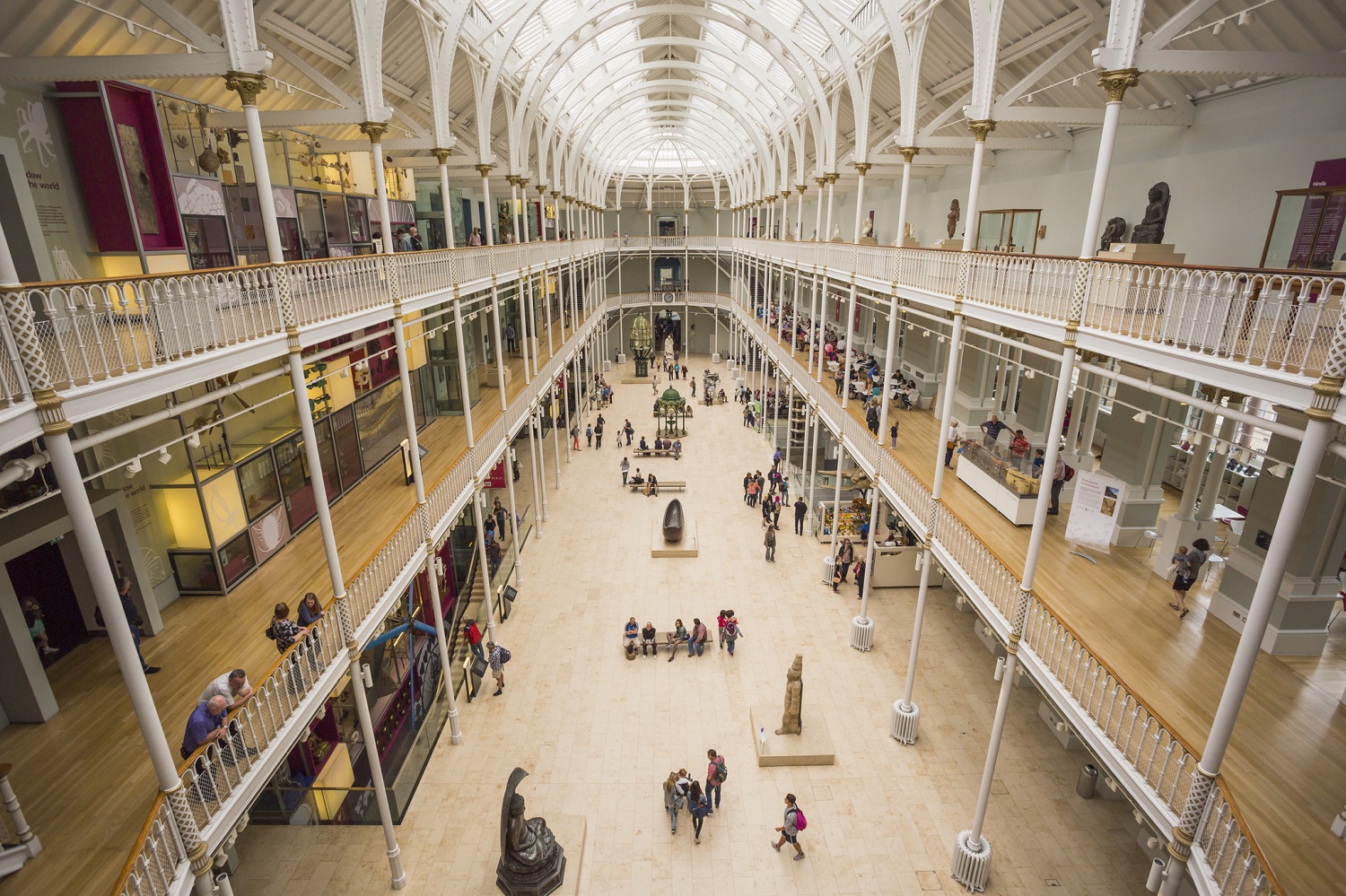
Top tourist attractions & places to visit in Scotland
Discover the best things to do in Scotland with our list of top 20 most visited tourist attractions.
Accommodation in Scotland
Find the perfect accommodation for your break to Scotland.

Events & Festivals in Scotland
There's something happening in Scotland right now that the whole family will love.
Plan an accessible break to Scotland
Our advisors within iCentres can help plan your trip around your accessibility needs, finding information on a range of topics including wheelchair access, public transport, ease of parking, free entry for carers and busy visiting times.
Accessible Holidays in Scotland
You’ll find a great range of accessible accommodation, attractions and things to see and do, whatever your requirements.

Accessible Accommodation in Scotland
Find the right accommodation to suit you, by searching our accessible options.
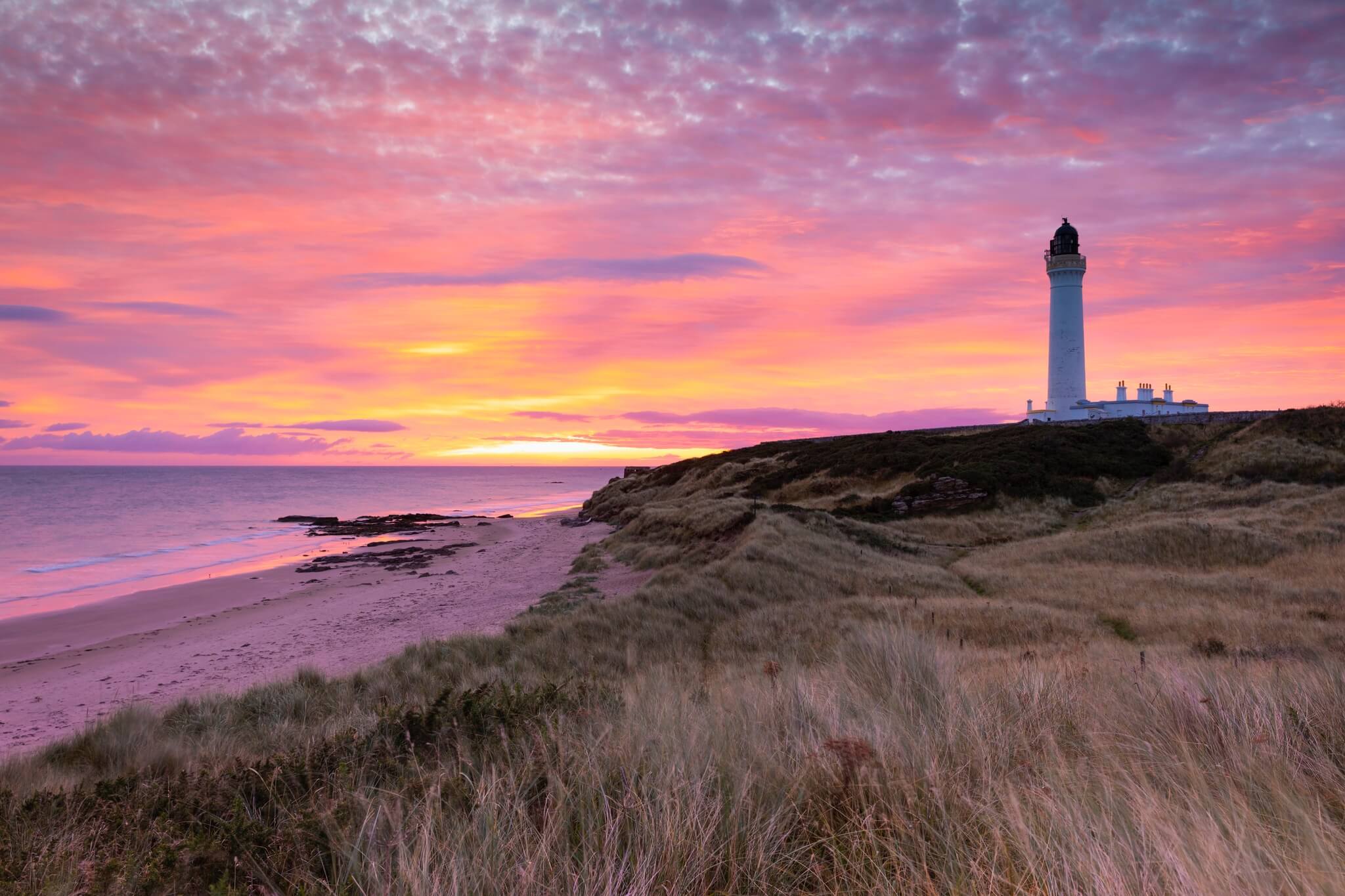
14 accessible accommodation ideas in Scotland
Discover some of the best accessible accommodation in Scotland, from Fife to Moray Speyside.
Find experiences
JavaScript needs to be enabled to see this product search form. You can turn this on in your browser settings.
Other things you might like
6 Great Day Trips From Edinburgh
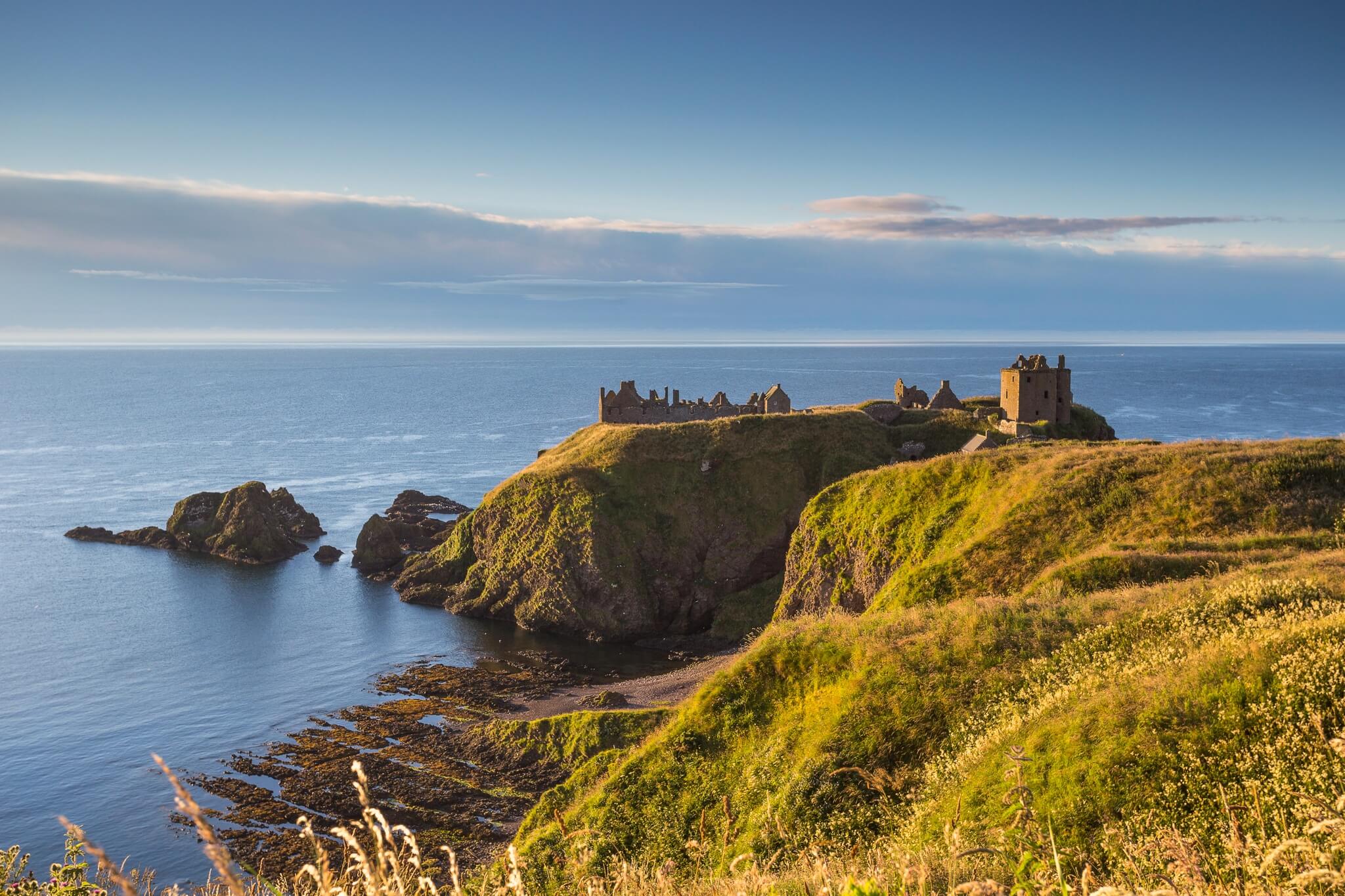
7 Days in the East of Scotland
Explore Scotland Via Bus & Coach Tours
Train Holidays in Scotland - Getting Around by Rail
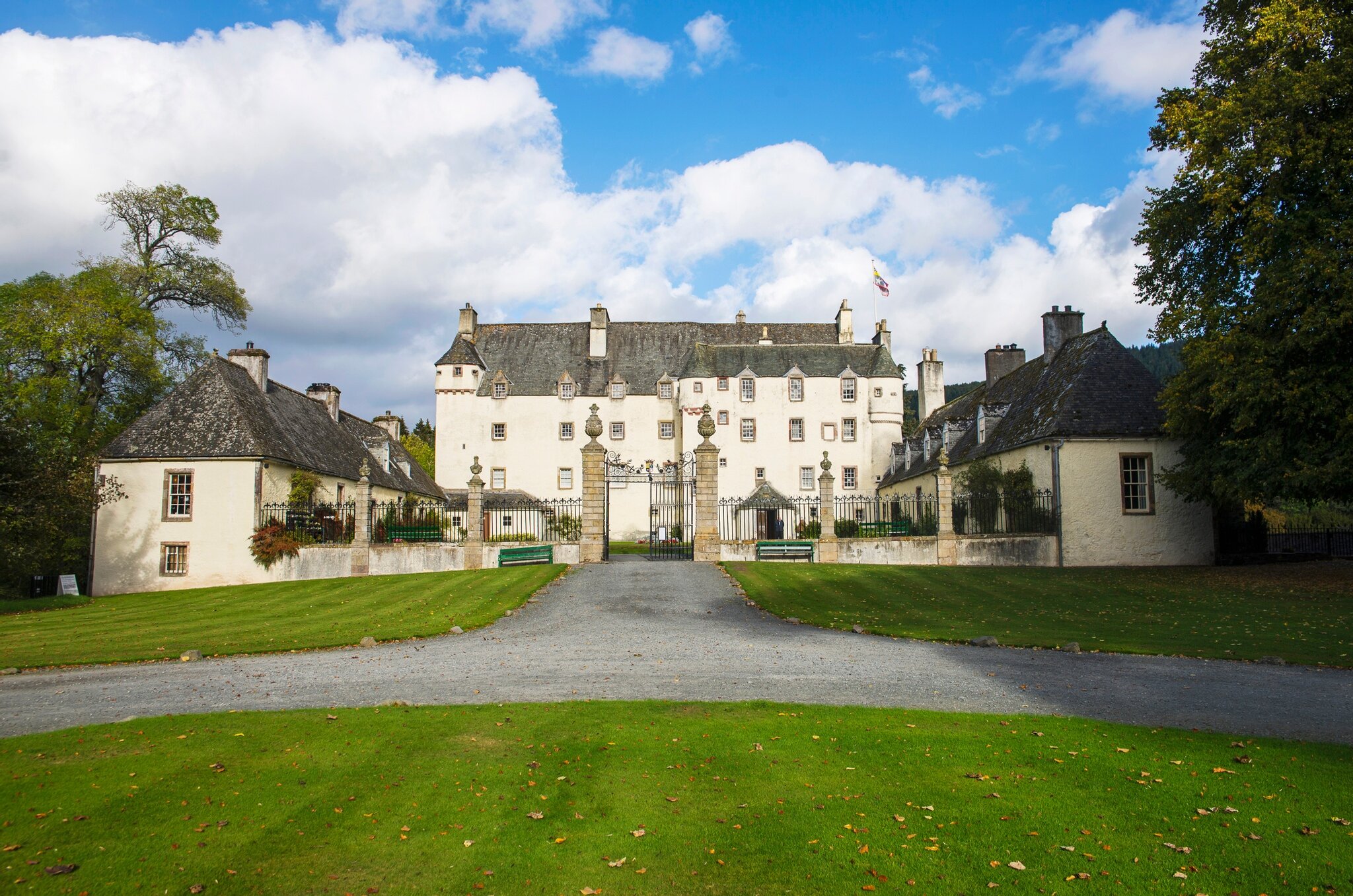
B&Bs & Guest Houses
Top tips for travelling to scotland.
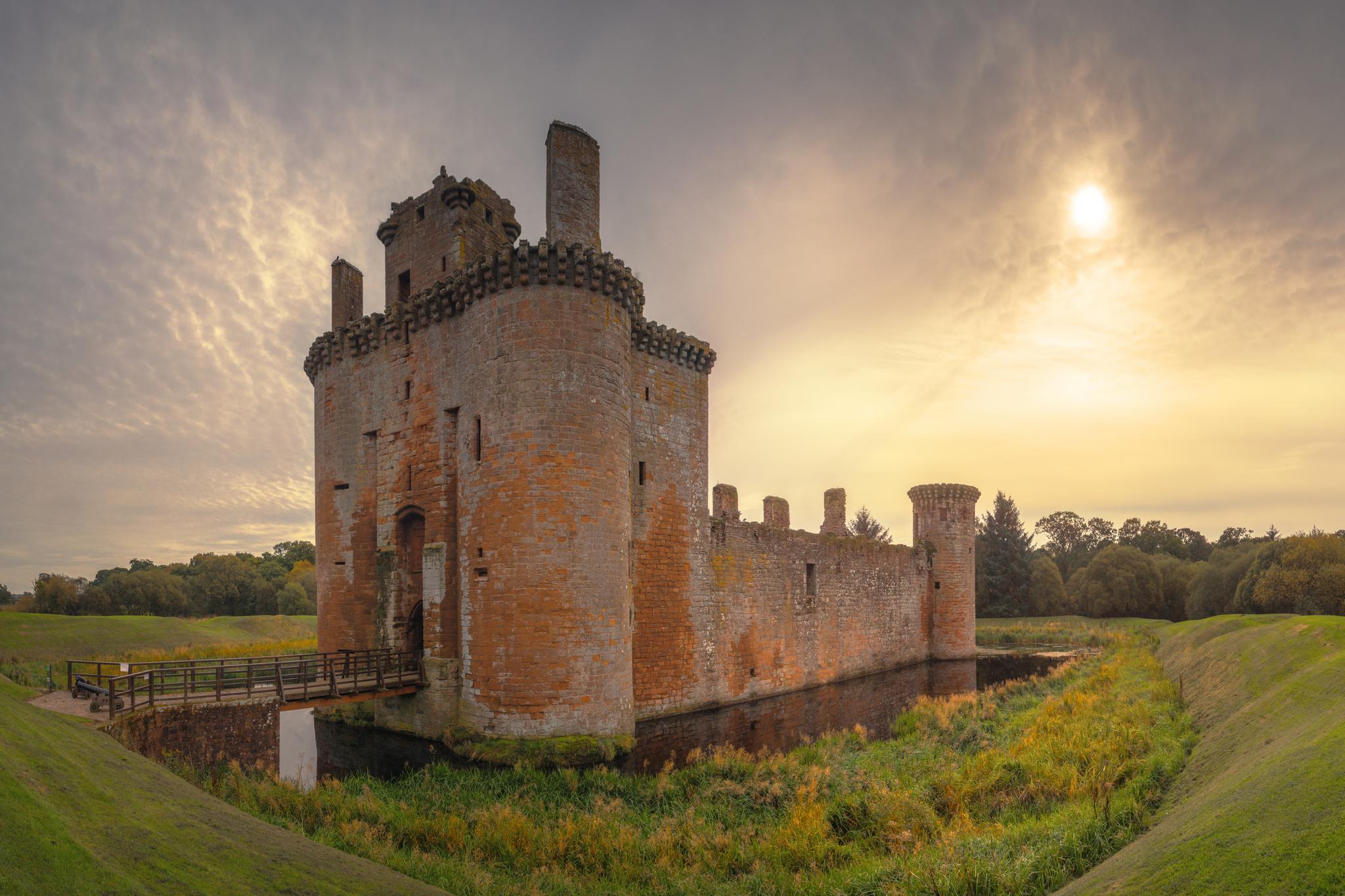
Passes & Offers for Holidays, Attractions & Travel in Scotland
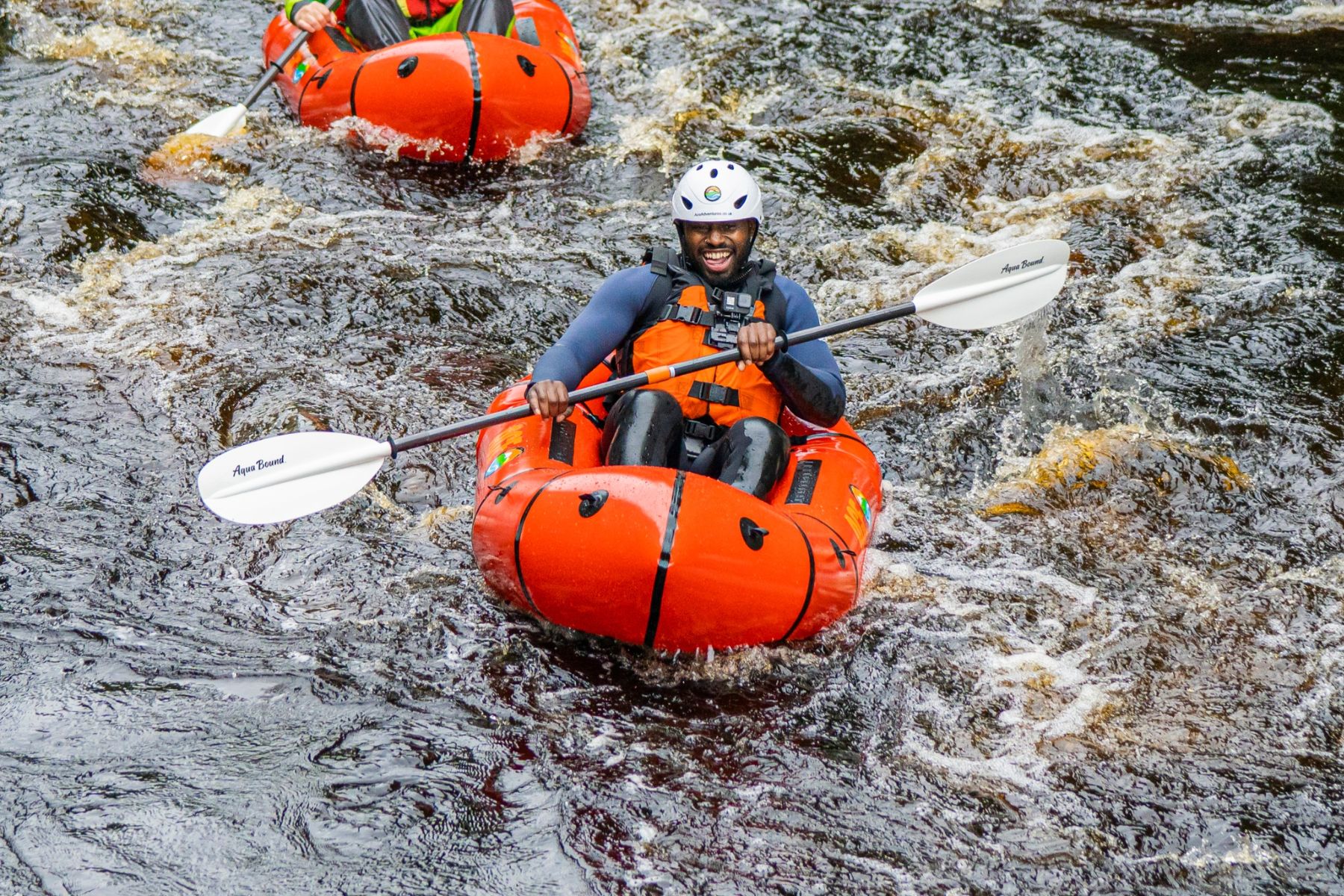
A Guide to Outdoor Safety in Scotland
Driving in Scotland FAQs
Scotland's Weather, Climate & Average Temperature
When is the best time to visit Scotland?
Passports, visas & customs
Join our newsletter clan.
Get Scotland inspiration direct to your inbox. Don't miss the inside track from our Scotland experts on exciting trip ideas, unique attractions and hidden gems loved by locals.
US State Secretary Blinken to travel to Saudi Arabia next week
- Medium Text

Sign up here.
Reporting By Lucia Mutikani and Eric Beech; Editing by David Gregorio and Deepa Babington
Our Standards: The Thomson Reuters Trust Principles. New Tab , opens new tab
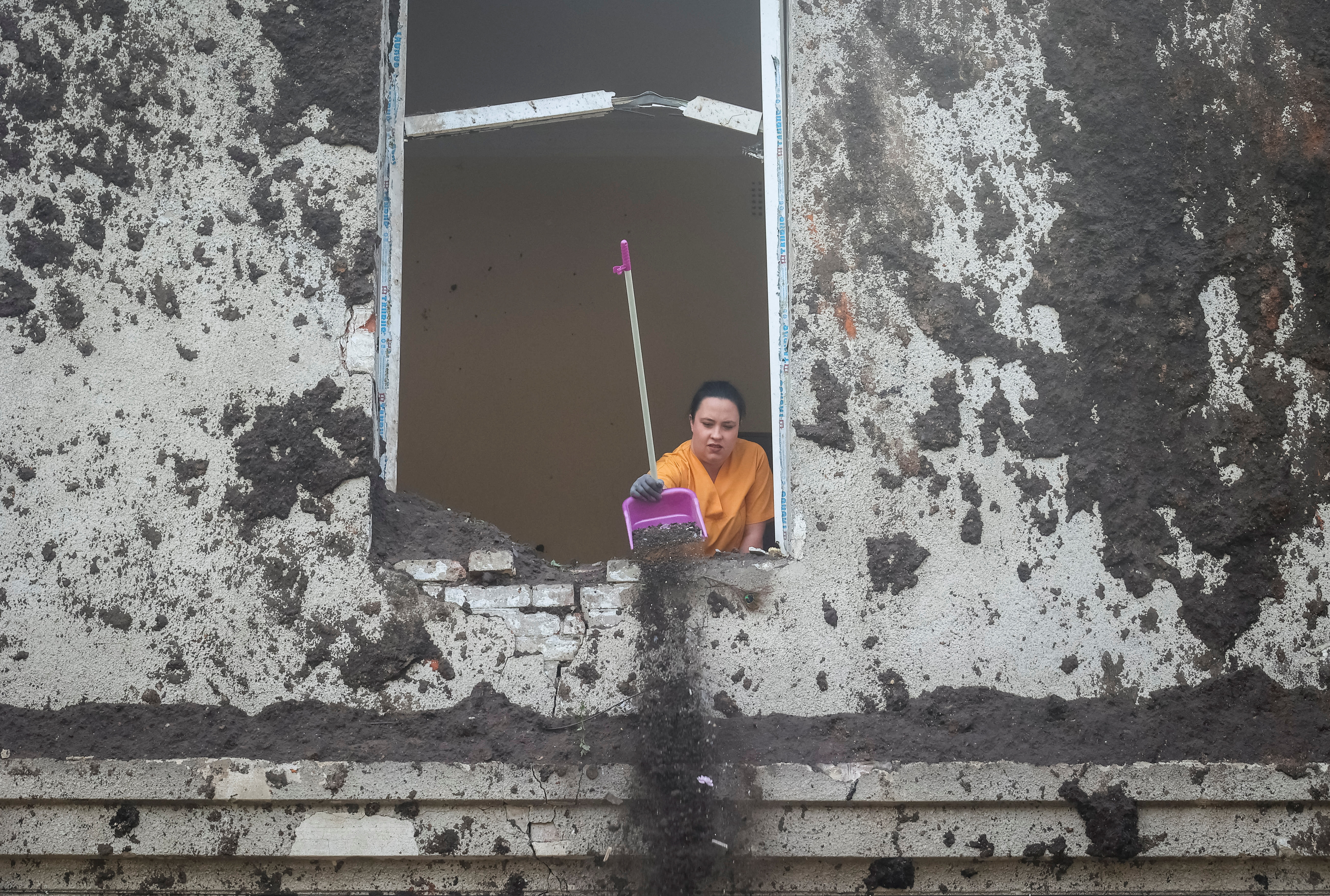
World Chevron

Iraq criminalises same-sex relationships with maximum 15 years in prison
Iraq's parliament passed a law criminalising same-sex relationships with a maximum 15-year prison sentence on Saturday, in a move it said aimed to uphold religious values but was condemned by rights advocates as the latest attack on the LGBT community in Iraq.


IMAGES
VIDEO
COMMENTS
An important Scotland travel tip to know is that you should expect clouds, rain, wind, sideways rain, fog, and the occasional sun even in the summer. In Scotland, the saying goes, " a dry day is a good day. " If you're coming to Scotland for a suntan, you may want to rebook your flights to Greece.
Don't buy the Scotland tourist outfit. One of the biggest Scotland travel tips is to avoid shopping at tacky souvenir shops that sell imported stuff. You'll find polyester tartan, cheap plastic toys, and a whole plethora of clichés. These shops are plentiful, especially on and around the Royal Mile in Edinburgh.
Welcome to Scotland. Scotland is a place of epic natural landscapes, engaging cities and rich cultural heritage. Start your adventure and discover our hidden gems to create memories with friends and family. But don't just take our word for it. National Geographic has just included Scotland in their Best of the World 2024 list, and Far North ...
Weather. When in Scotland, you need to be prepared for all sorts of weather no matter when you visit. During the summer months, the average temperatures are a high of 59-63°F (15-17°C) and lows are between 47-52°F (8-11°C). In the winter, temperatures drop to 41-45°F (5-7°C) with lows of 32-37°F (0-3°C).
9. Book ahead whenever possible. In any case, booking ahead for accommodation is always a good idea in Scotland. A lot of popular tourist places like Inverness are relatively small and don't have that many hotels compared to larger cities, so booking in advance is your best defense against eye-gouging prices.
To explore Scotland away from the crowds, travel south to the Borders and start with these eight spectacular stops. Read article. Things to Know. If you're looking to get the lowdown before visiting Scotland, start with these insider local tips. Read article. Transportation.
Jess Macdonald/Travel + Leisure. The clue is in its name: the Highlands are the mountainous upper half of Scotland, covering 10,000 square miles of picturesque scenery. The region's lively capital ...
Scotland Travel Guide: Money-Saving Tips. While Scotland is expensive, there are lots of ways to lower your costs. Here are some tips to help you save money in Scotland: Get the Edinburgh City Pass - If you're planning to explore Edinburgh, get the City Pass. For 45 GBP, you get access to 22 attractions as well as free transportation to and ...
3. North Coast 500. Best place for a scenic road trip. Breathtaking views abound in the Highlands, but the far north is where things become truly awe-inspiring. This is the best place in Scotland to explore by car (you can also cycle it), with some of the finest roadside scenery in Europe.
The Ultimate Scotland Itinerary. Venture across Scotland, exploring some of the most popular attractions and locations in this 14 day Ultimate Scotland Itinerary. From the well-known scenic landscapes, famed attractions, iconic monuments, and breathtaking locations that have made cameo appearances in TV and Films - Scotland is a must-visit ...
Wayward sheep and red deer might also take over the road. Patience is key, and a car or camper will get you to where you want to go faster - and more efficiently - than using Scotland's skeletal train and bus network. Or take your bike, inflatable kayak or canoe on a Scotrail service, now amped-up with more bike carriages and space for ...
The essential guide to visiting Scotland. ... Accommodation and attractions: The Green Tourism certification scheme, which now operates in 20 countries, was founded in Scotland. It assesses 70 ...
From wildlife-spotting family-friendly walks to paddleboarding along lochs or white-knuckle mountain biking routes, our outdoor activities are guaranteed to thrill all ages and abilities. Scottish Munros - Hill & Munro Bagging. 6 Incredible Bike Parks and Trail Centres in Scotland. 10 Top Golf Courses in Scotland.
Yeah, we have more than 460 museums and galleries. Of course, we have internationally-renowned, national performance companies. However, we're also an amazing hotbed of new and emerging music, home to one of the largest concert venues in the UK and have a well-earned reputation for putting on a party and having a great time. Learn more about ...
Your ultimate Scotland travel guide, with tips, and things to see and things to do in Scotland. Great for first-time and returning travelers. Found in the northern third of the United Kingdom is the great country of Scotland. Known for the warmth of its people, lush greenery and mountains, beautiful coastlines and beaches, medieval castles, and ...
This Scotland travel guide will detail unmissable destinations, popular tourist attractions, and lesser-known local spots. Below you can also find travel information on accommodation, getting around the country, money, safety, food, and entertainment.
2. Be sure to include at least ONE hidden gem in your itinerary. Some of my suggestions include South-West Scotland, the Scottish Borders, the Cowal Peninsula, an island that isn't the Isle of Skye, the Moray coast, and Aberdeenshire. The Peebles Cross Kirk in the Scottish Borders. 3.
Packing + Adventure Tips For Scotland Travel 9 | Use every opportunity to exercise Scotland's 'Right to Roam' law, but be respectful of the land and clean up after yourself. Back in 2003, Scotland passed its 'Right to Roam' law that allows both tourists and locals to enjoy Scotland's land and waters no matter who owns them.
Read more: 50 Travel Tips For Scotland. They also have free cancellation up to 24 hours before your activity in case your plans change, and 24/7 customer service. I also like Get Your Guide because ticket prices are the same as purchasing direct but you can keep all your tours and activities in one place on the app. Passes that will save you money
Rugged, colorful, and feisty, Scotland stands apart. From its stony architecture to its striking landscape to its charming people — and their peculiar fondness for haggis — this little land packs a big punch. A proud identity unites the sparsely populated country, which boasts misty glens, brooding castles, windswept moors, peaty whisky, and Celtic ambience. Its leading cities, Edinburgh ...
Inverness and Aberdeen airports are well-located if your itinerary focuses on the north-west or the north-east respectively. 22. Listen to Wild for Scotland. Listen to my immersive travel podcast Wild for Scotland to see which regions resonate with you - then follow my travel tips to plan your itinerary.
Visit Scotland said the move reflects a change in the ways people get their information, after a 42 percent decline in visitorship to the iCentres since the pre-Covid era.
An idyllic 453-acre private island is up for sale off the west coast of Scotland and it comes with sandy beaches, puffins galore, seven houses, a pub, a helipad and a flock of black-faced sheep.
In general terms, the rules make it difficult to force an early election that could drive the S.N.P. out of government in Scotland. For now, the collapse of the coalition means that Mr. Yousaf ...
An epic tourist attraction amidst Scotland's stunning landscapes built to honour the fallen Jacobite clansmen, the Glenfinnan Monument overlooks Loch Shiel and is backed by the world-renowned Glenfinnan Viaduct. Learn more about this turbulent time in Scotland's past and the kilted Highlander who stands on top of the monument.
Scotland's Health Minister Humza Yousaf, a contender to become the leader of the Scottish National Party (SNP) and Scotland's First Minister, speaks as he attends the SNP leadership hustings, in ...
Scotland's National Health Service has stopped all new prescriptions of puberty-blocking drugs and other hormone treatments for minors, citing a sweeping review of youth gender services released ...
A British tourist is in intensive care in Trinidad and Tobago after reportedly losing an arm and a leg in a shark attack. The man was named by local authorities as Peter Smith, 64, of Berkhamsted ...
Get local recommendations and top tips. Book tickets for tours, visitor attractions, public transport and get assistance planning your itinerary, helping you enjoy your time in Scotland responsibly. Get discounts and passes to tours and events. Find information on accessibility and key events and festivals.
Item 1 of 2 U.S. Secretary of State Antony Blinken gestures, as he and his wife Evan Ryan board a plane at the U.S. Naval Support Activity base, after the G7 foreign ministers summit on Capri ...